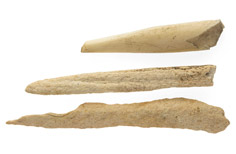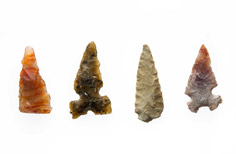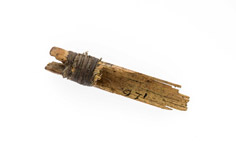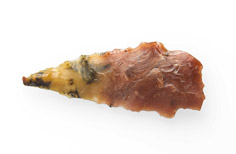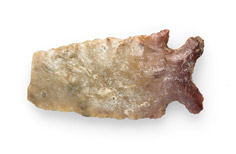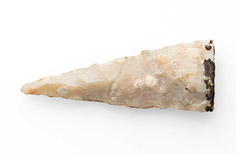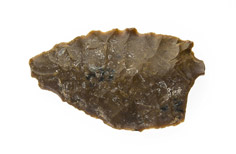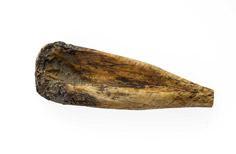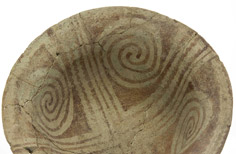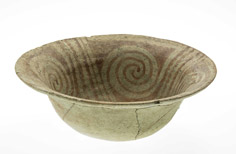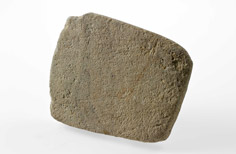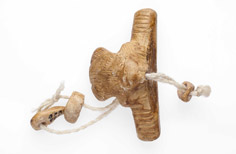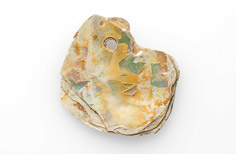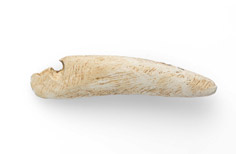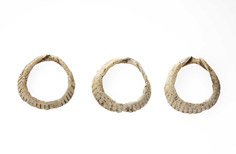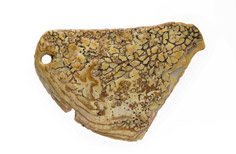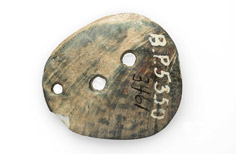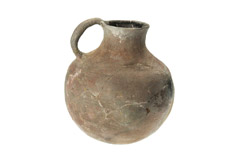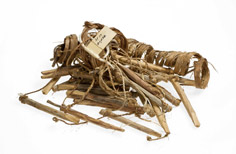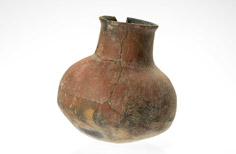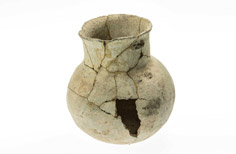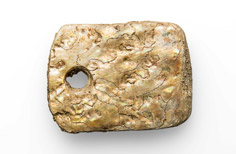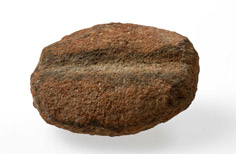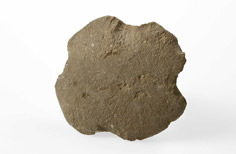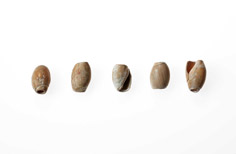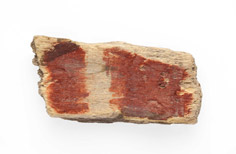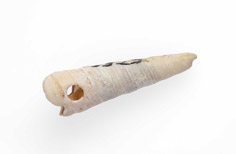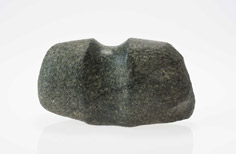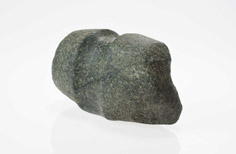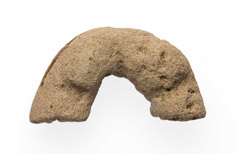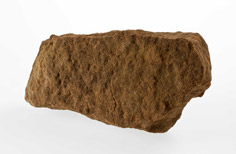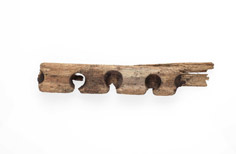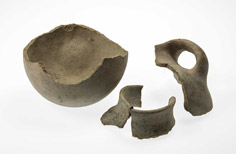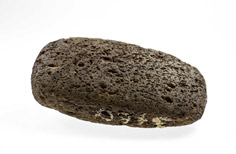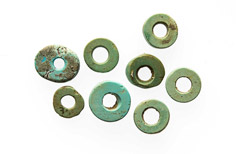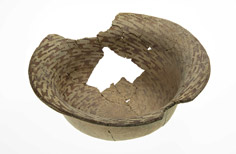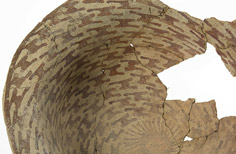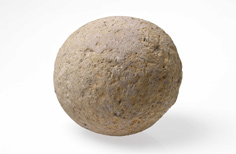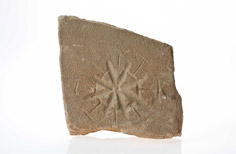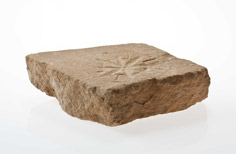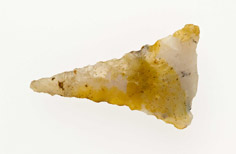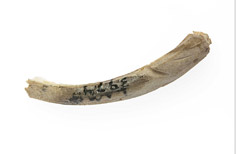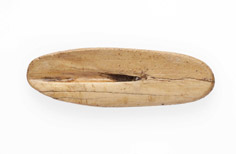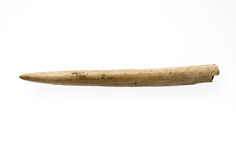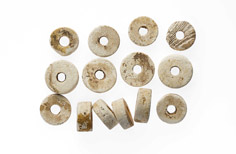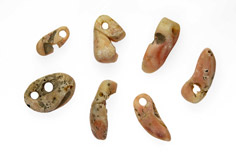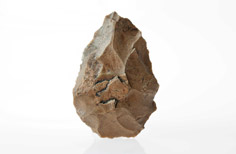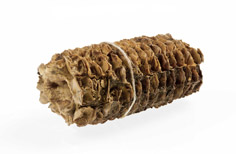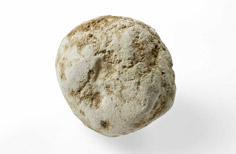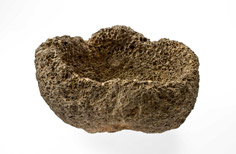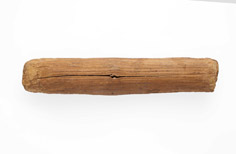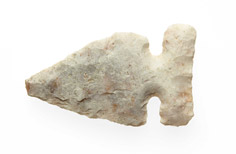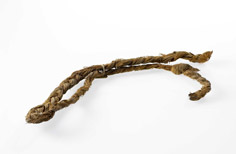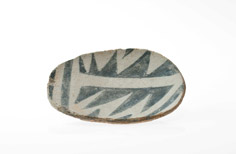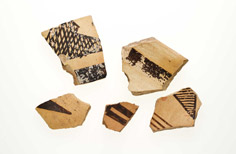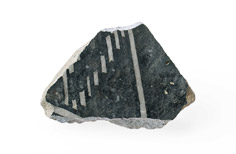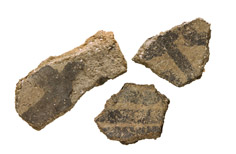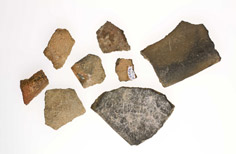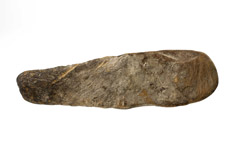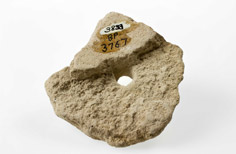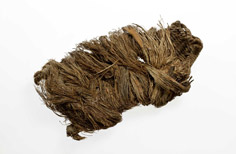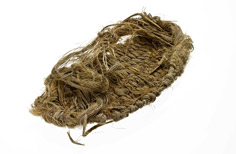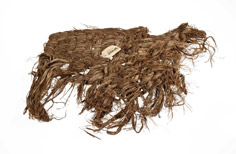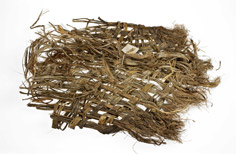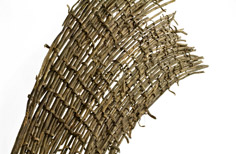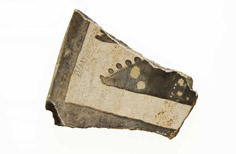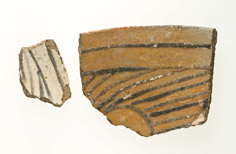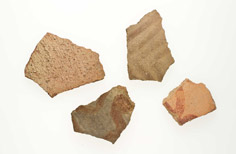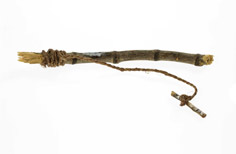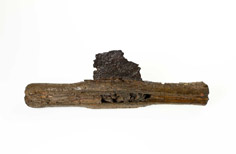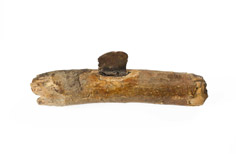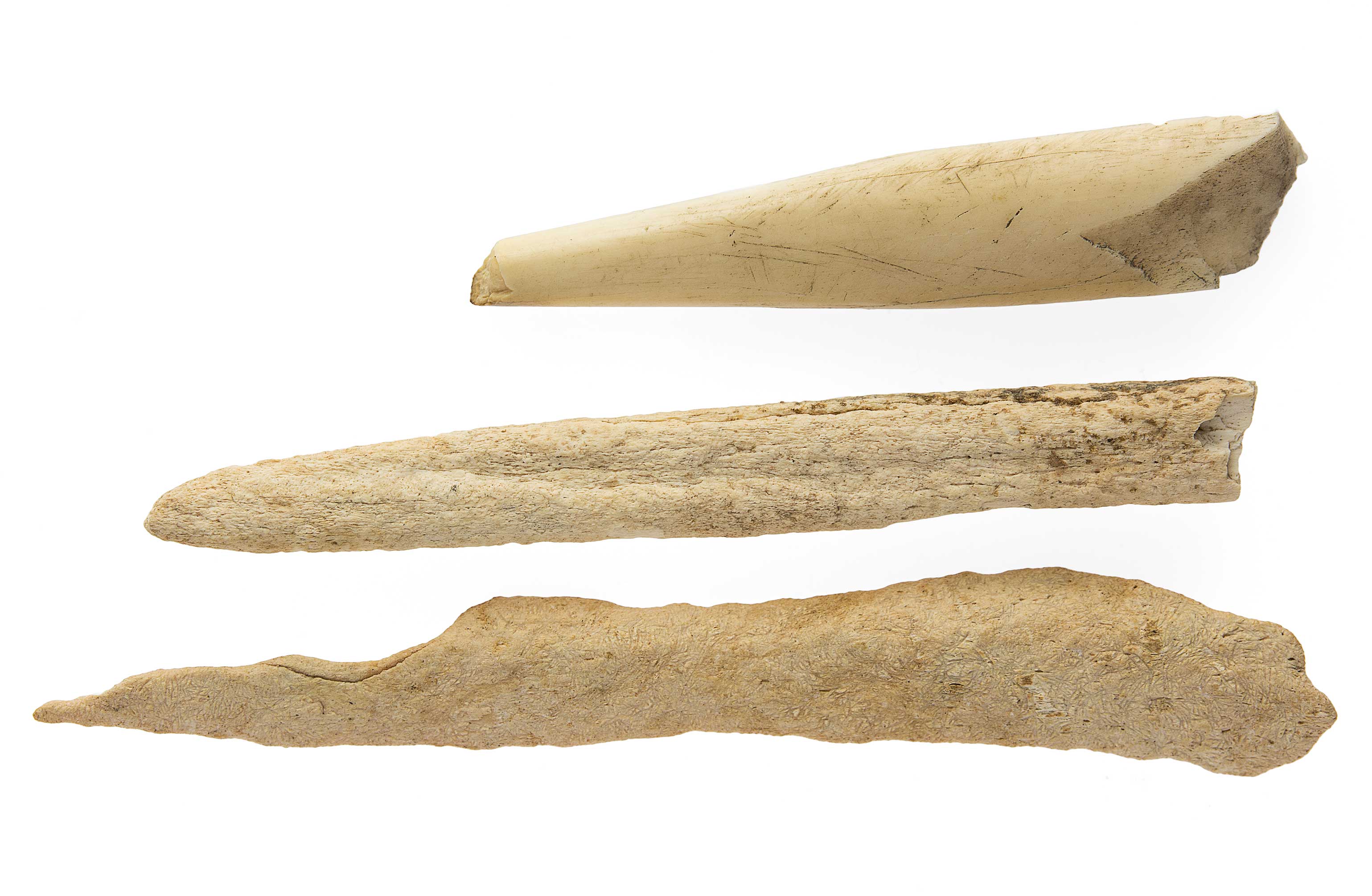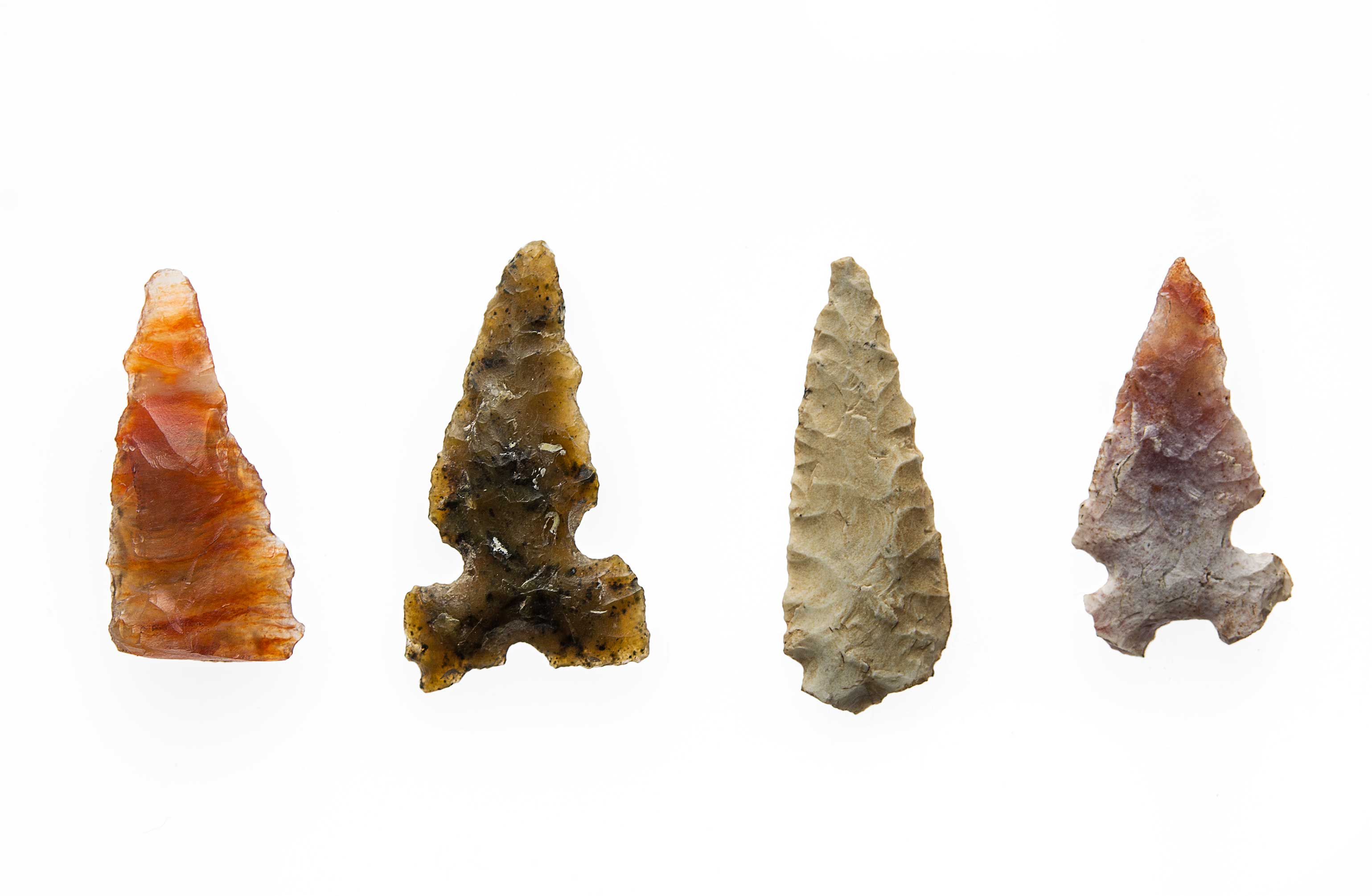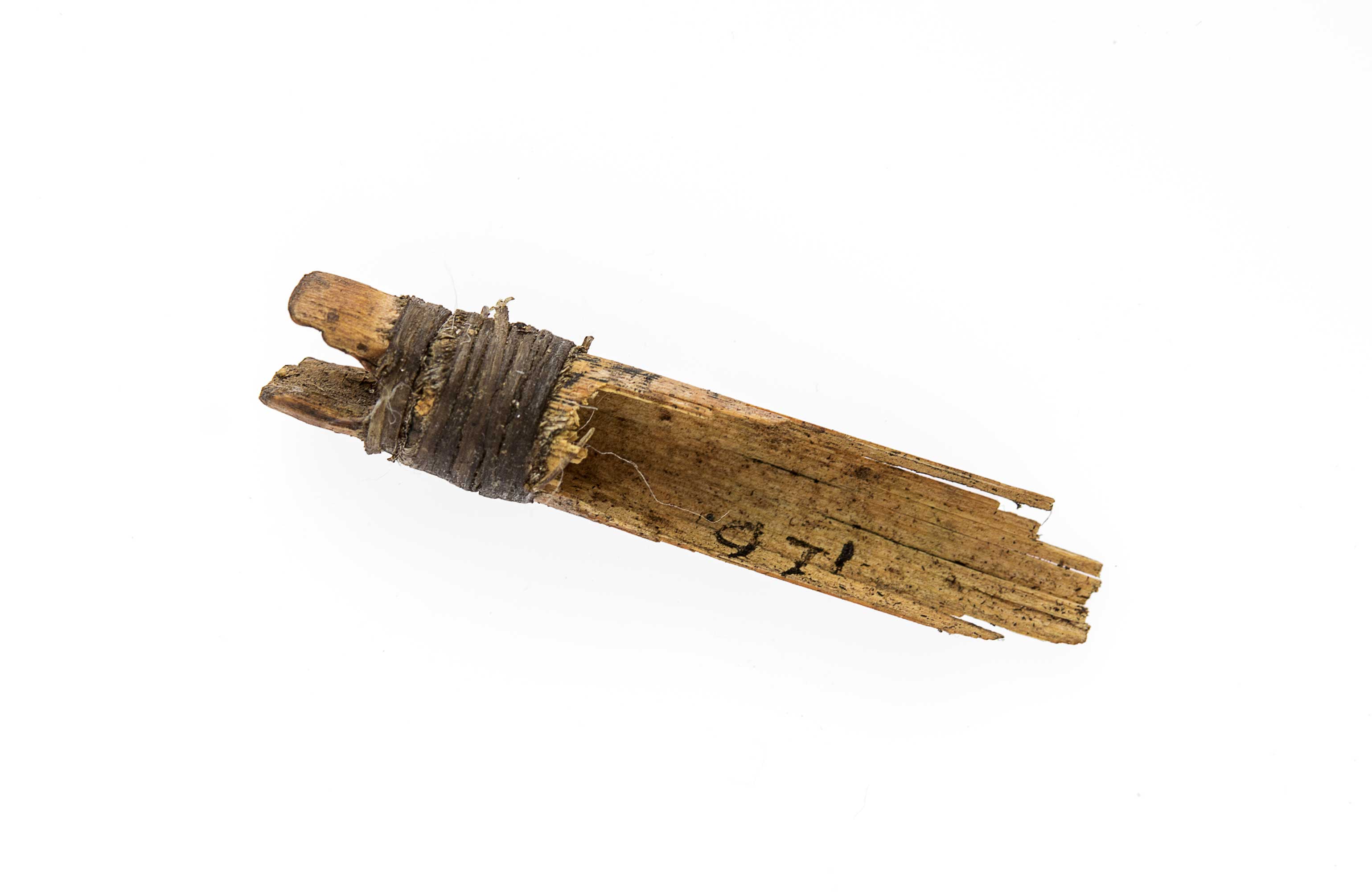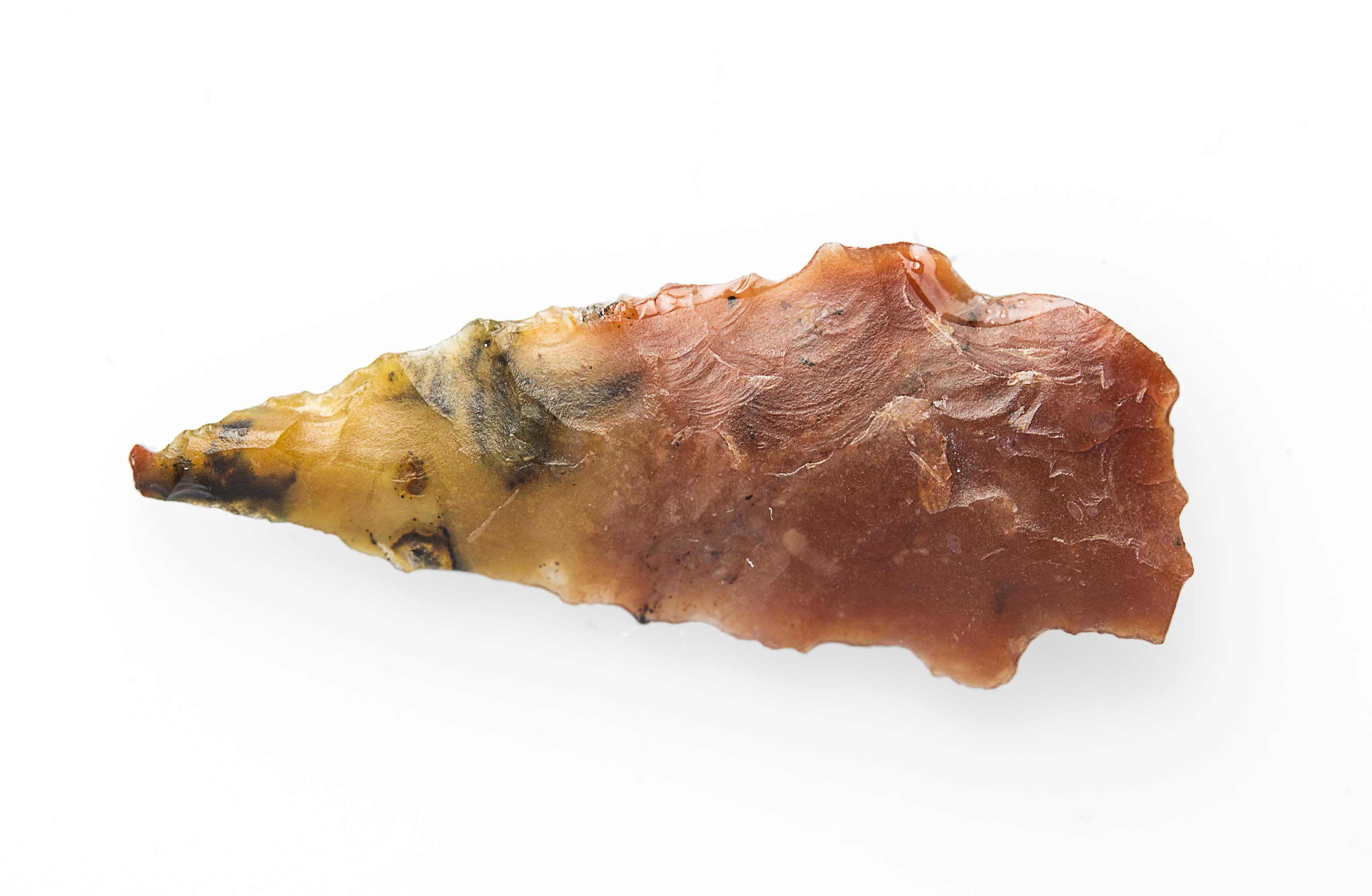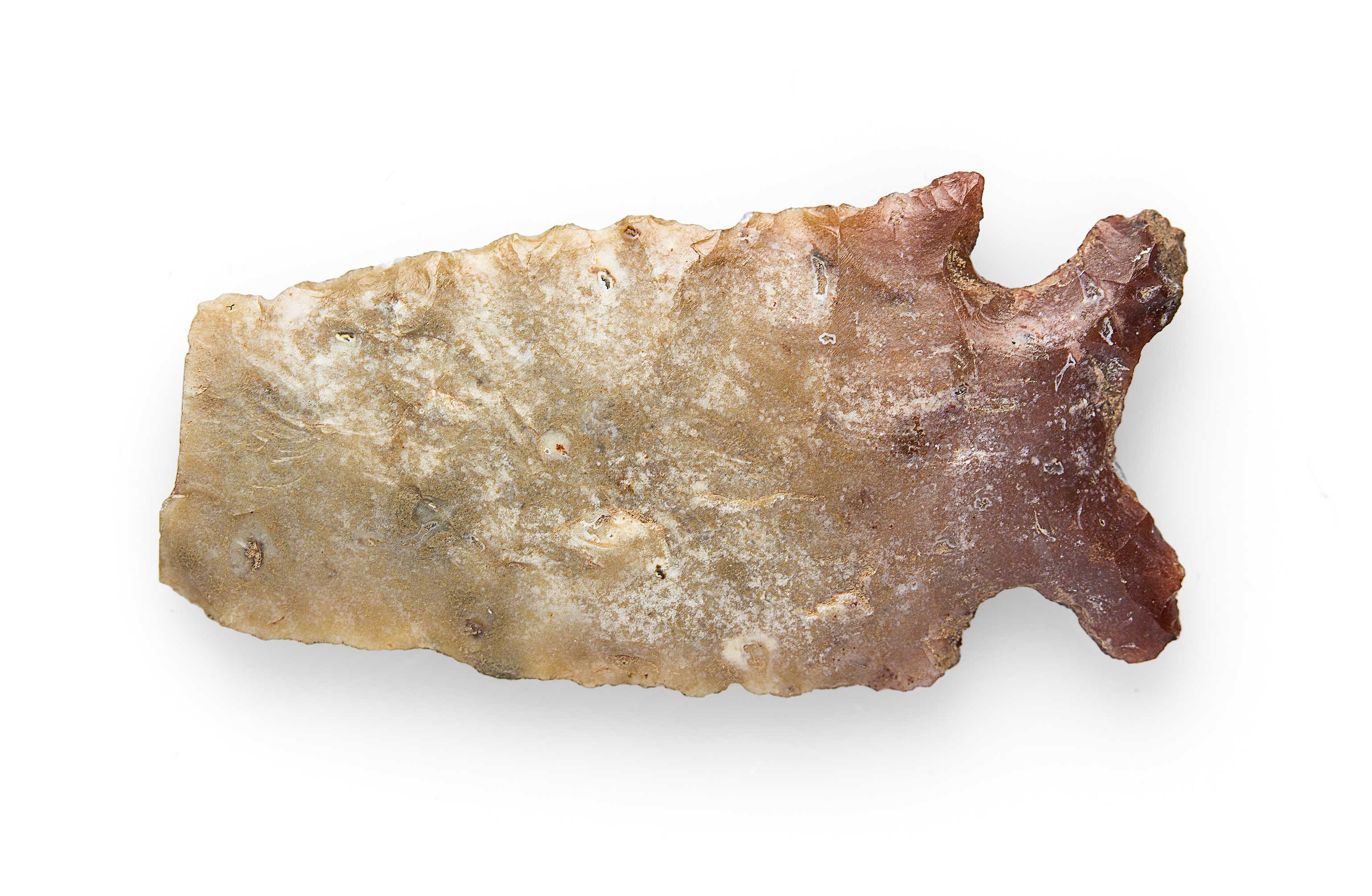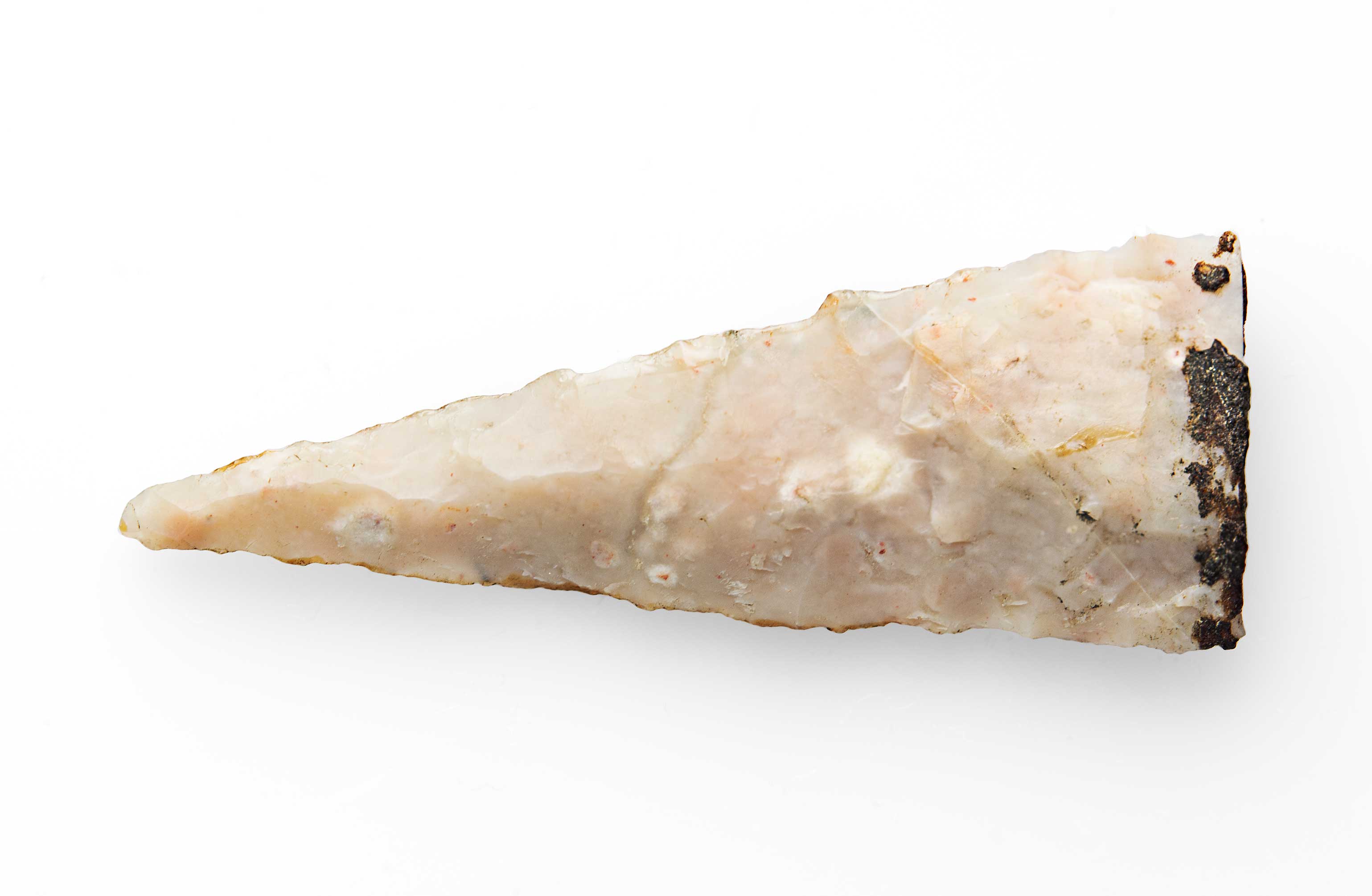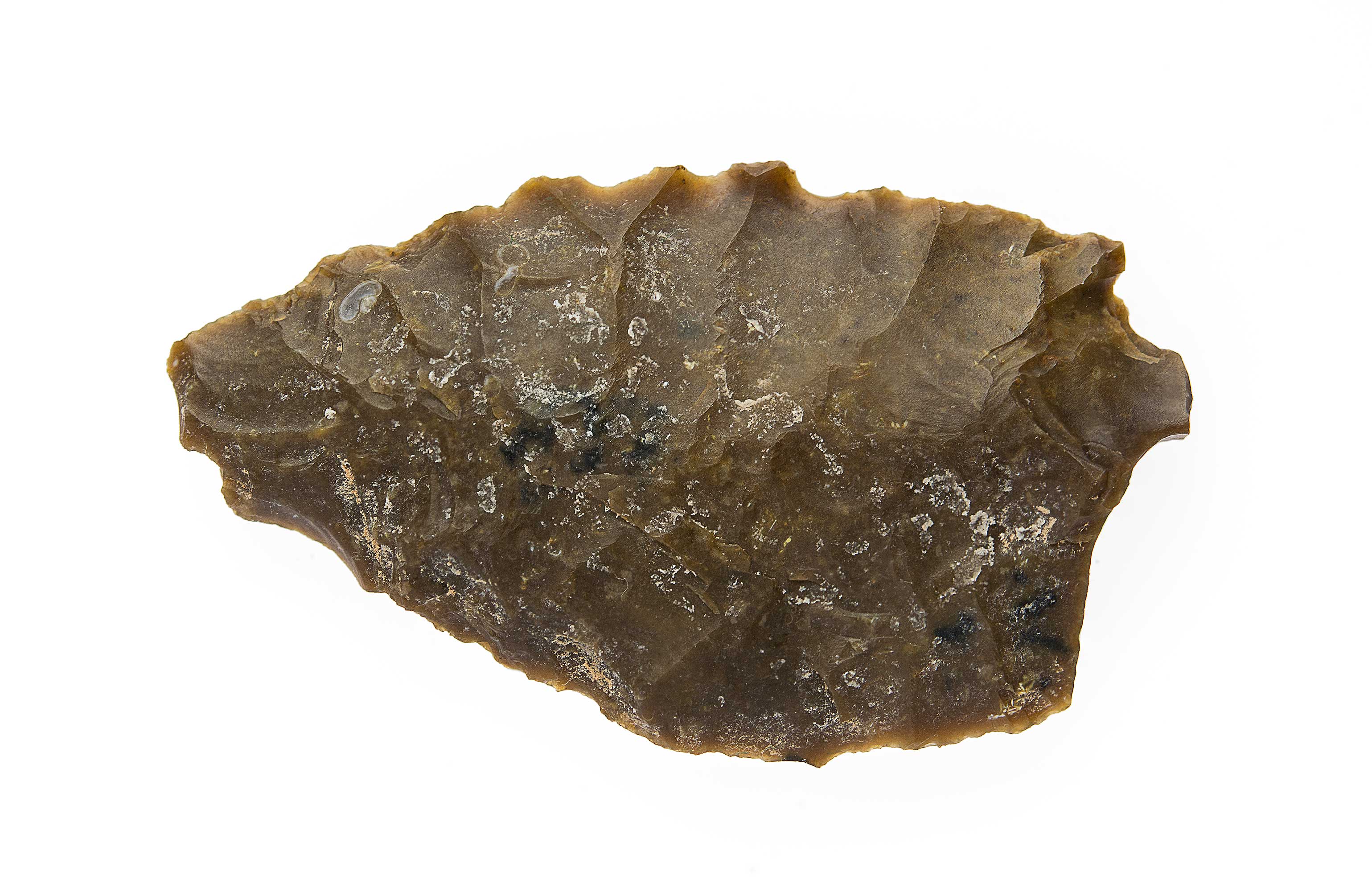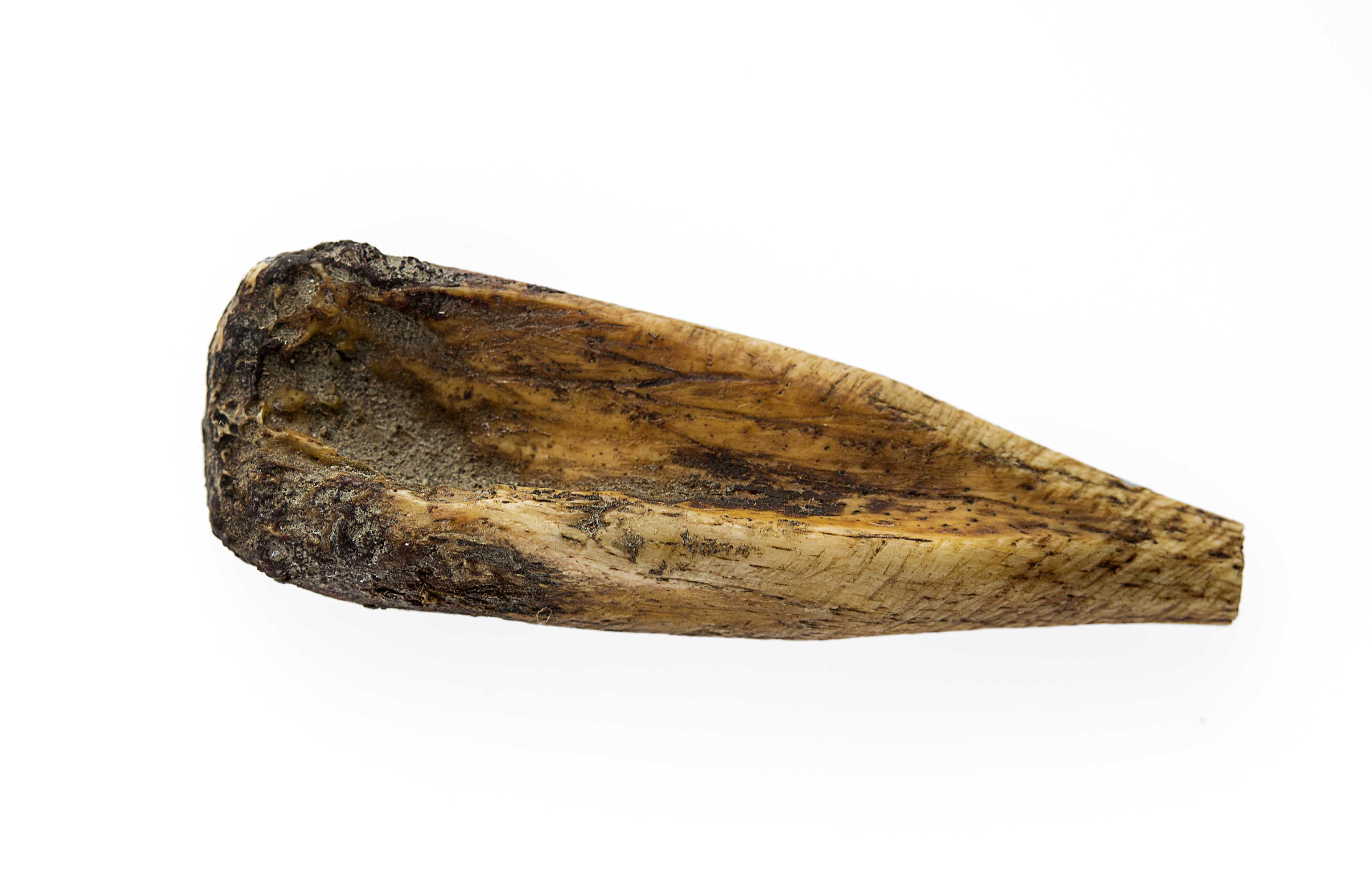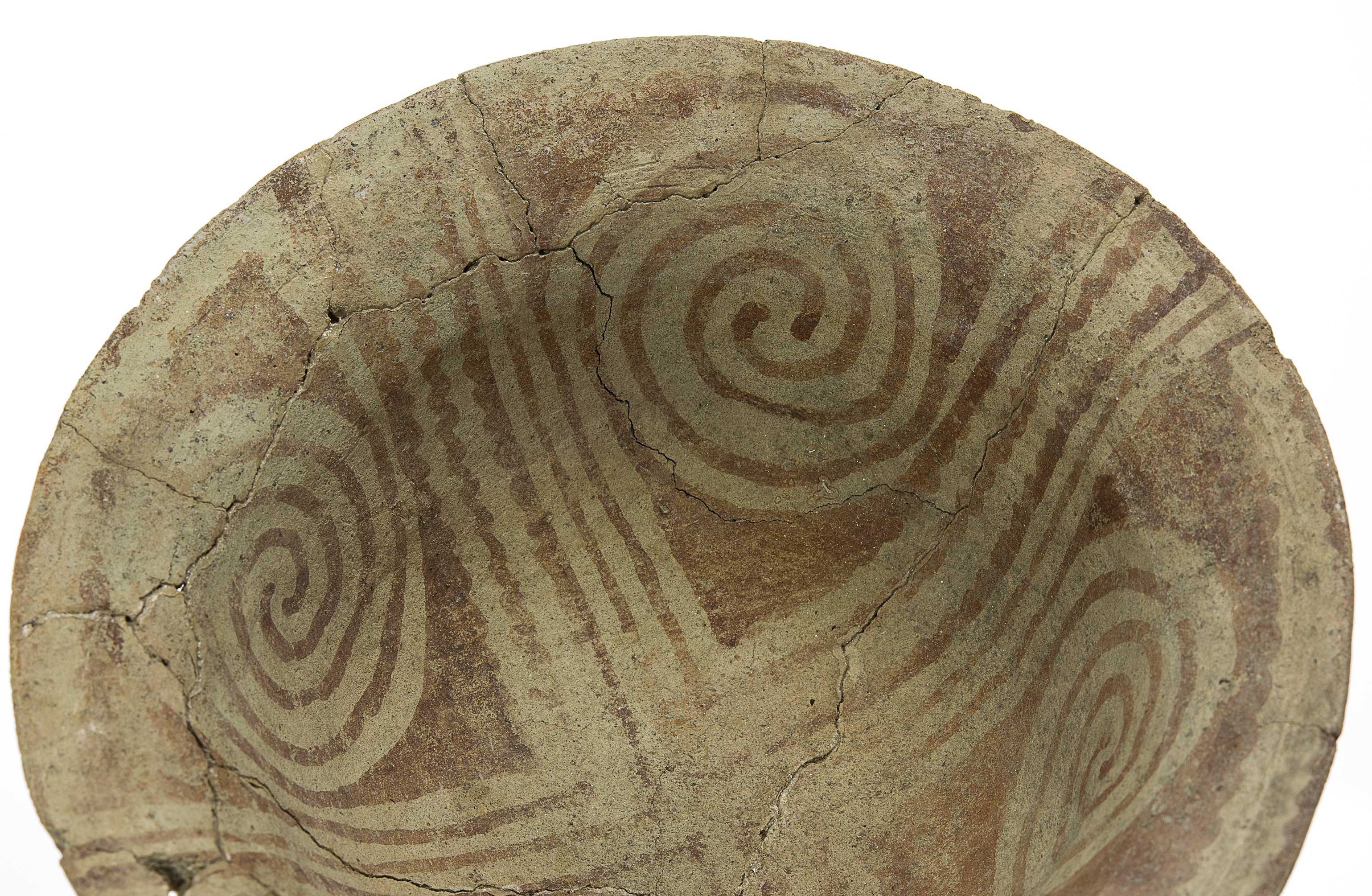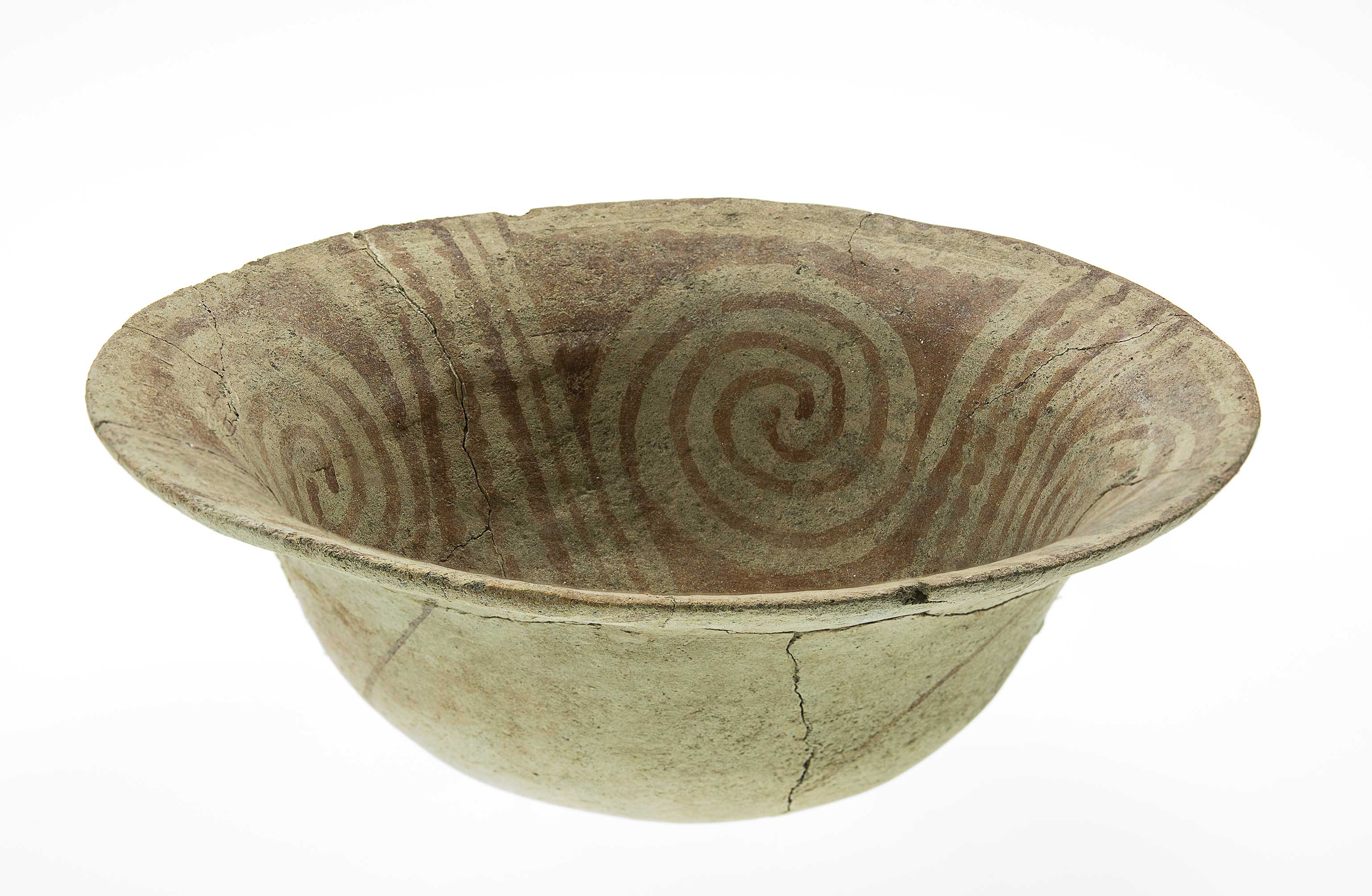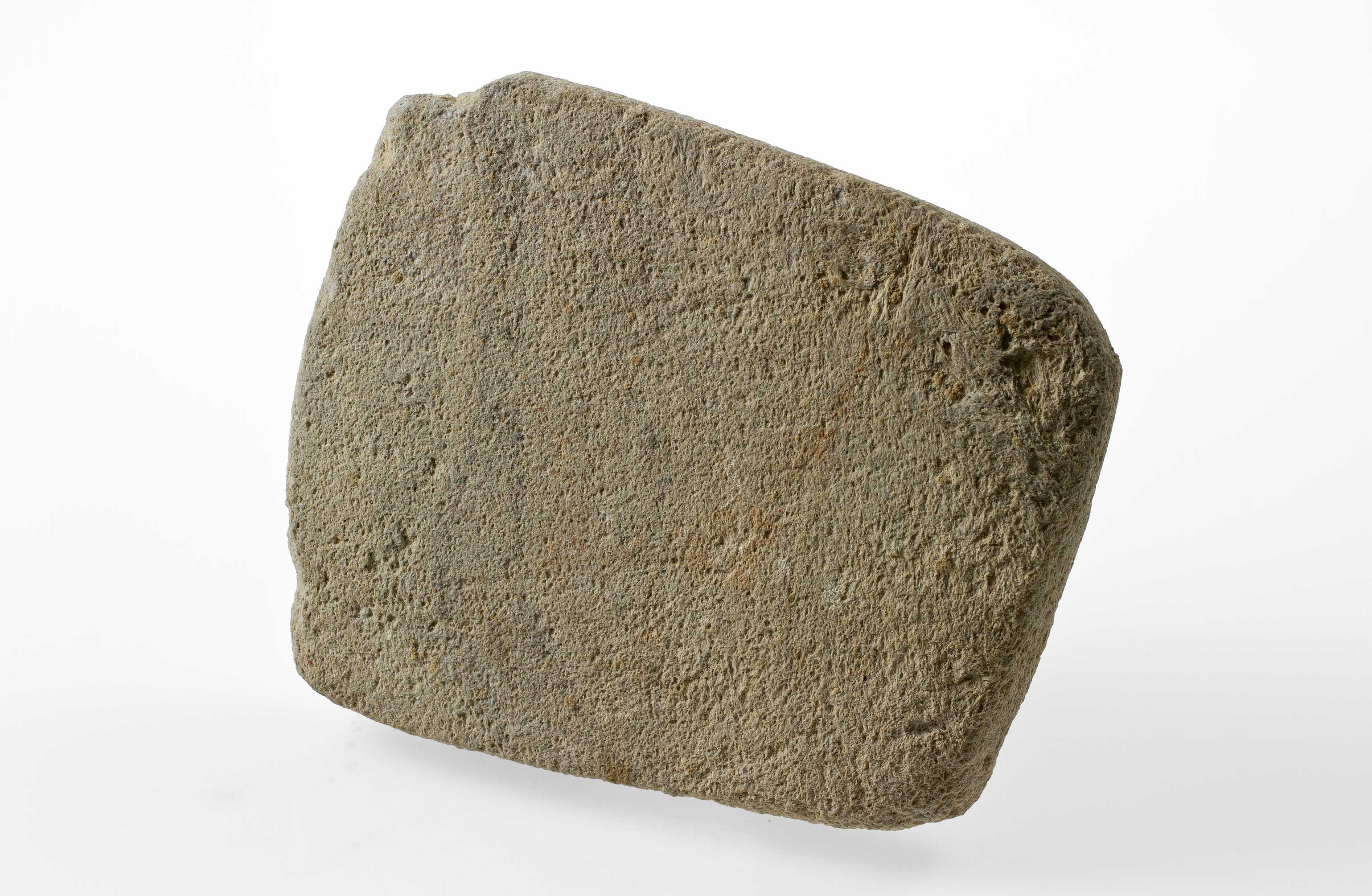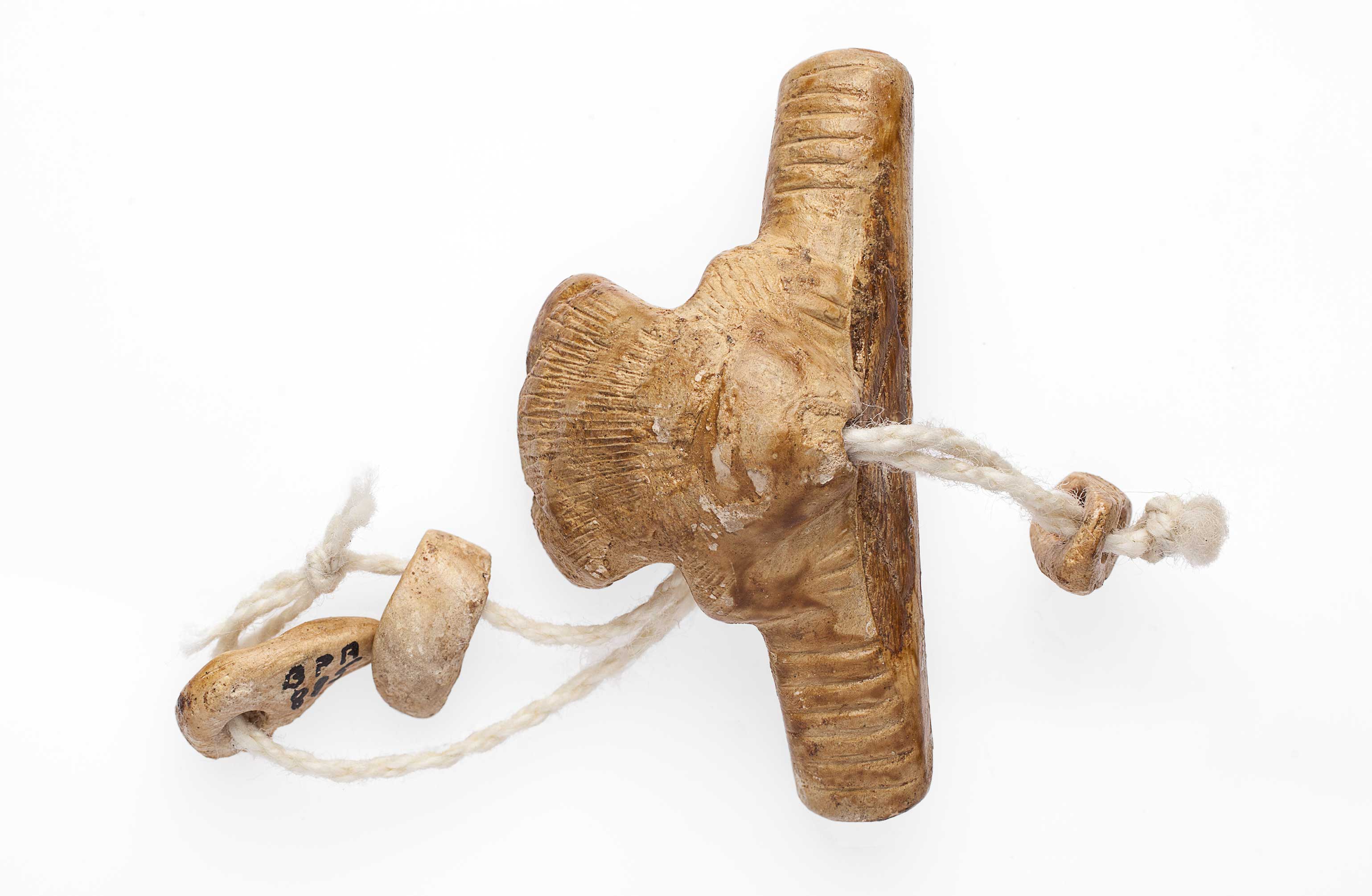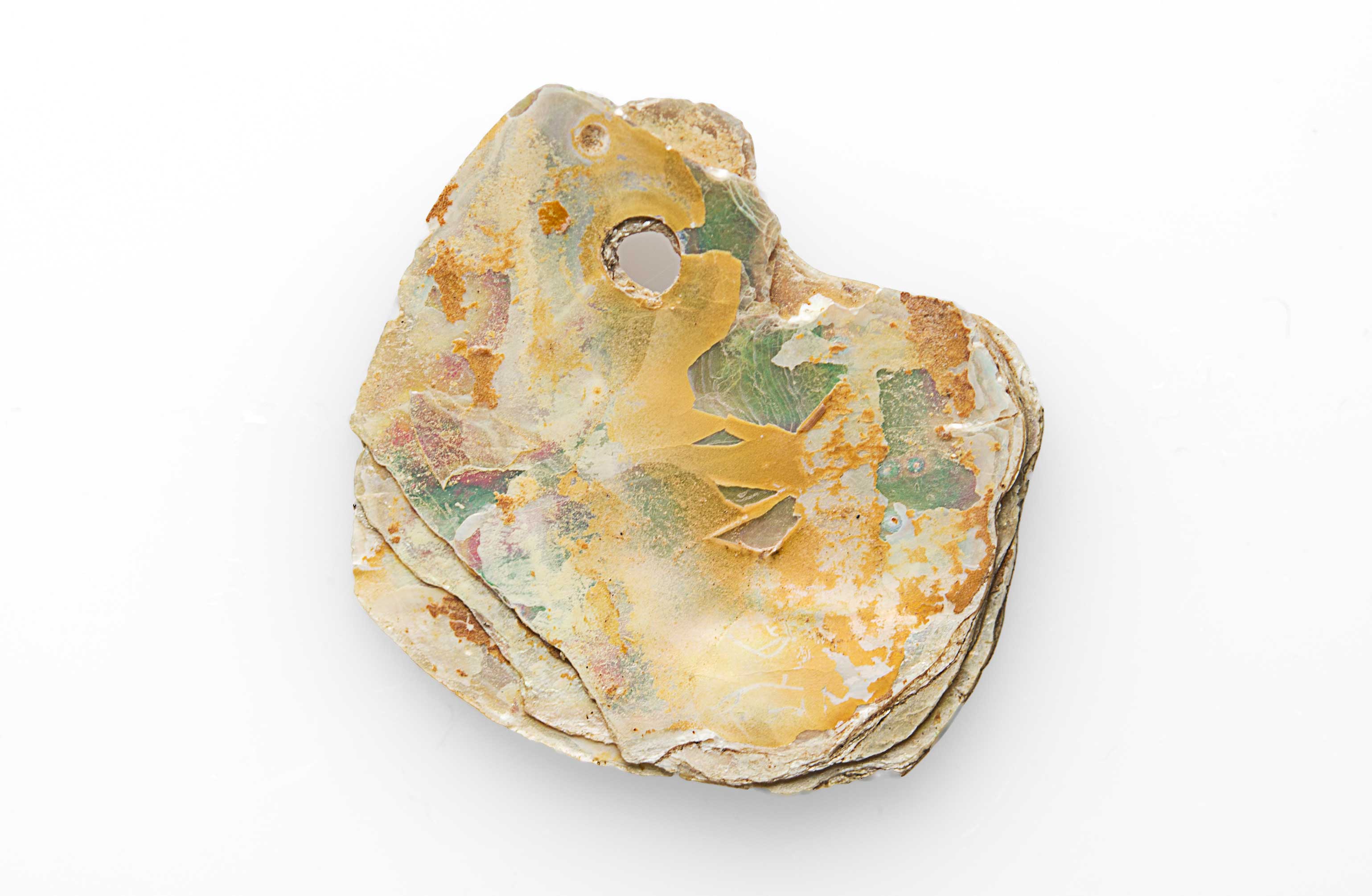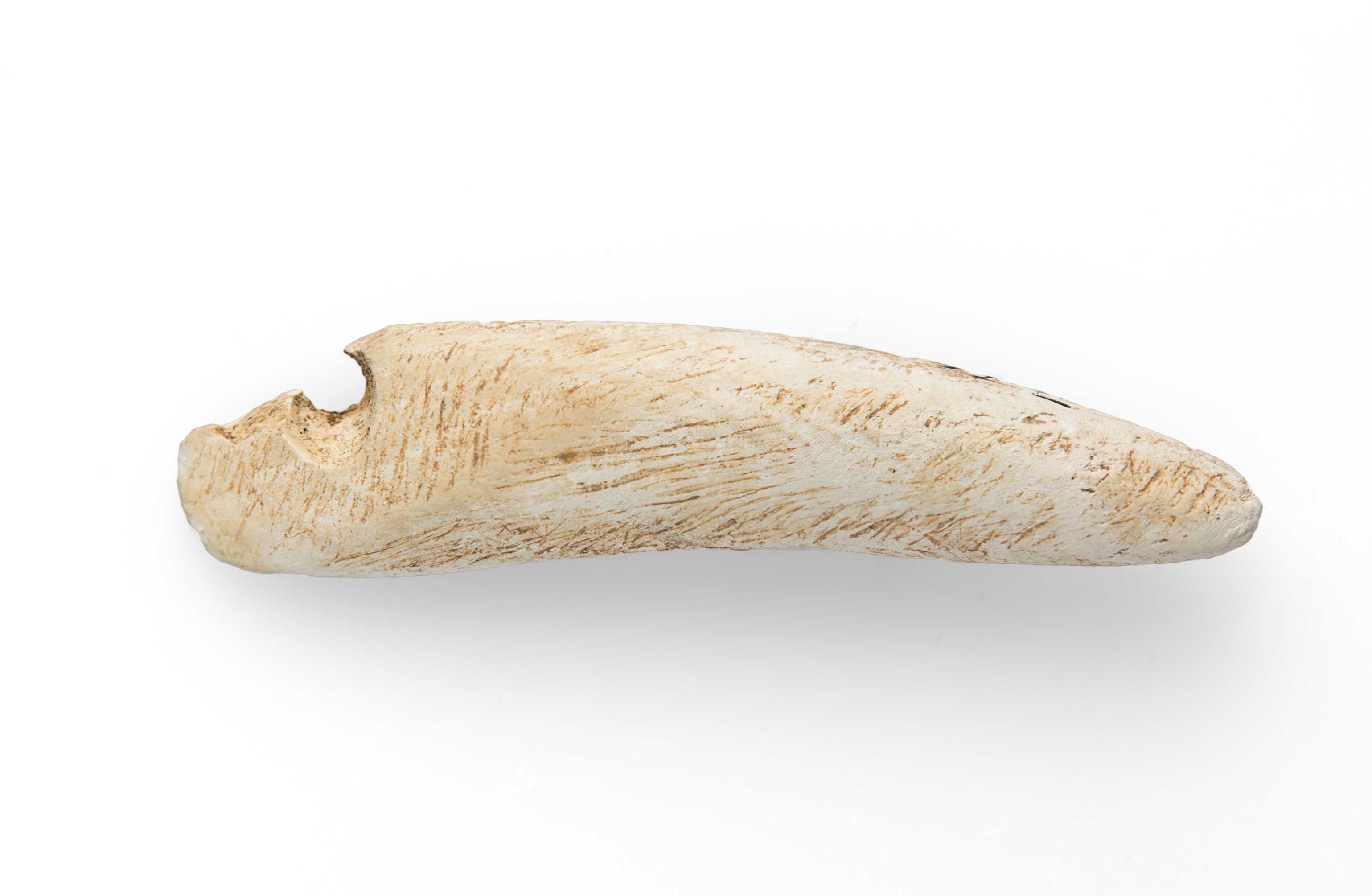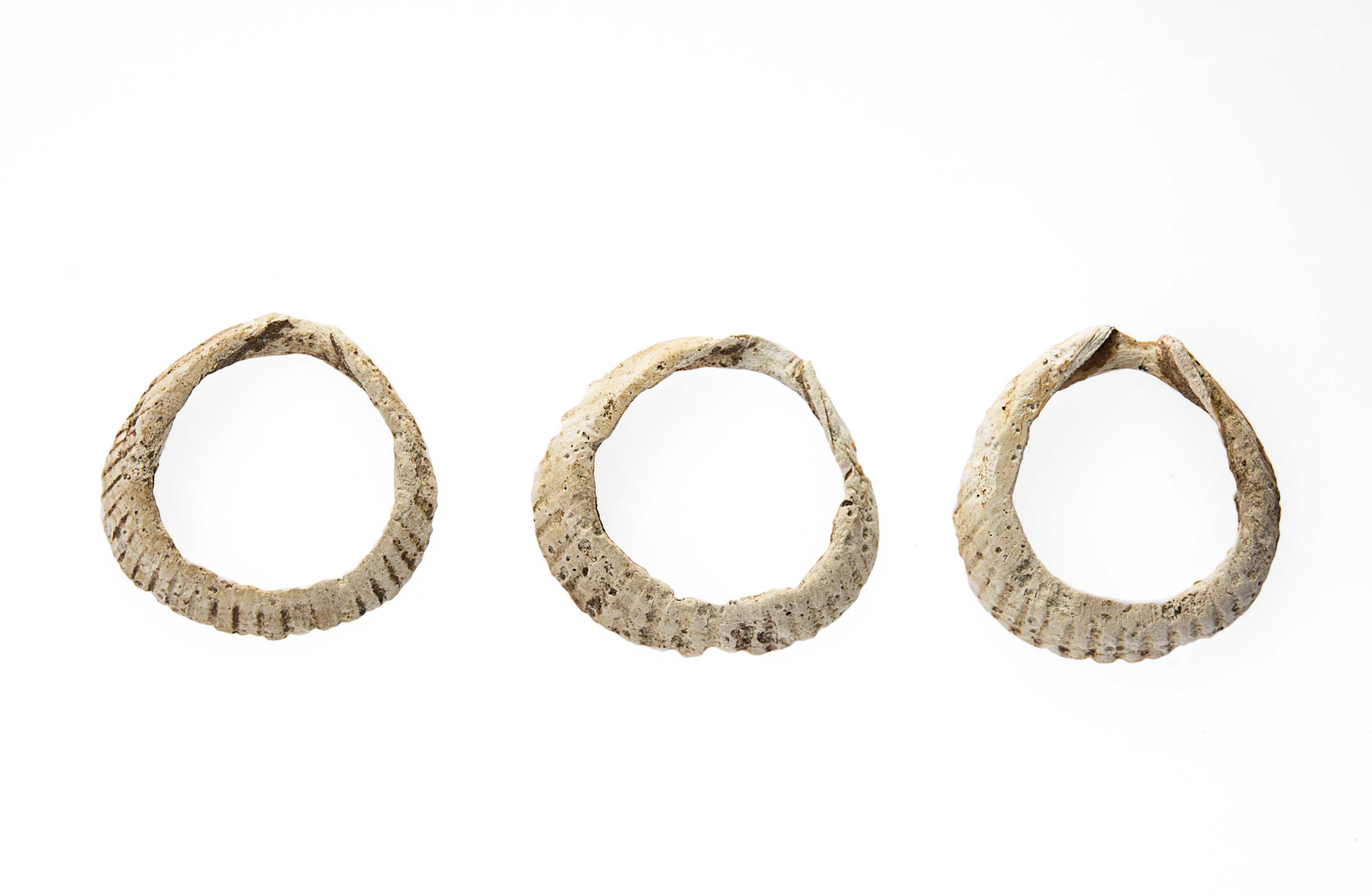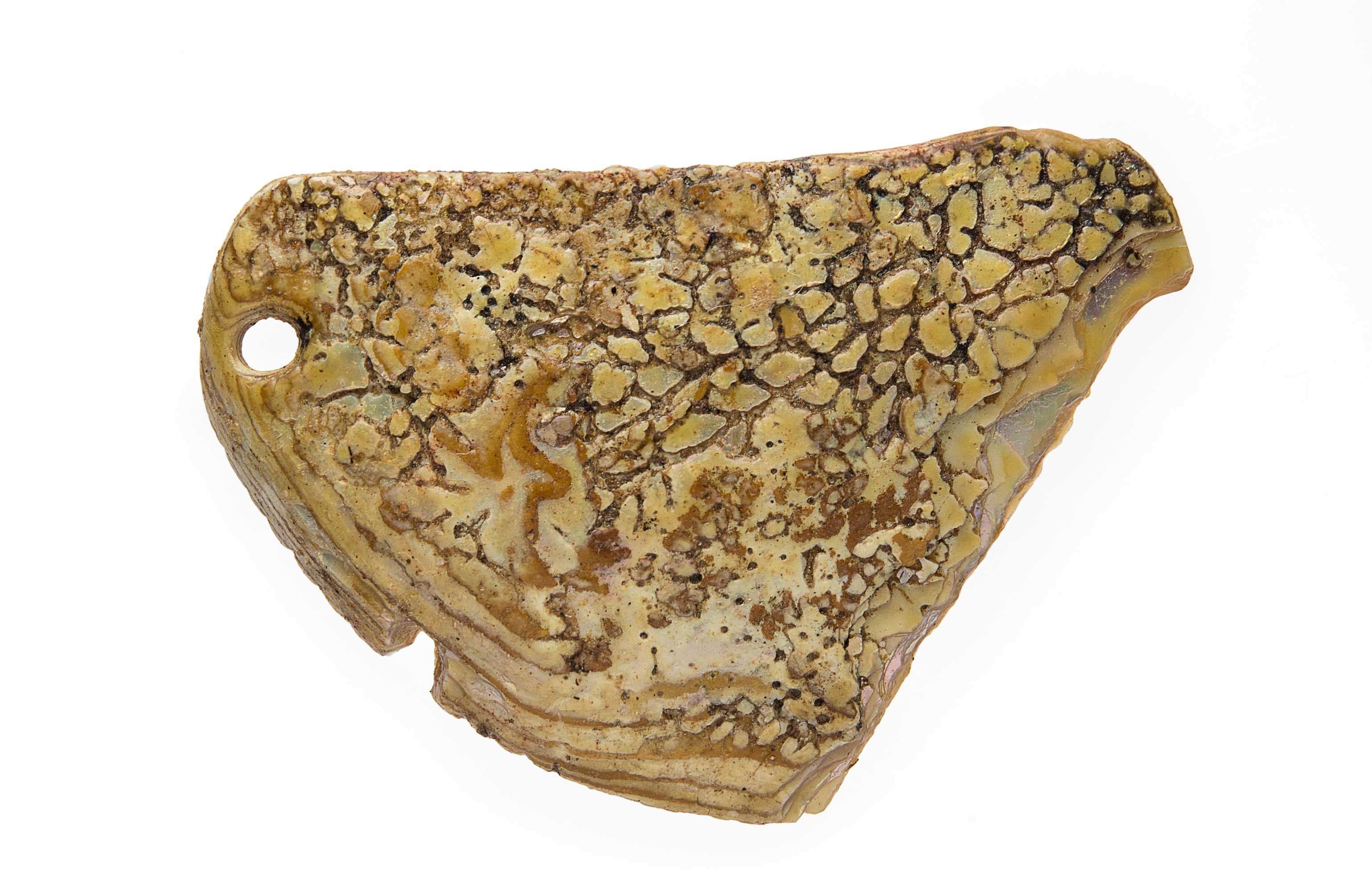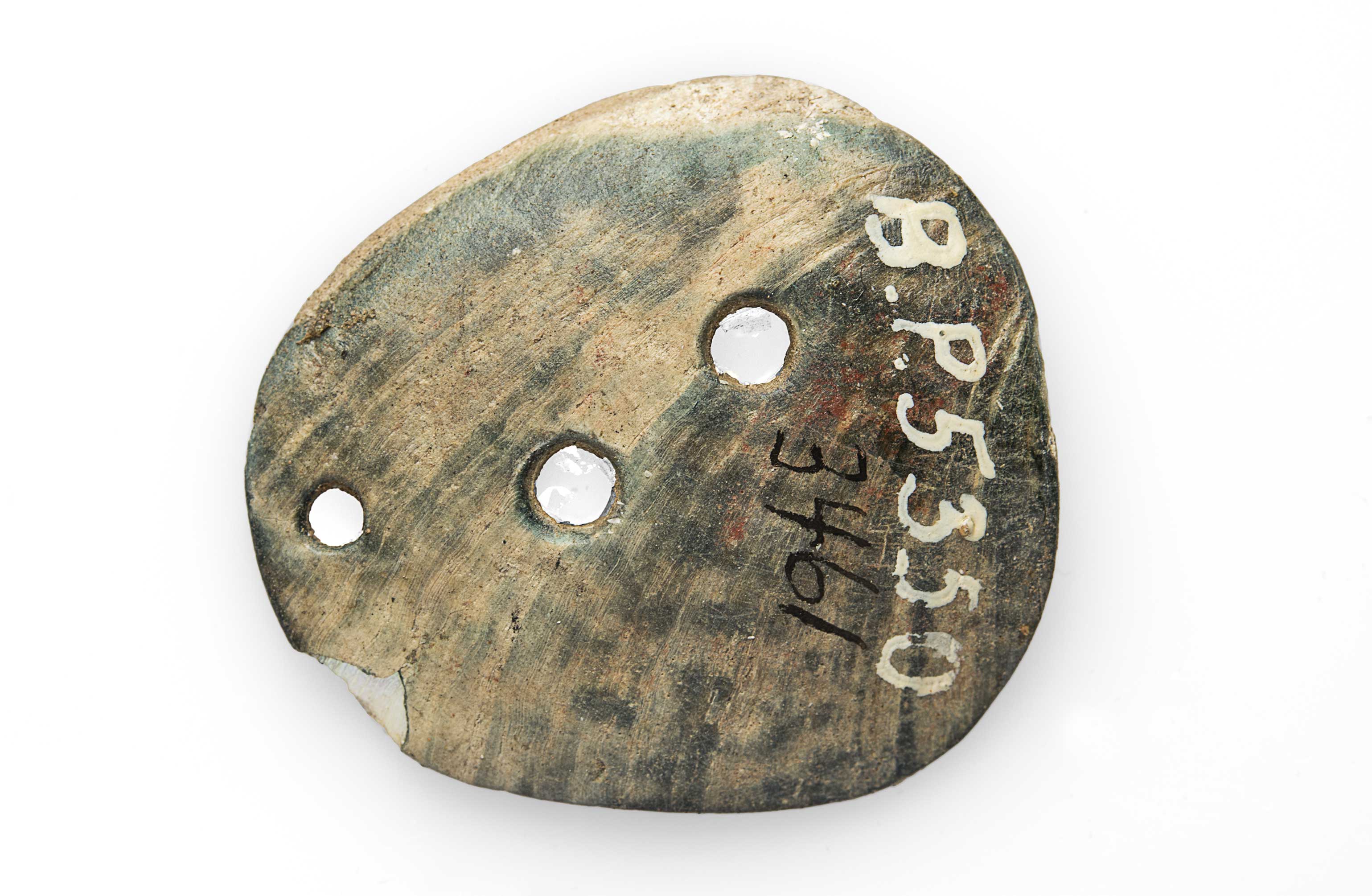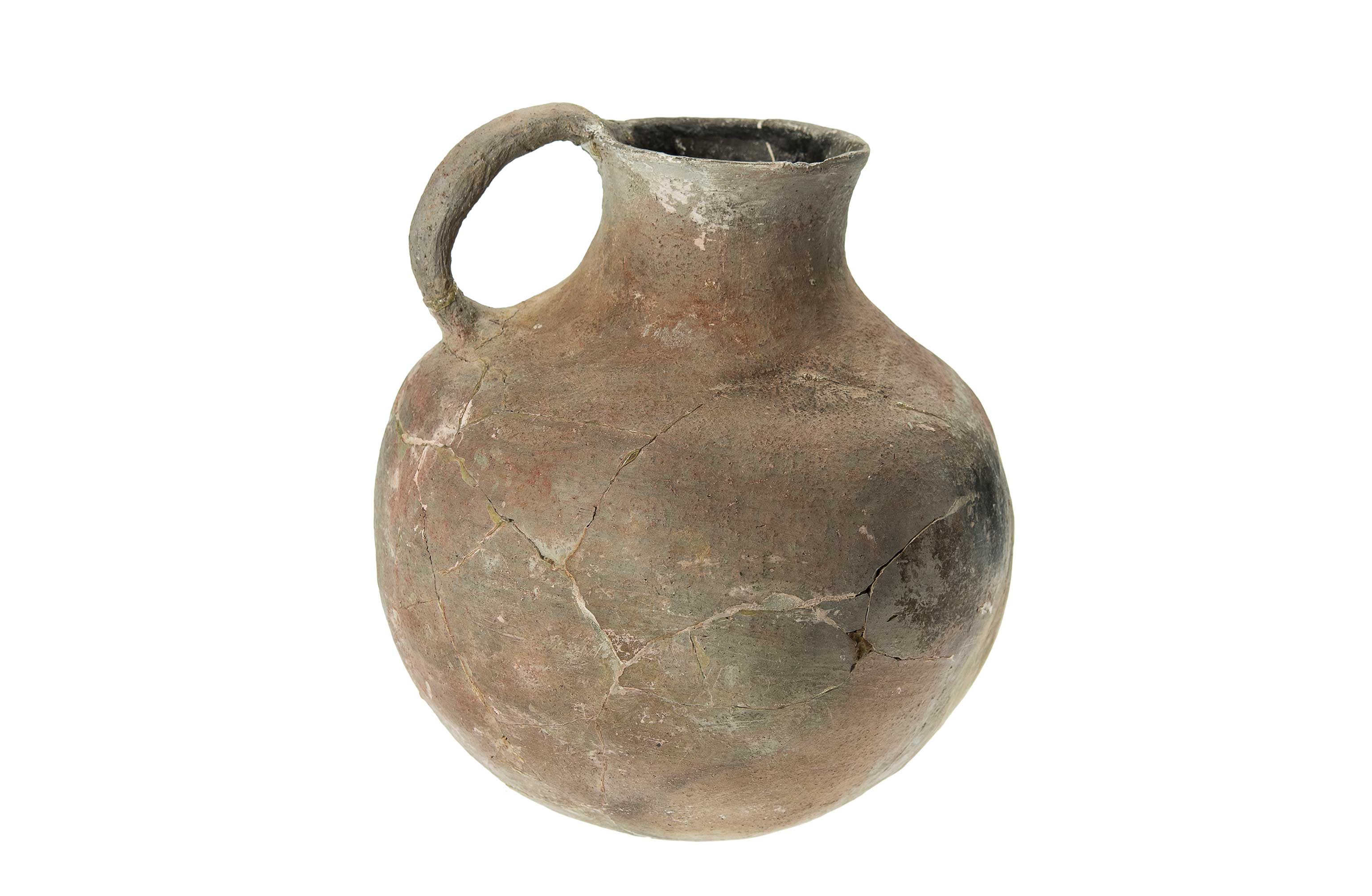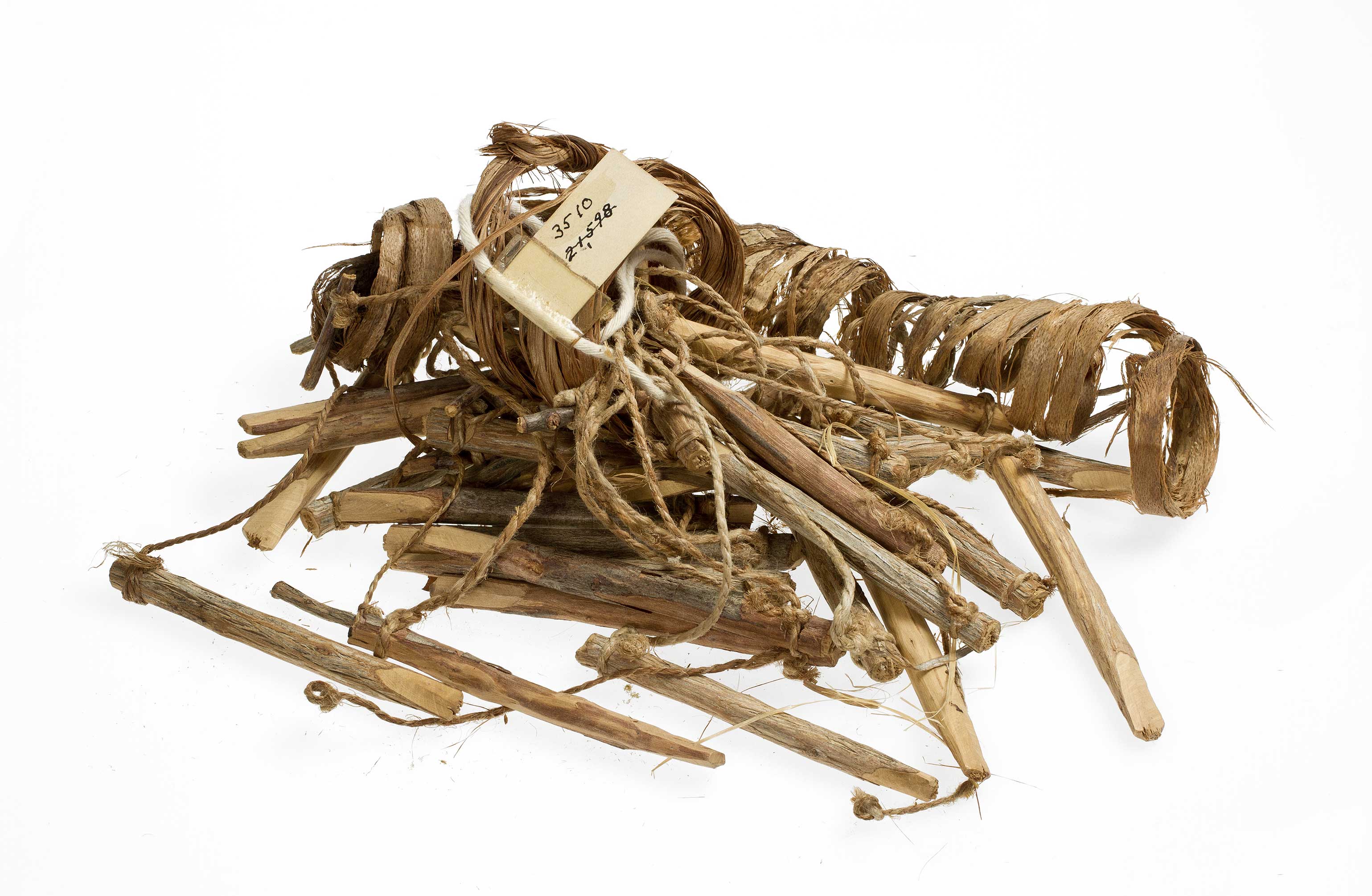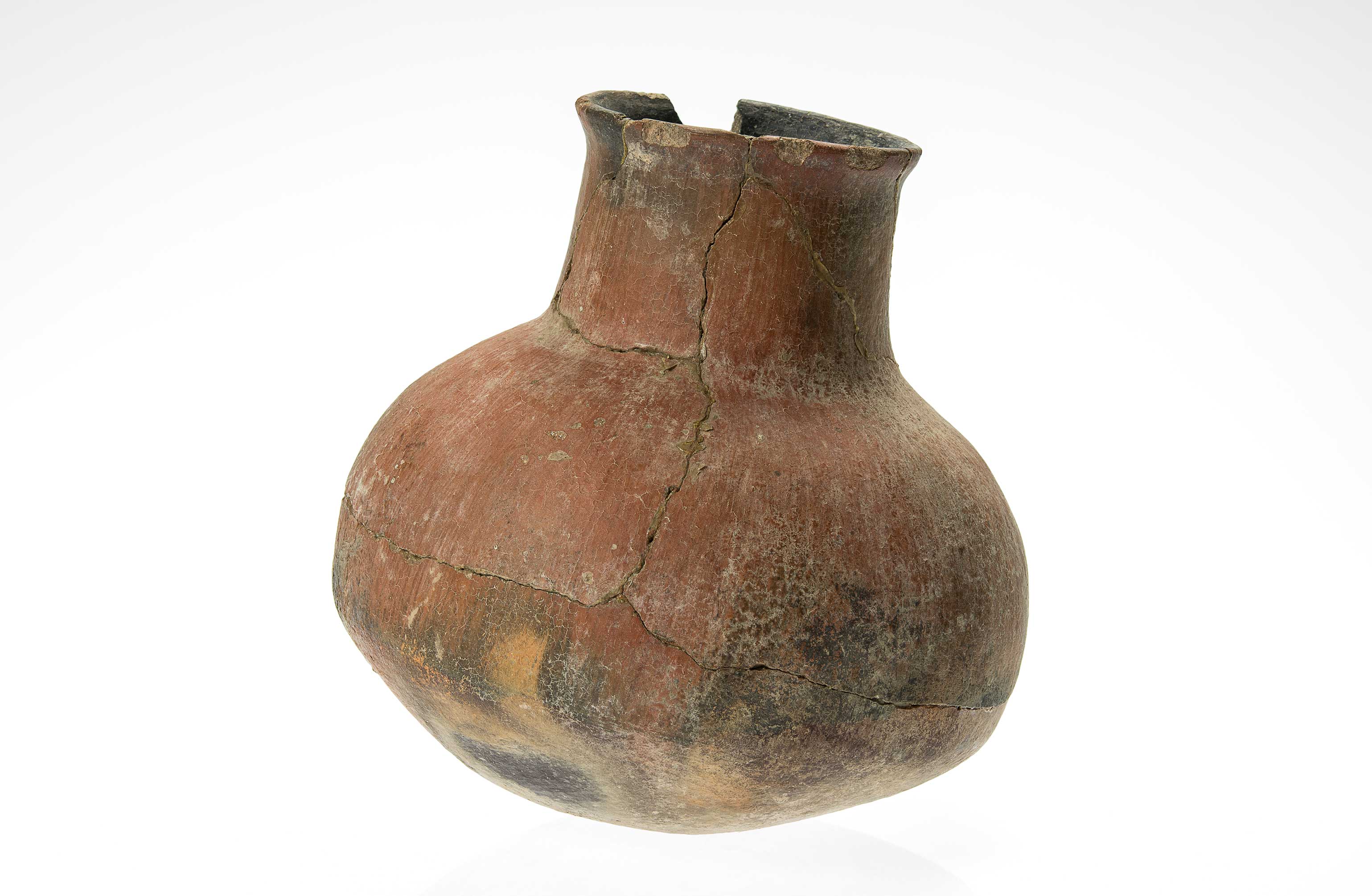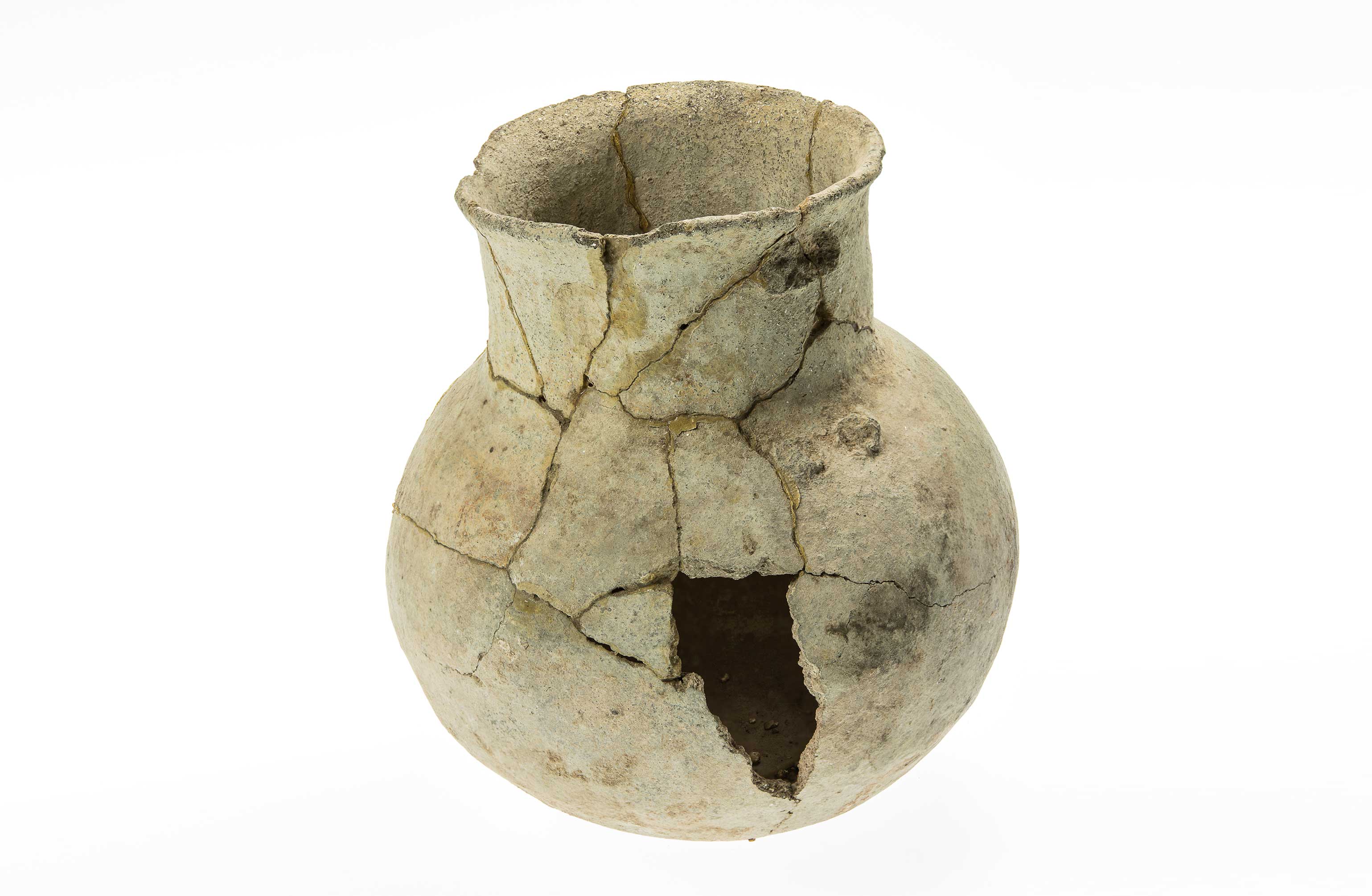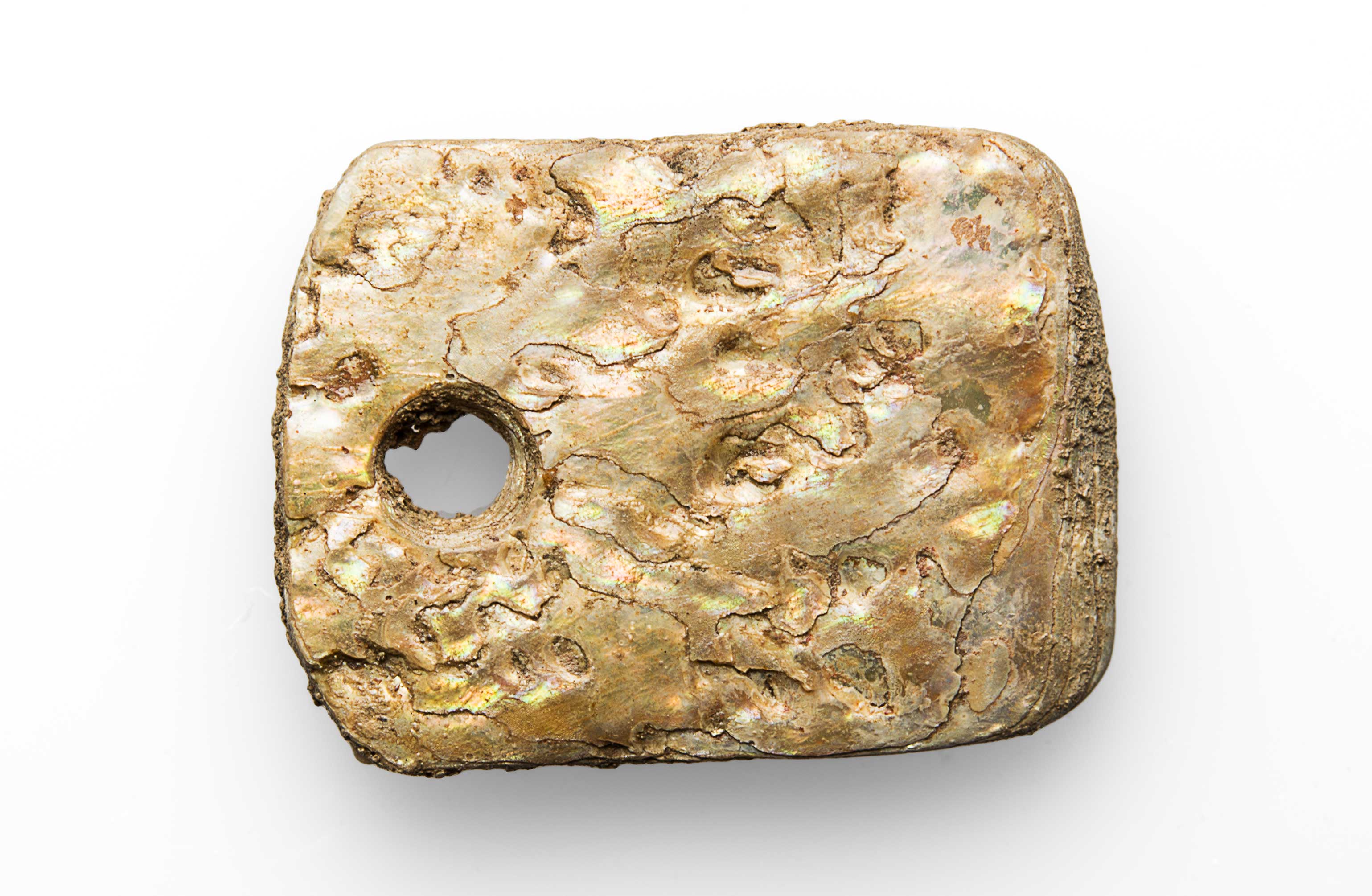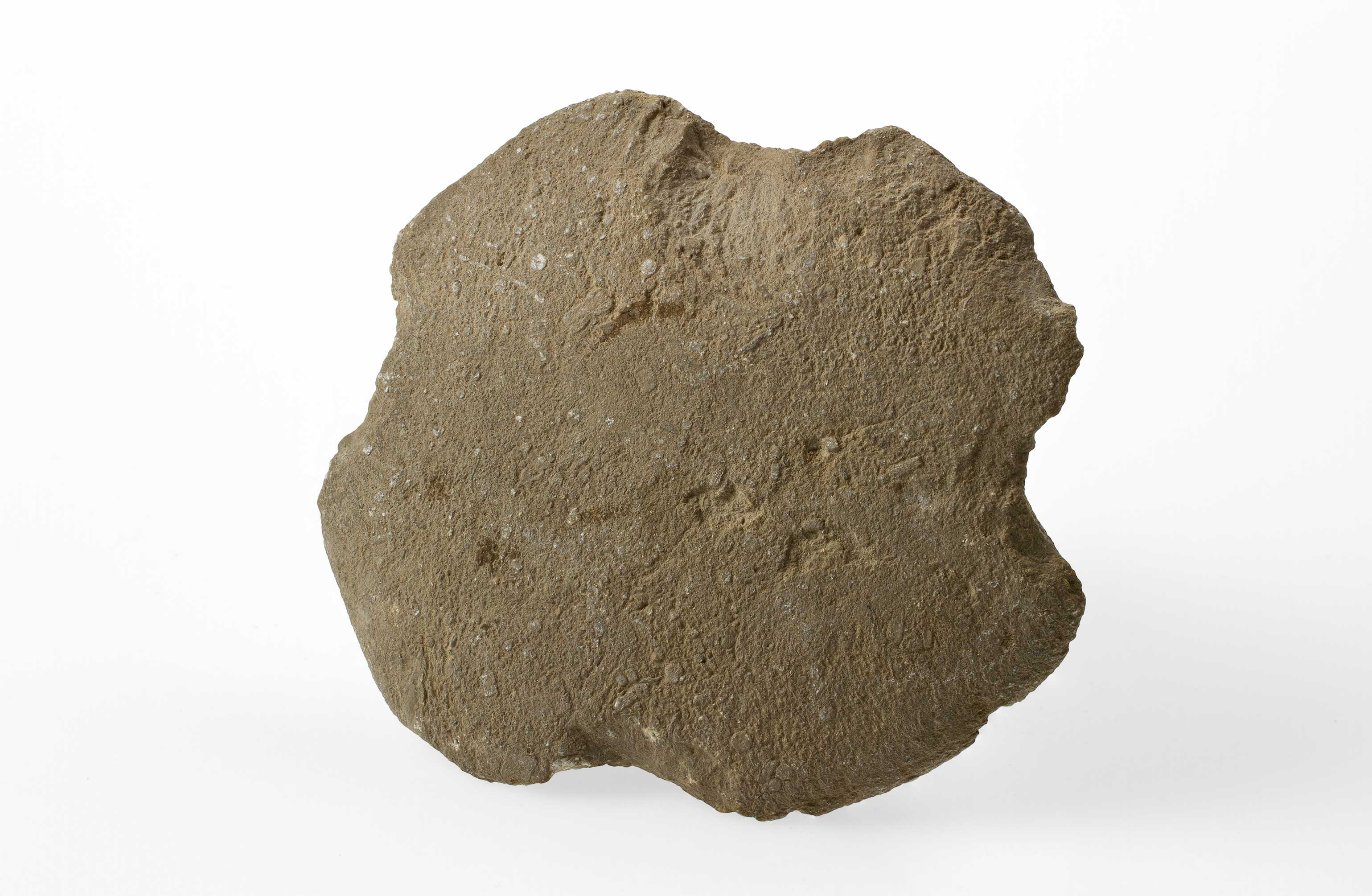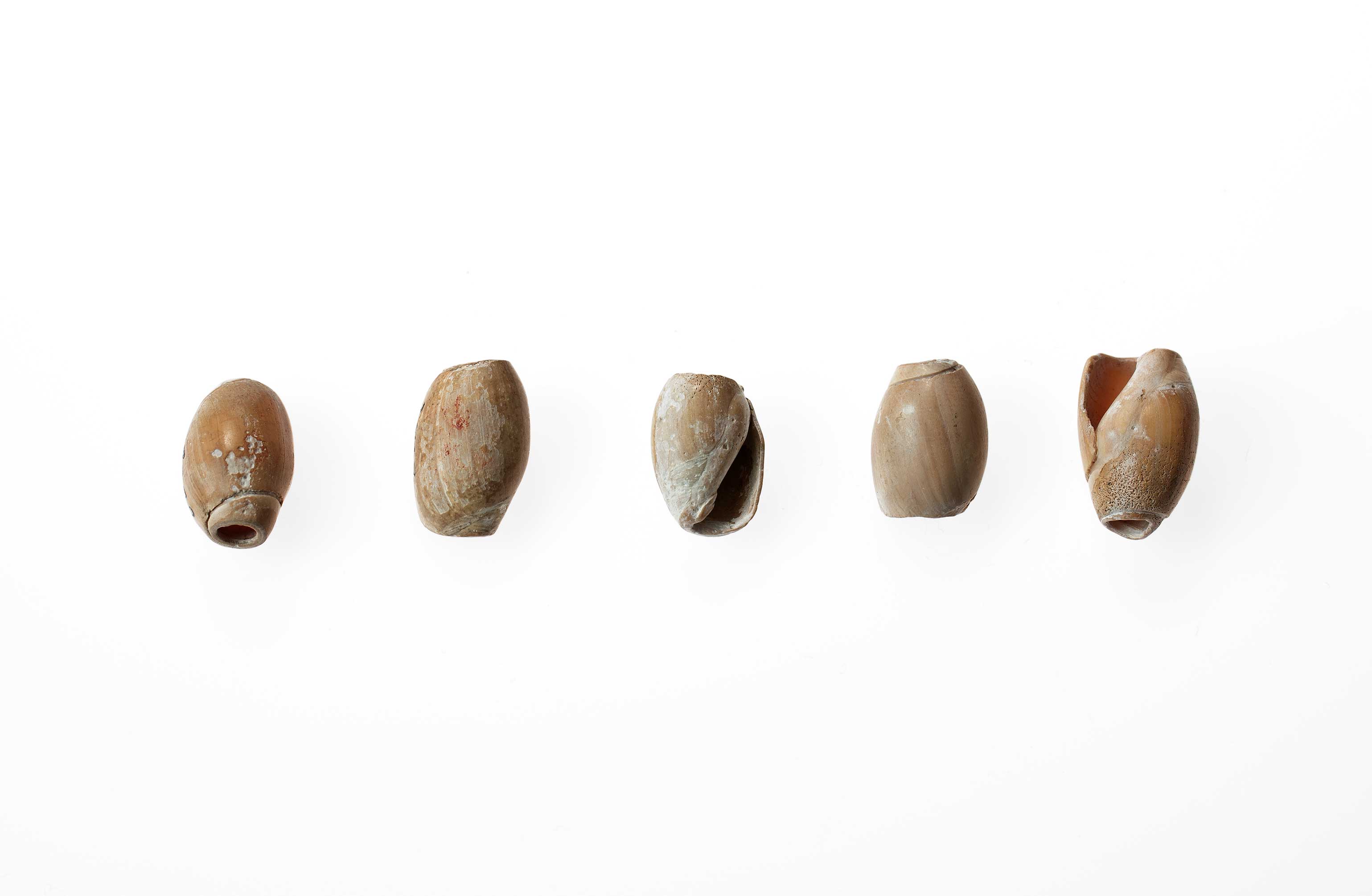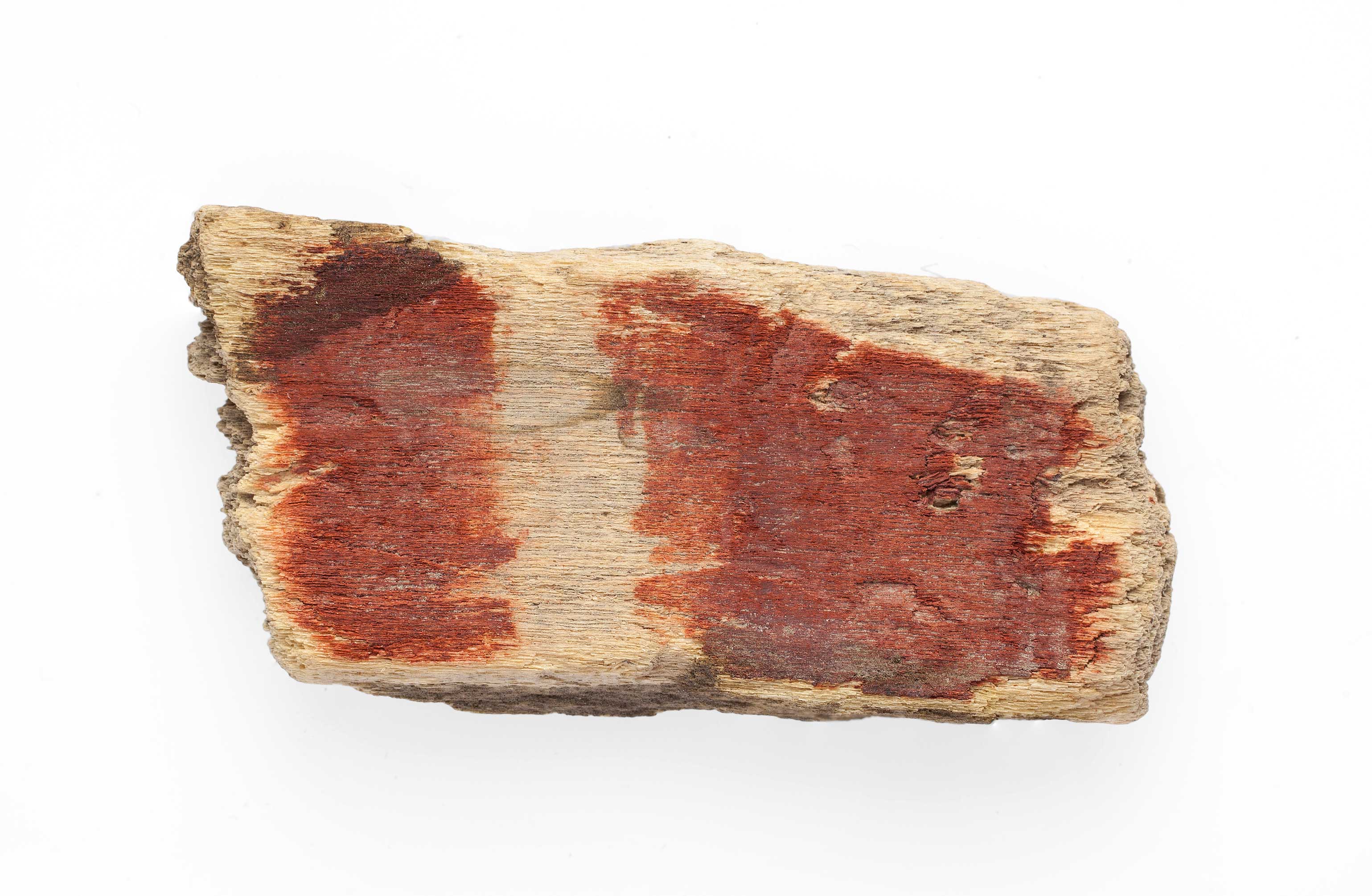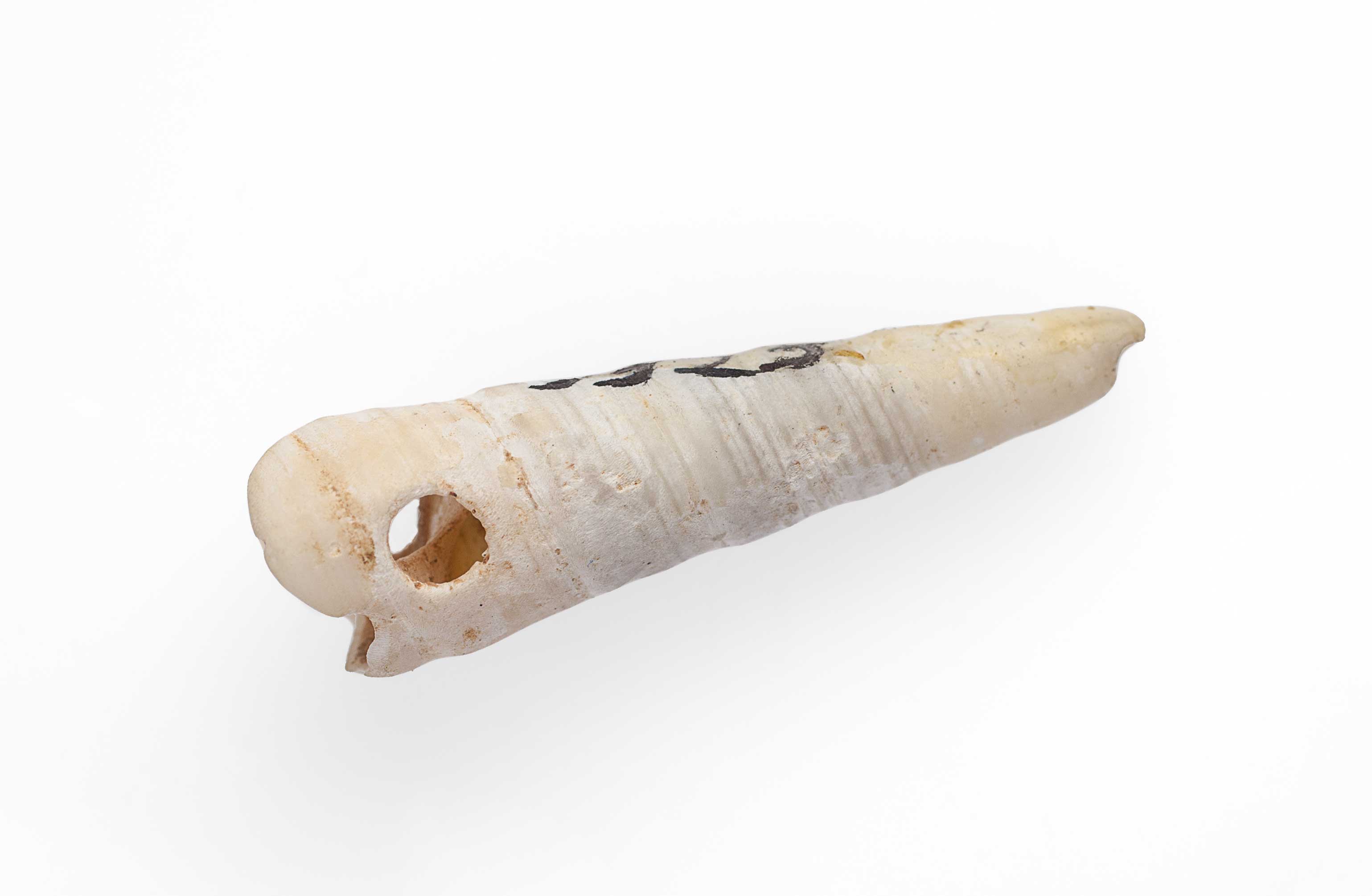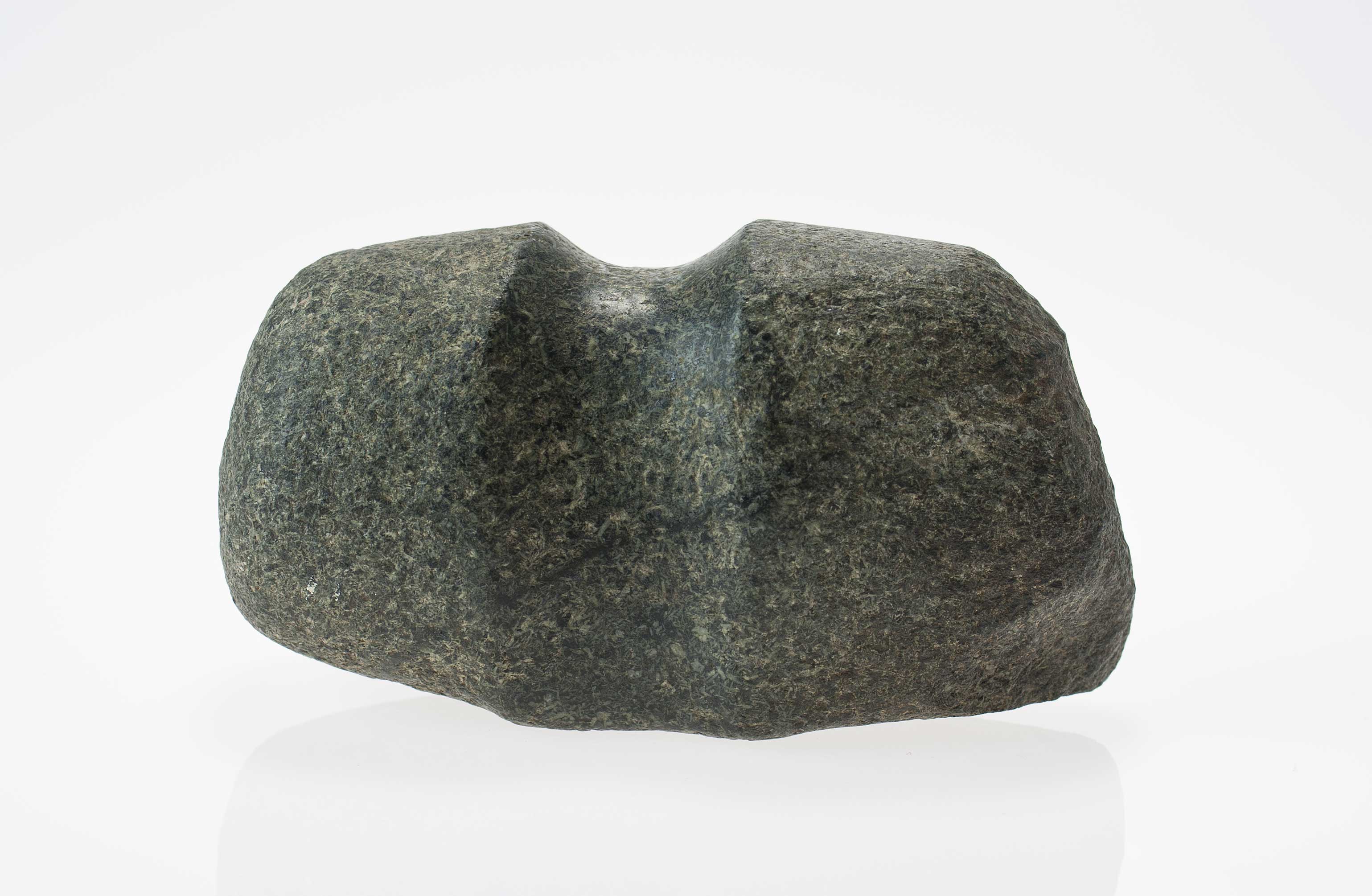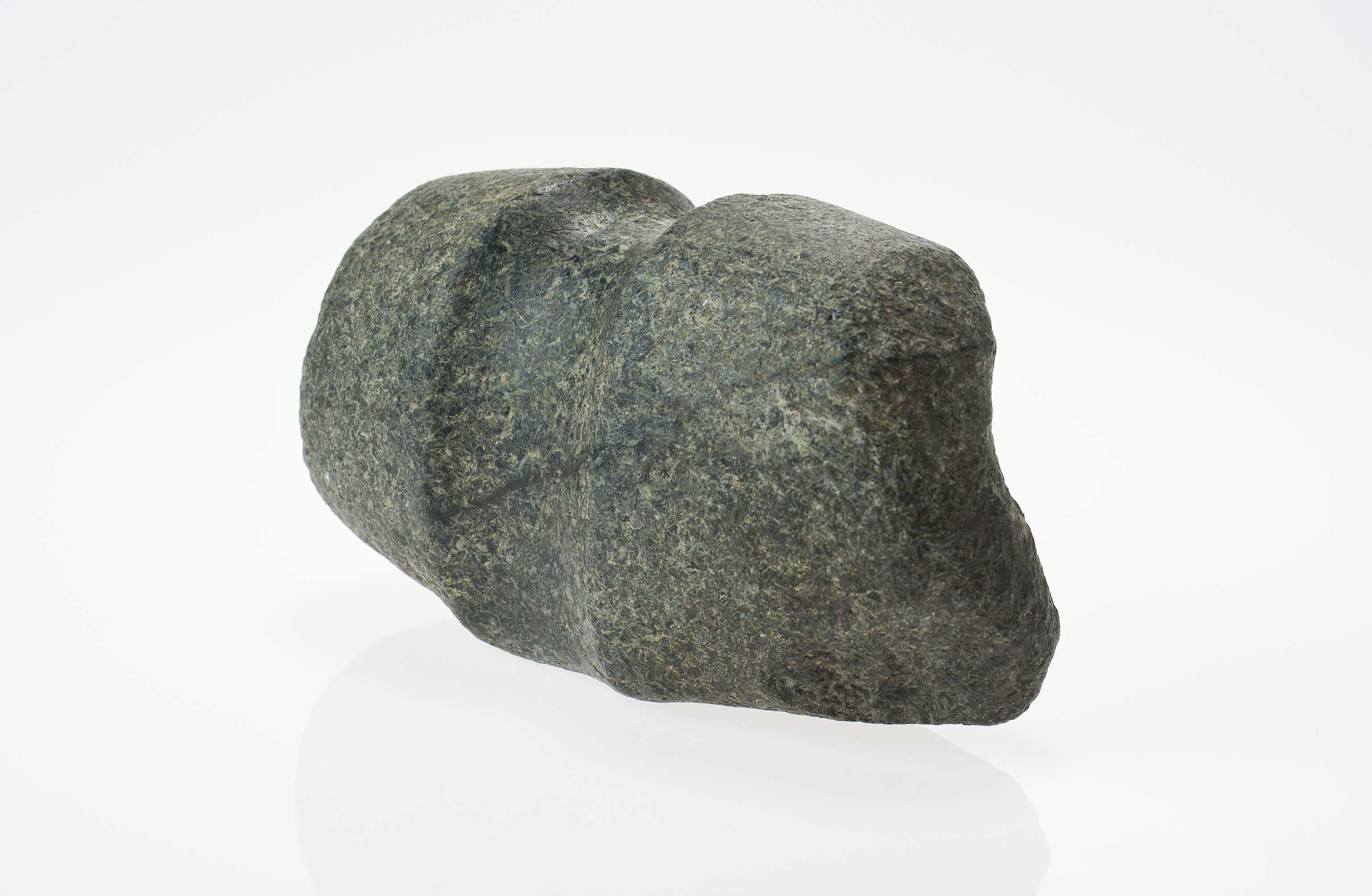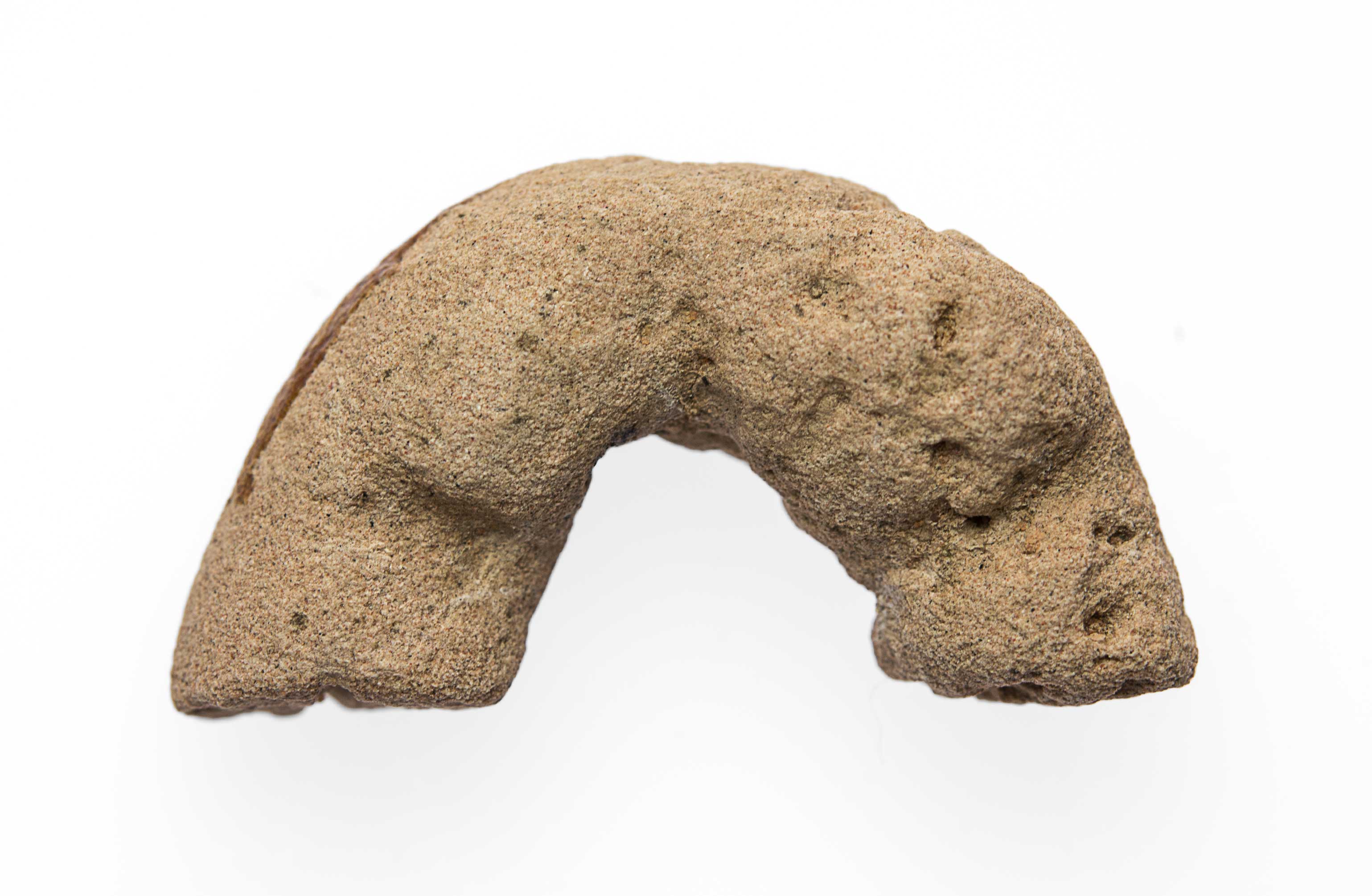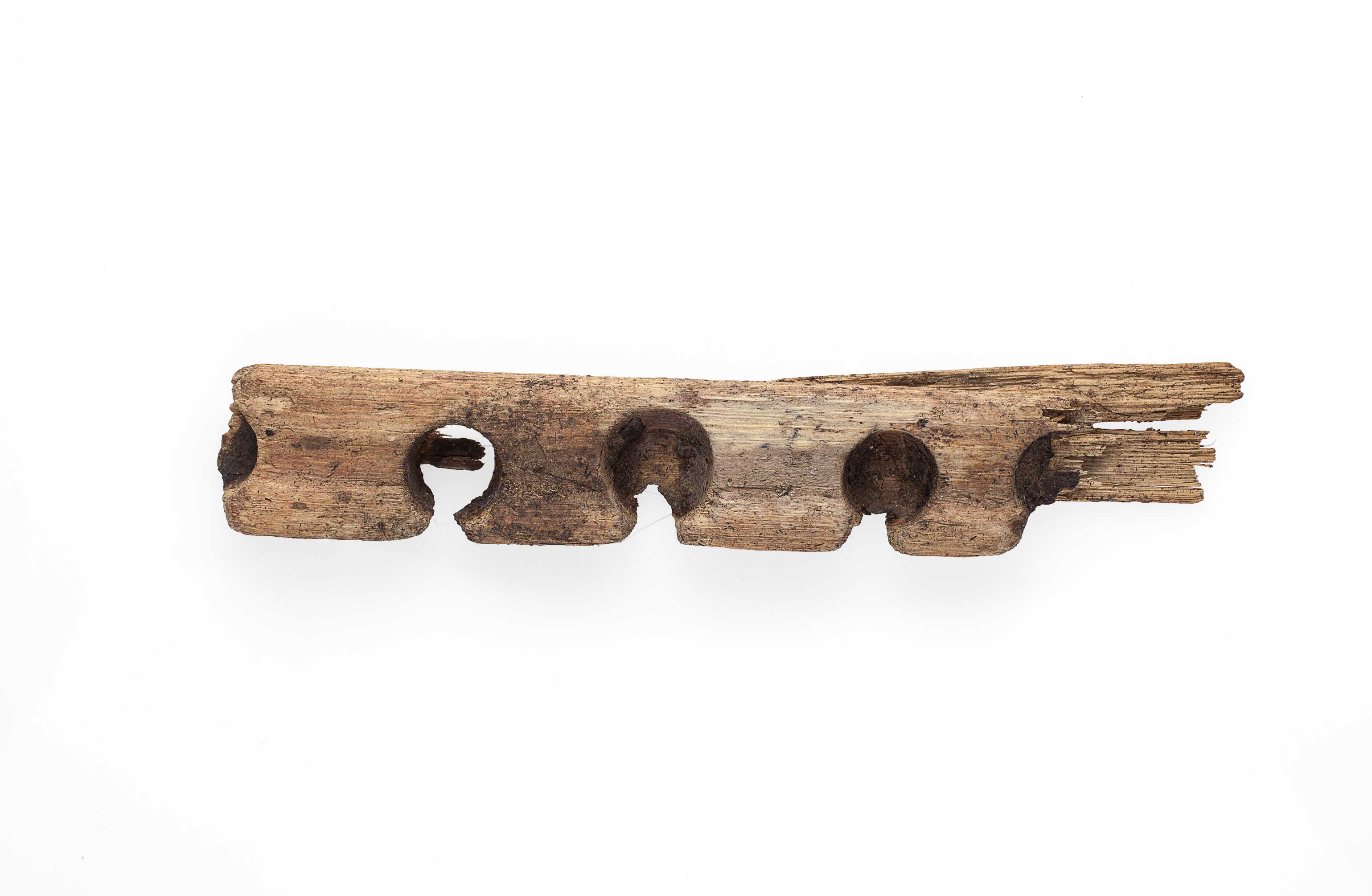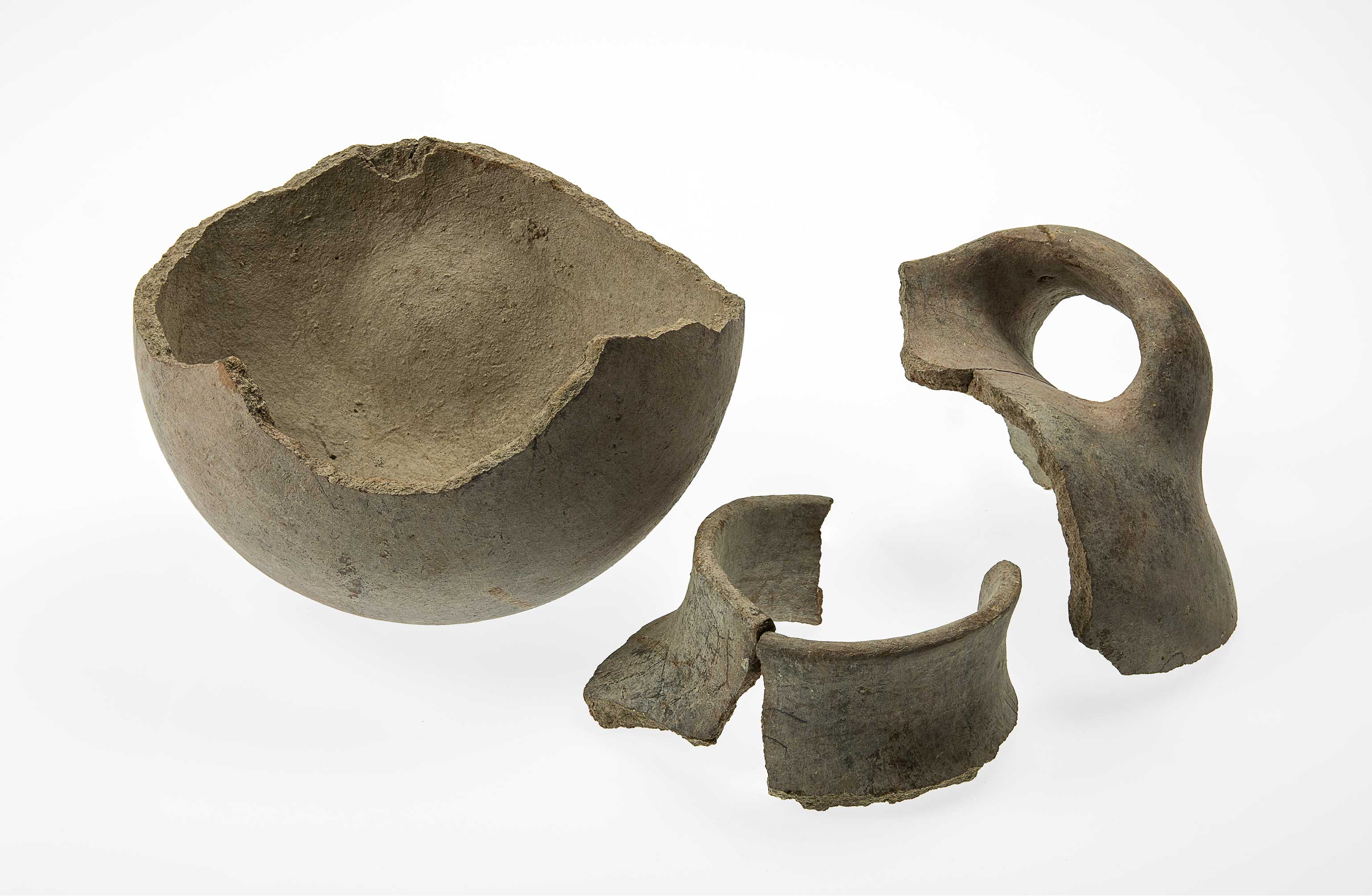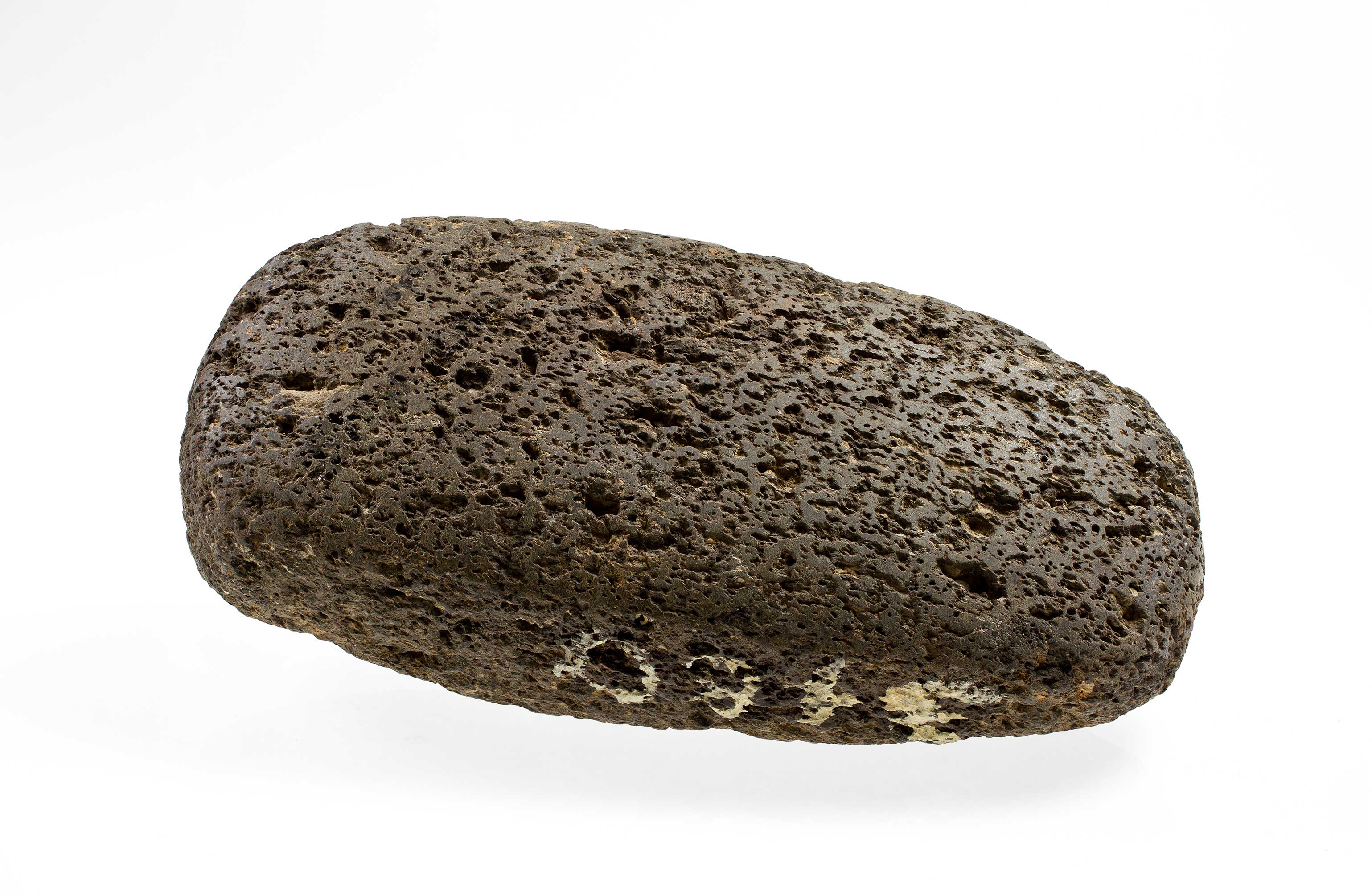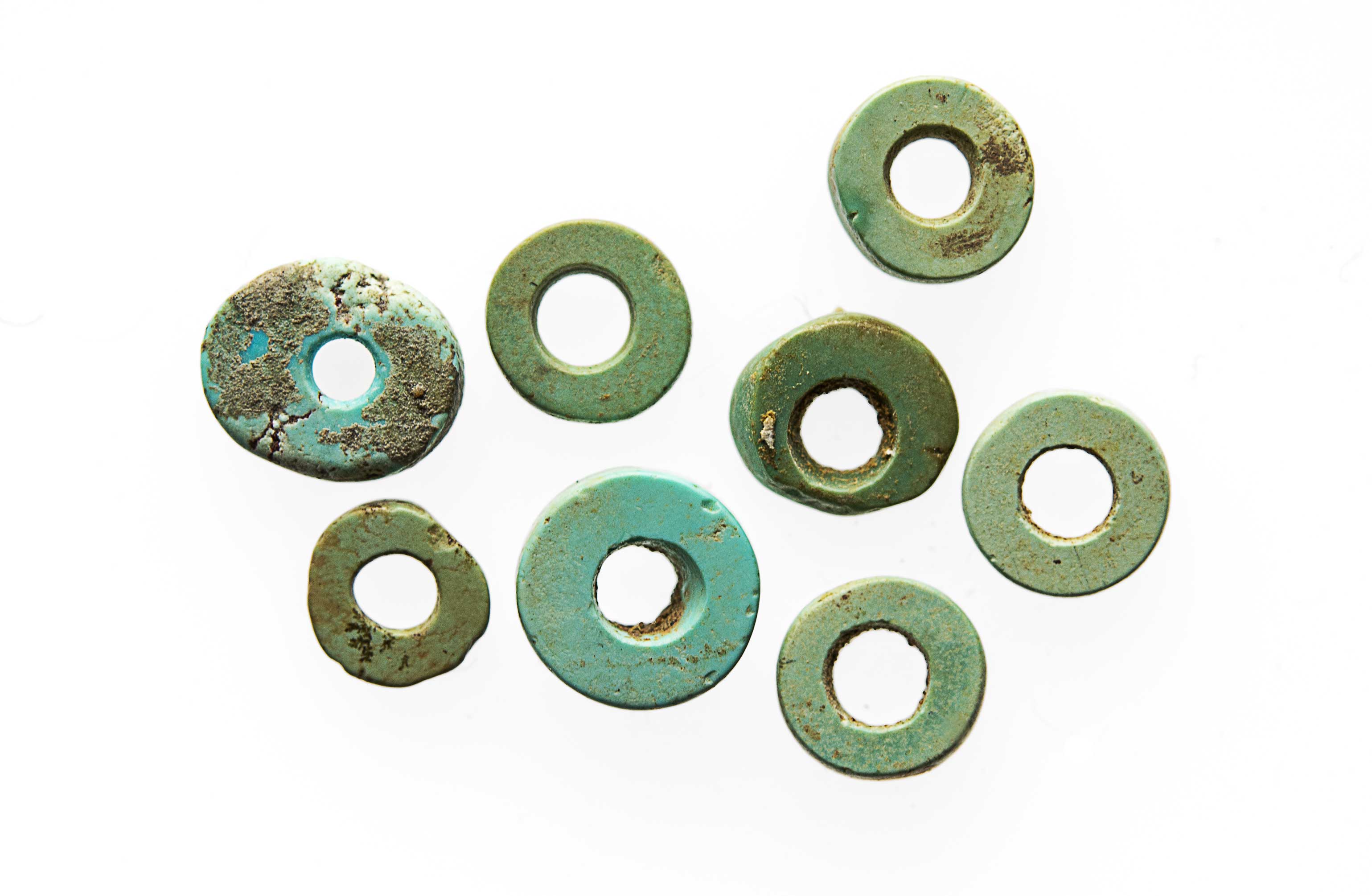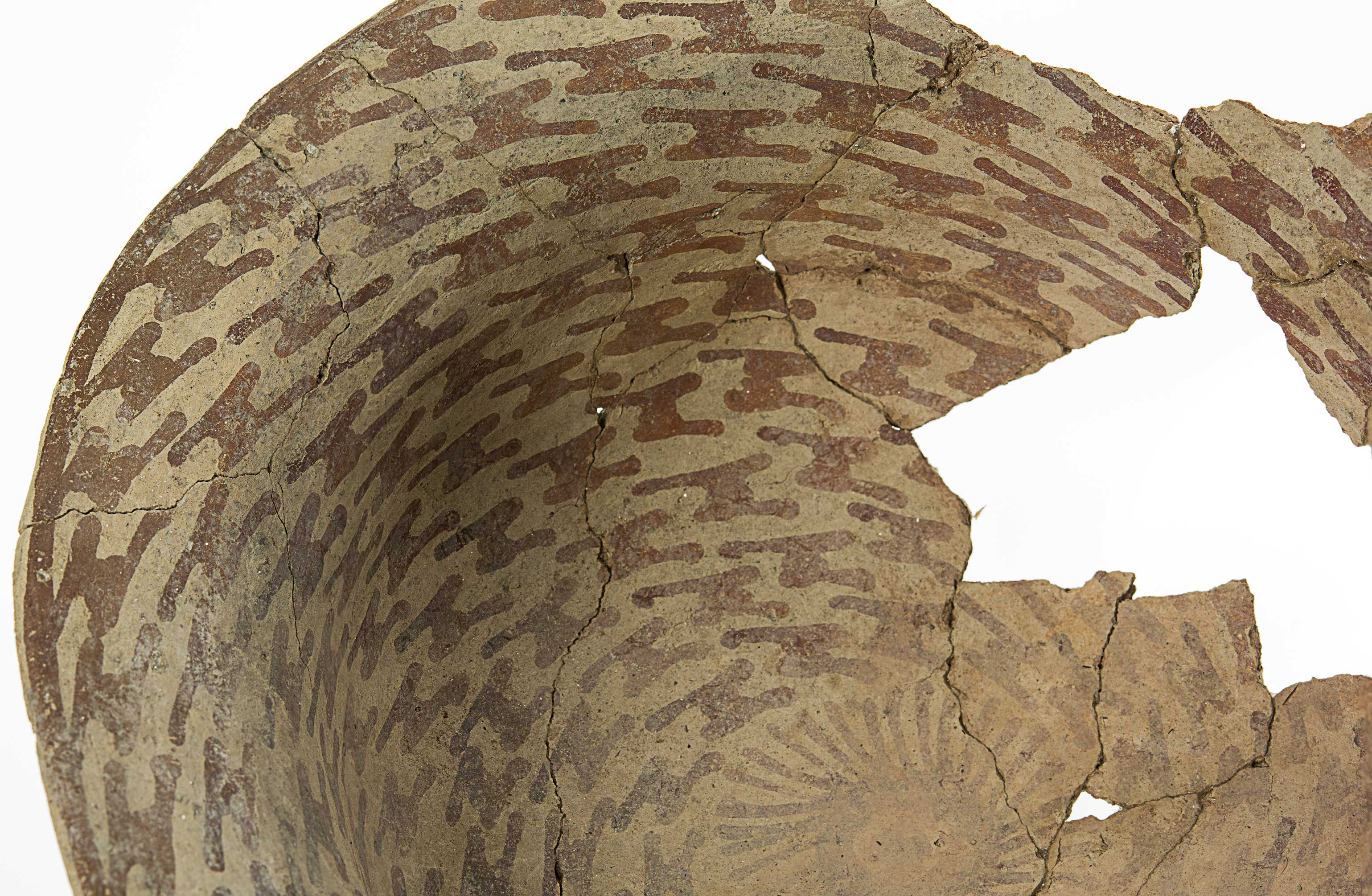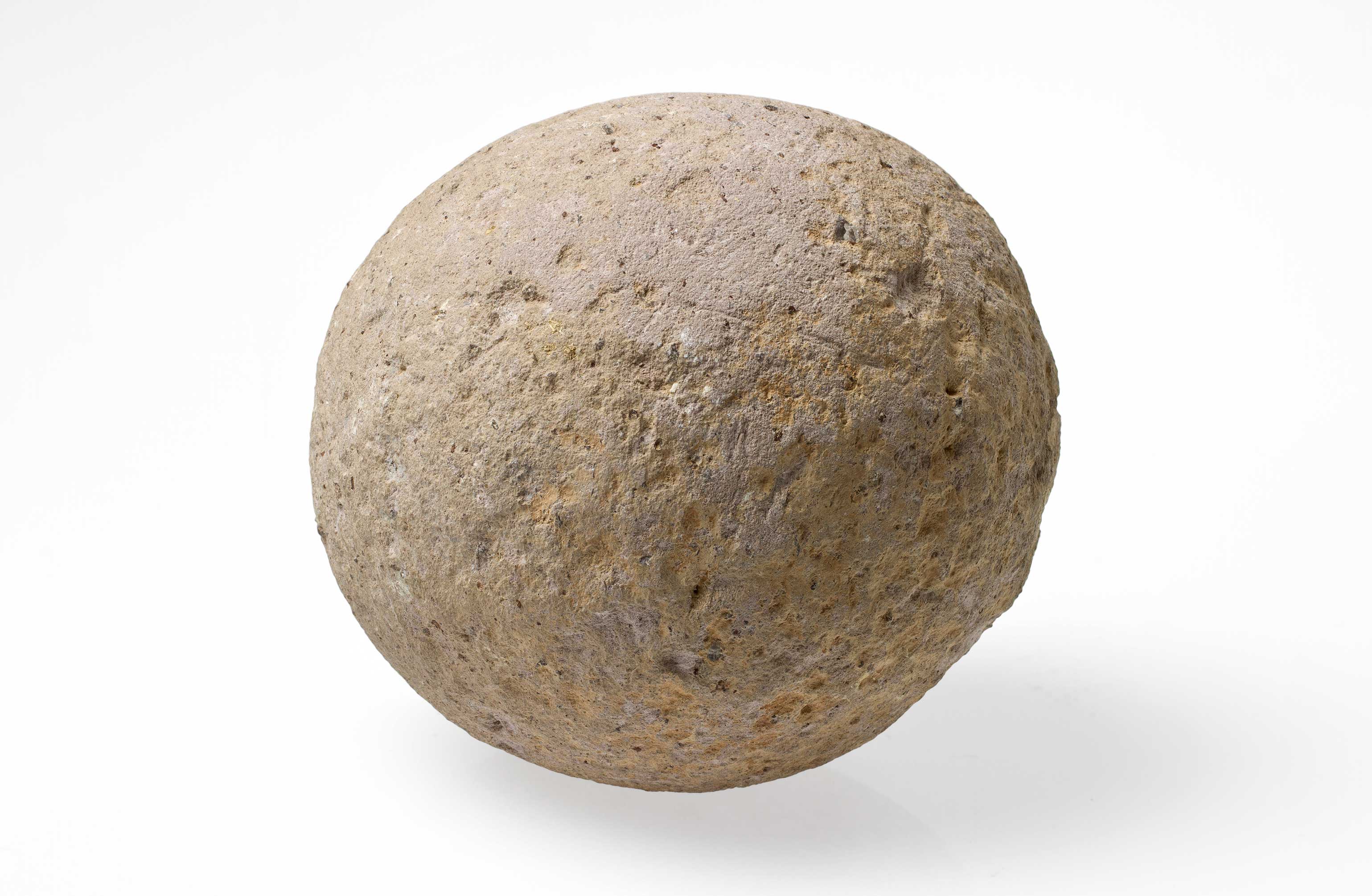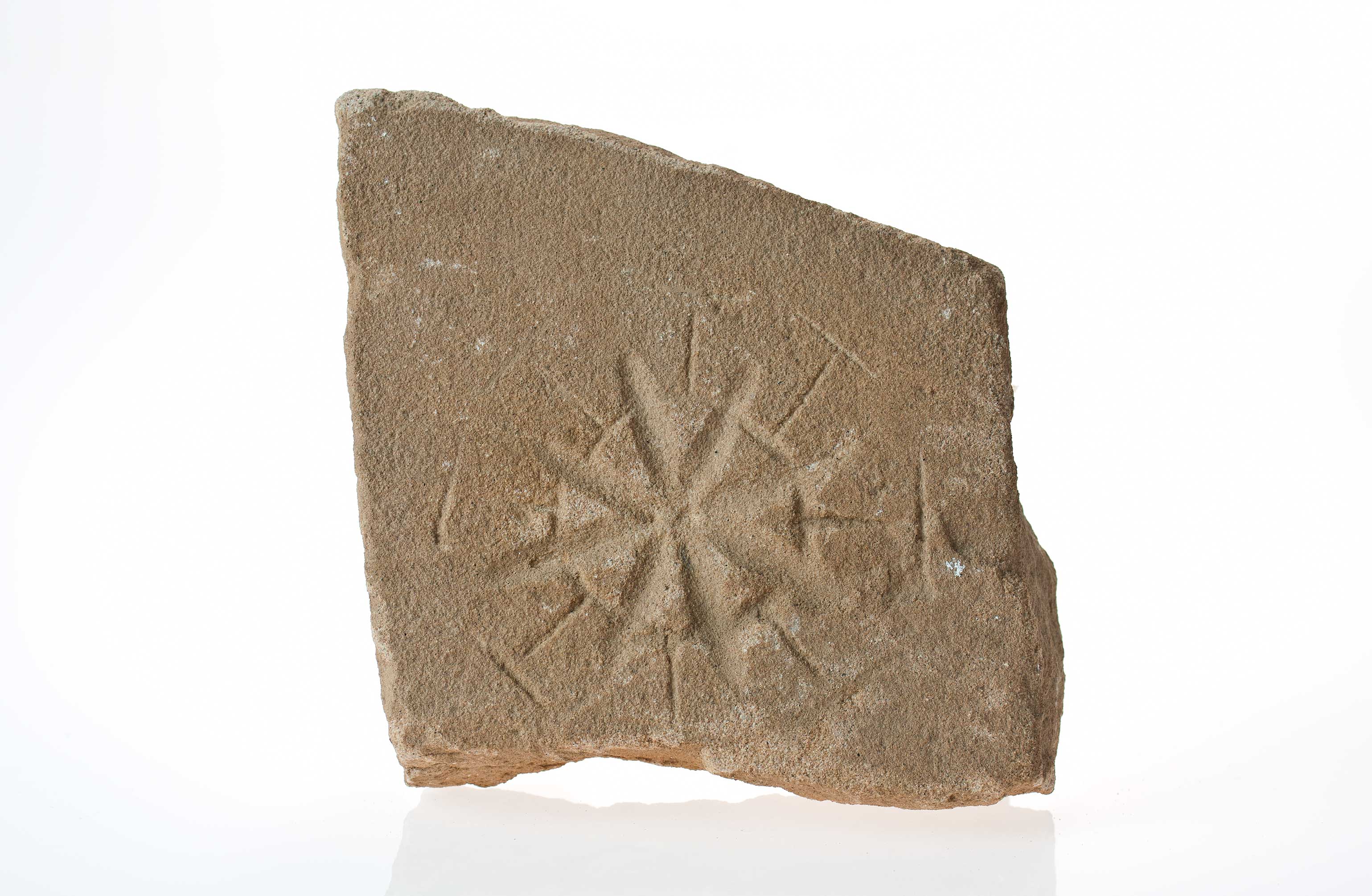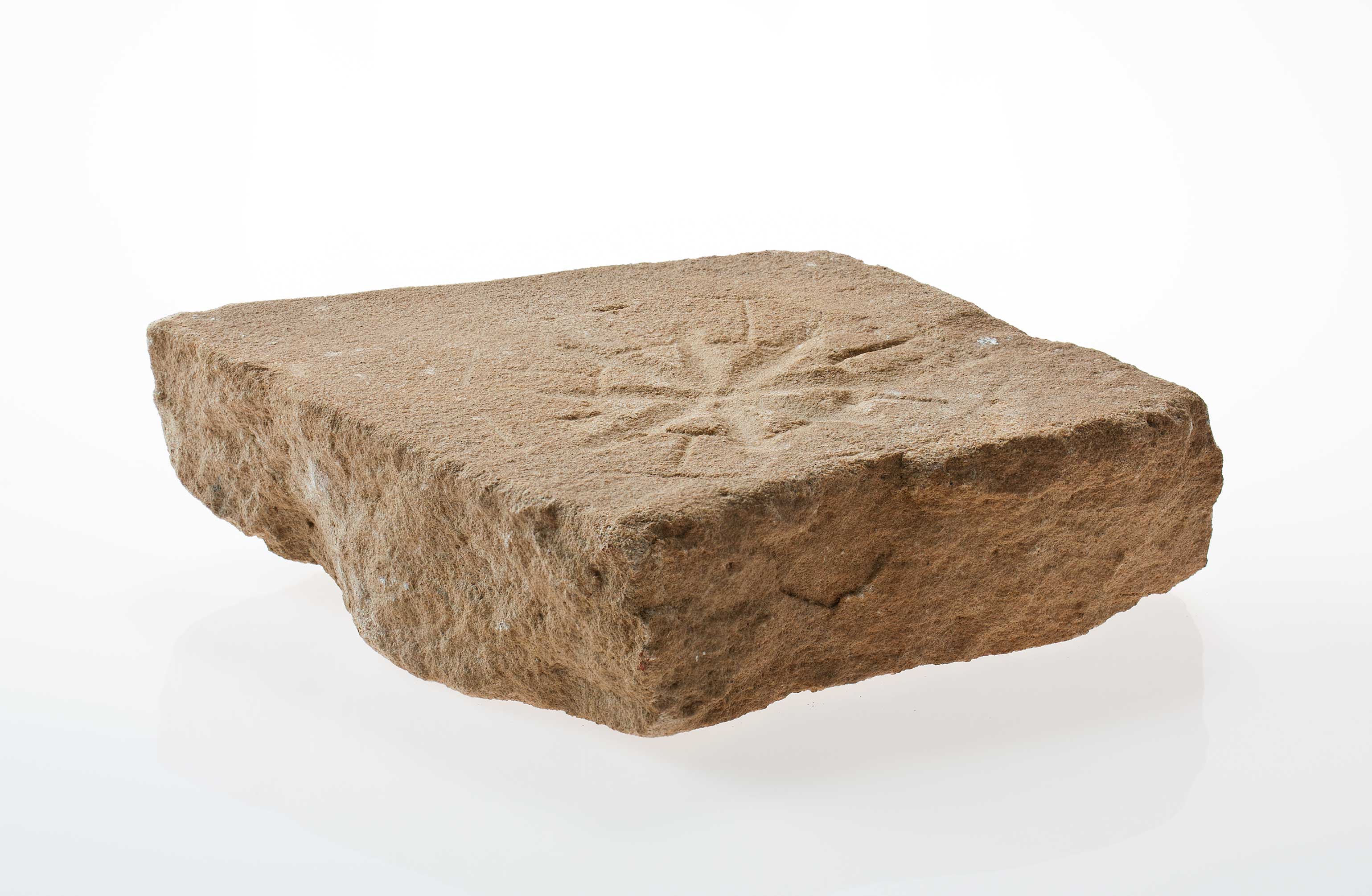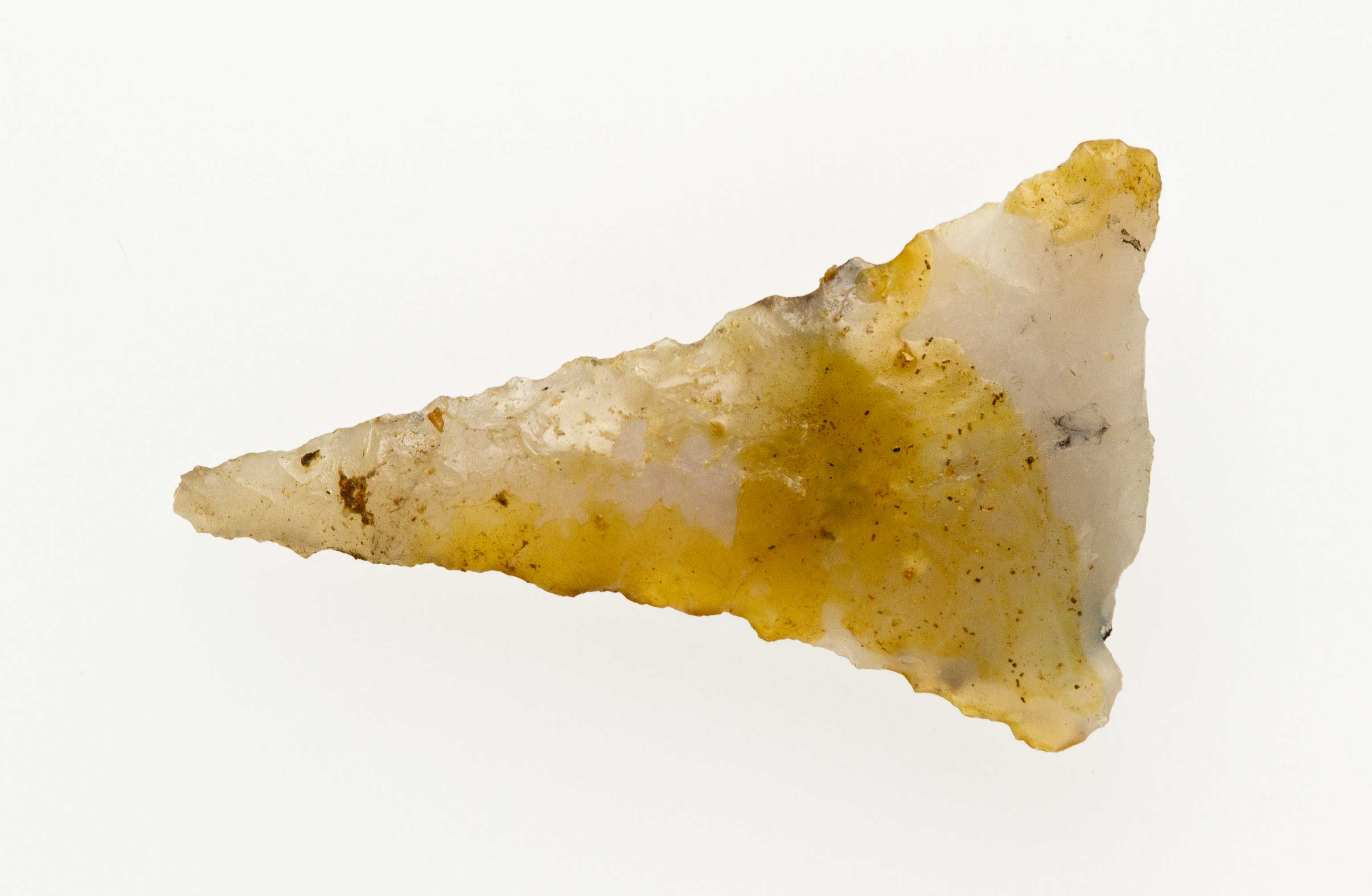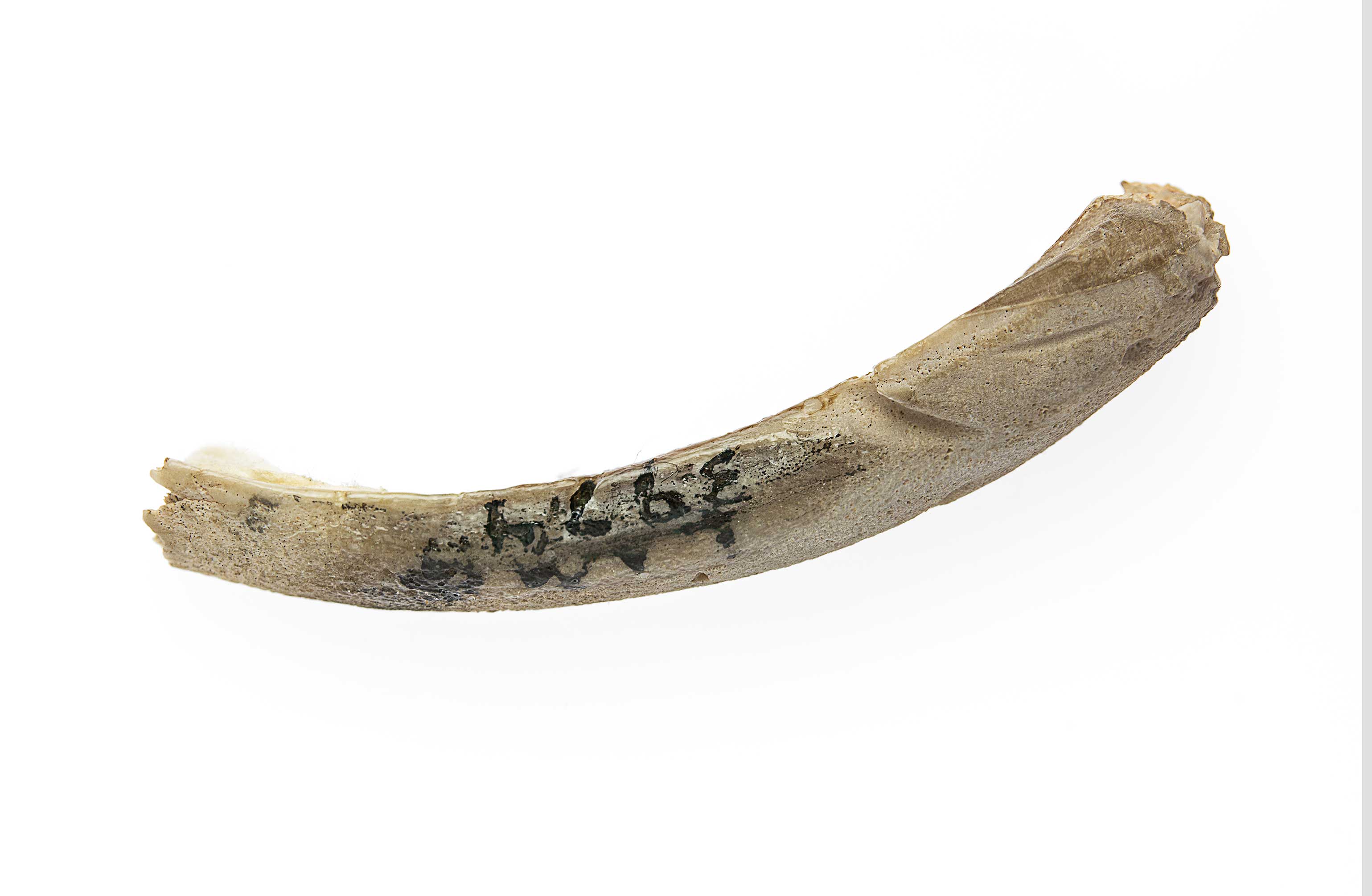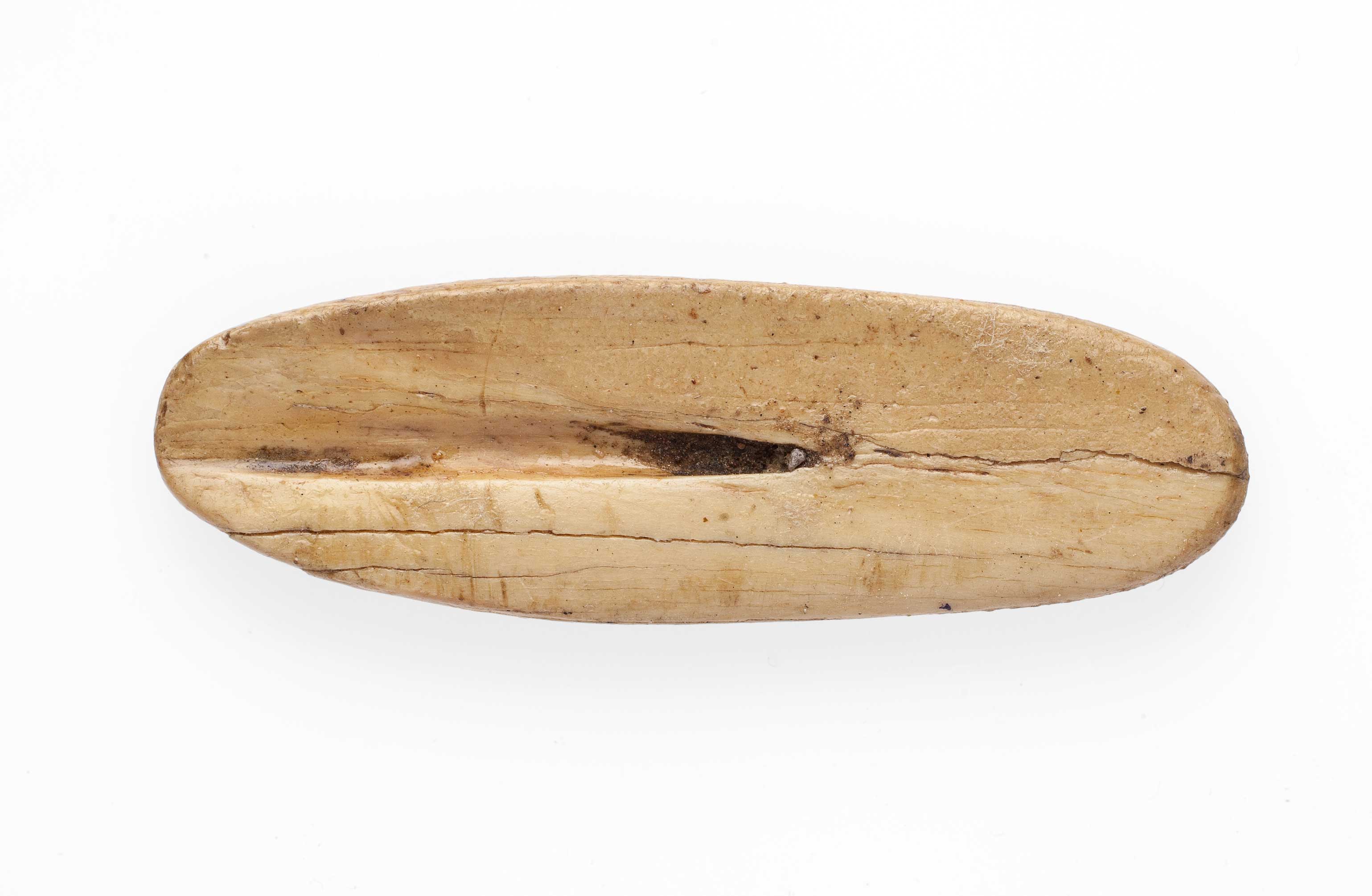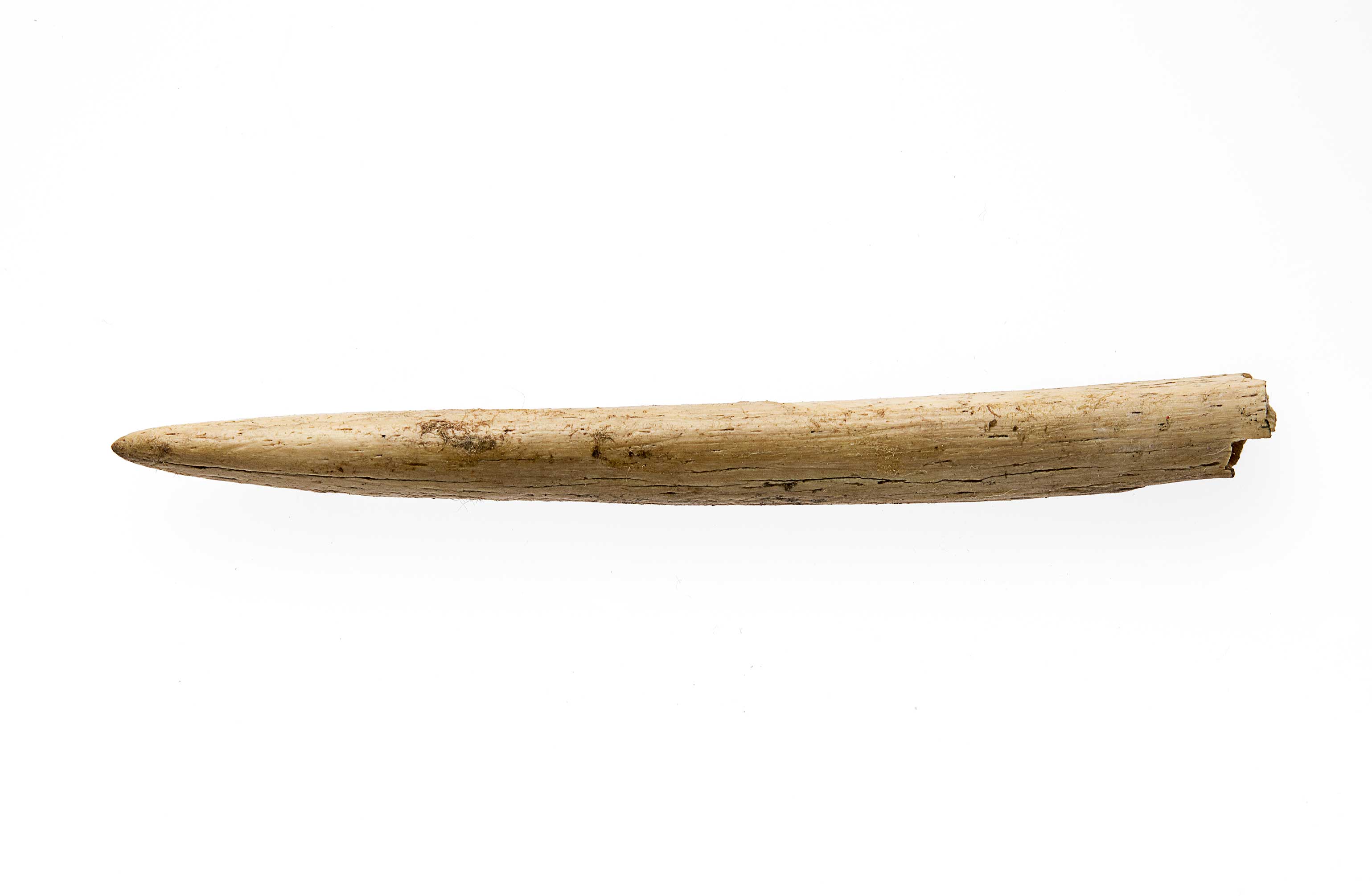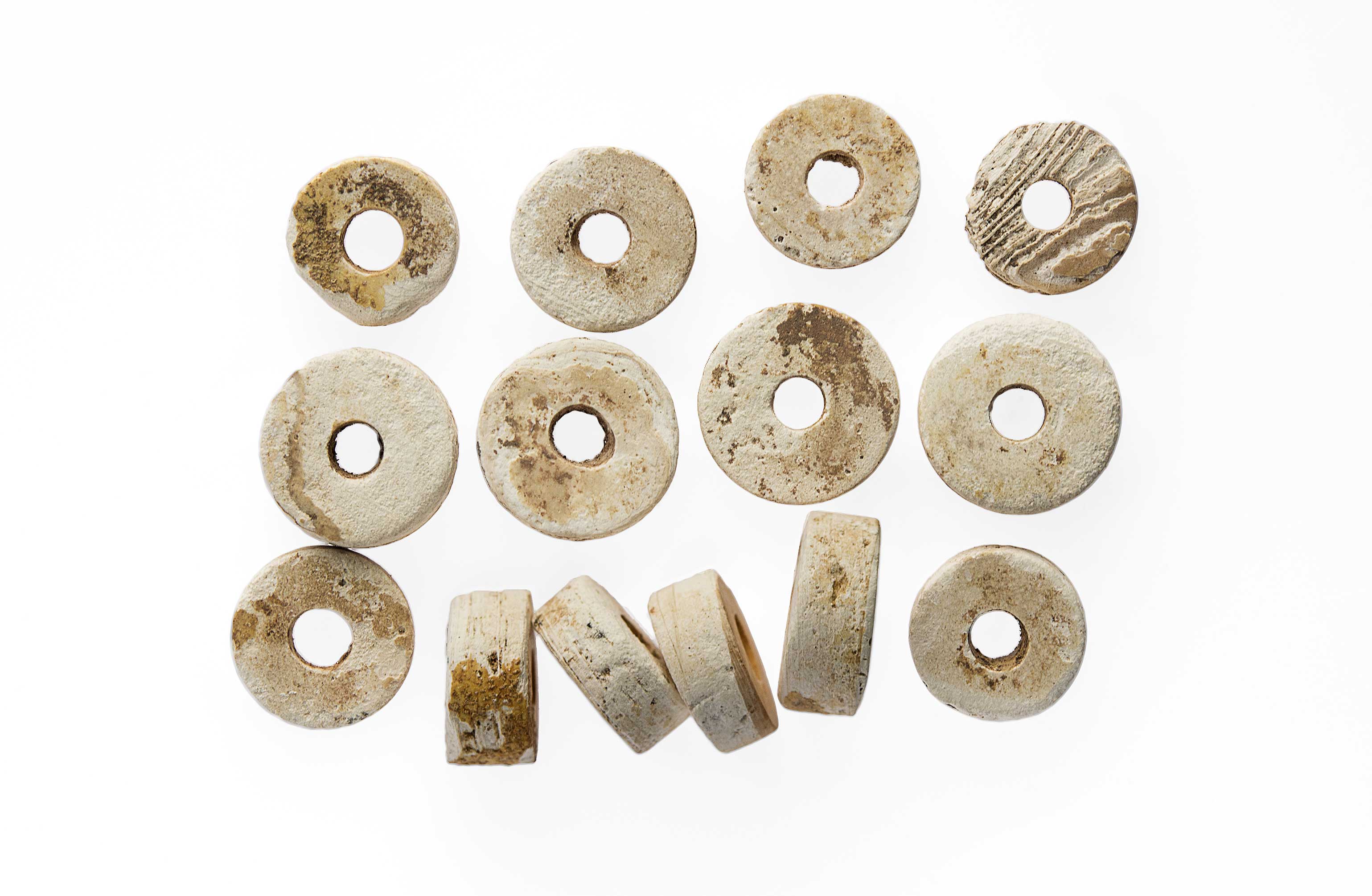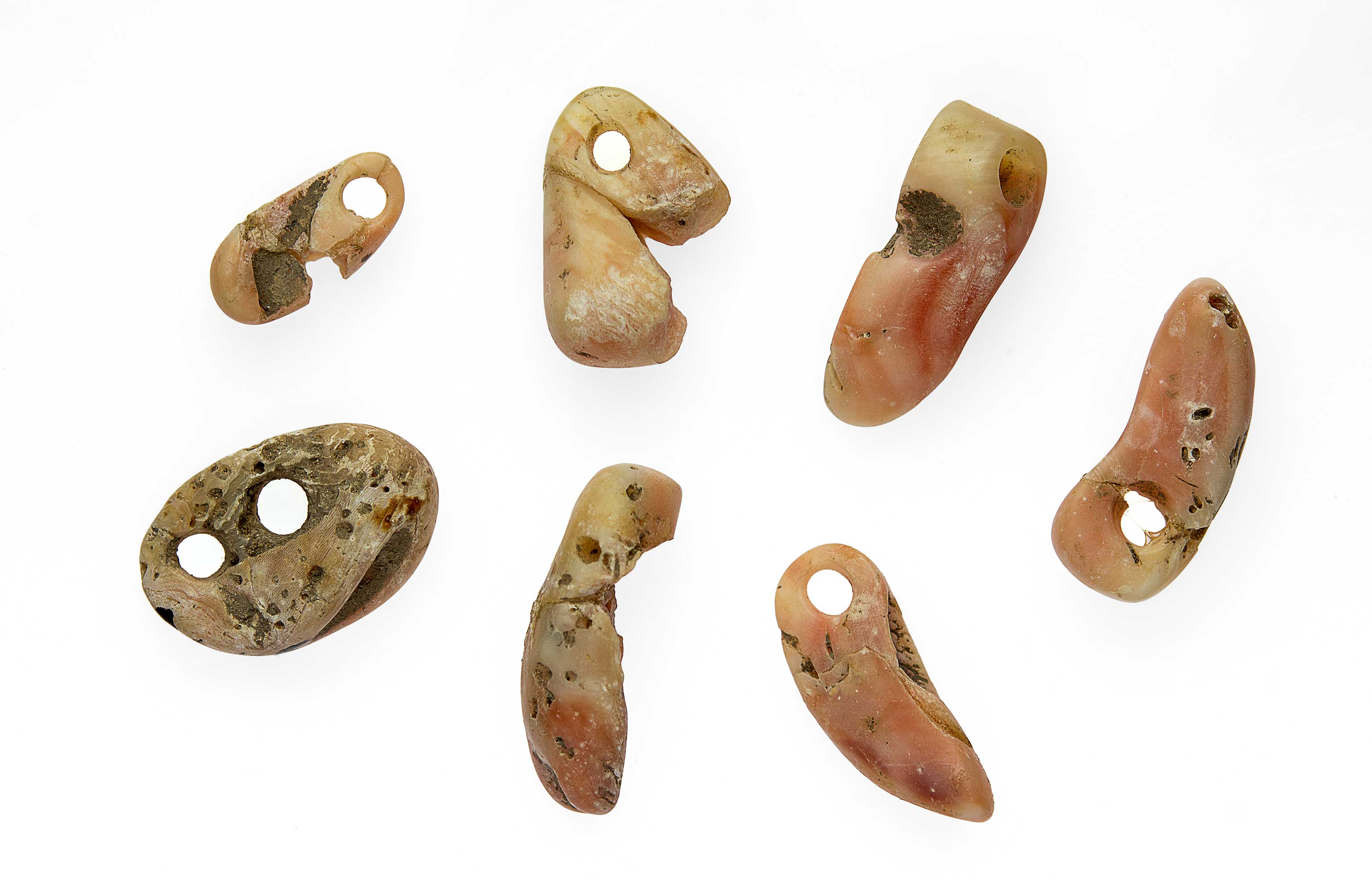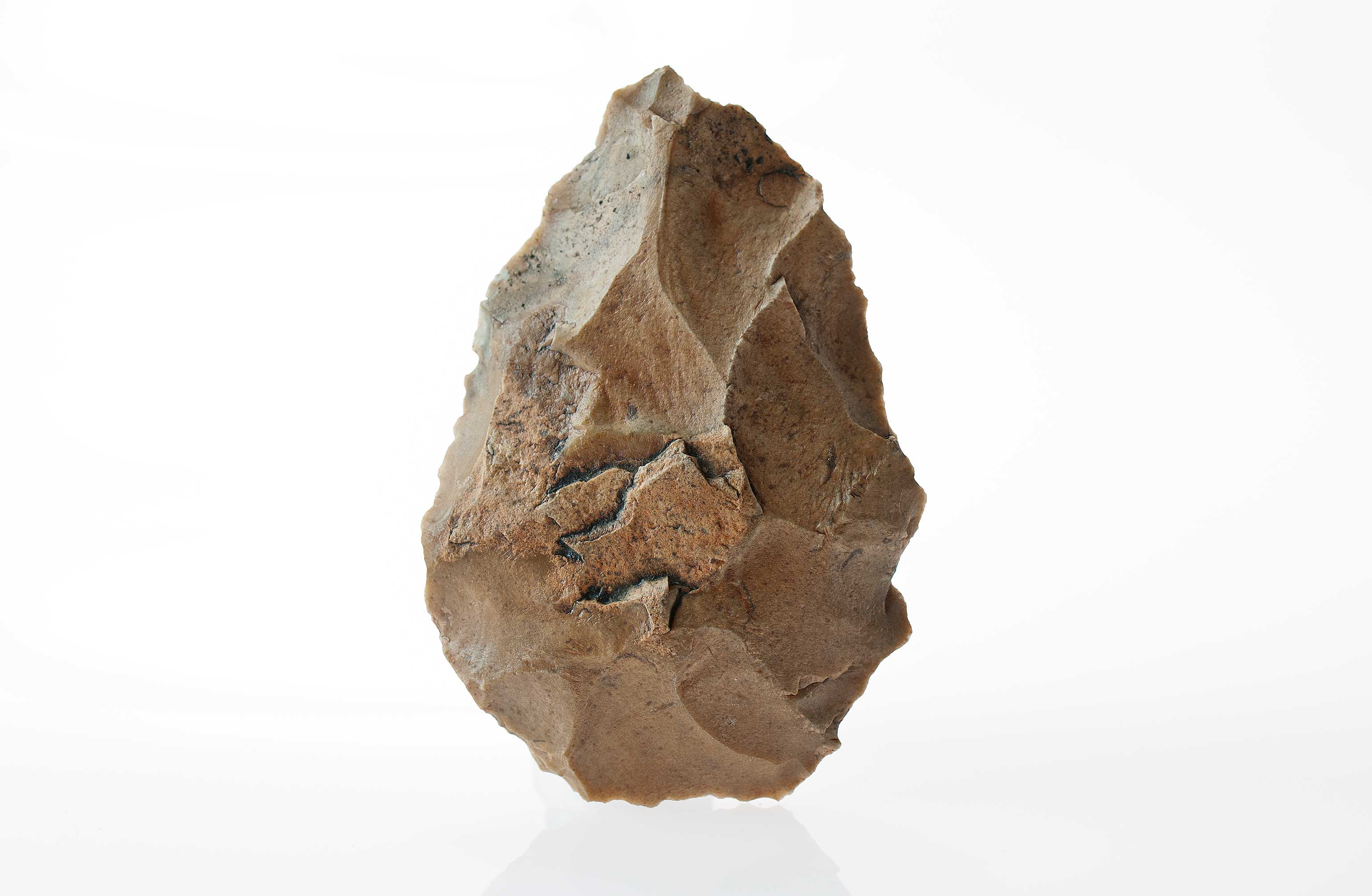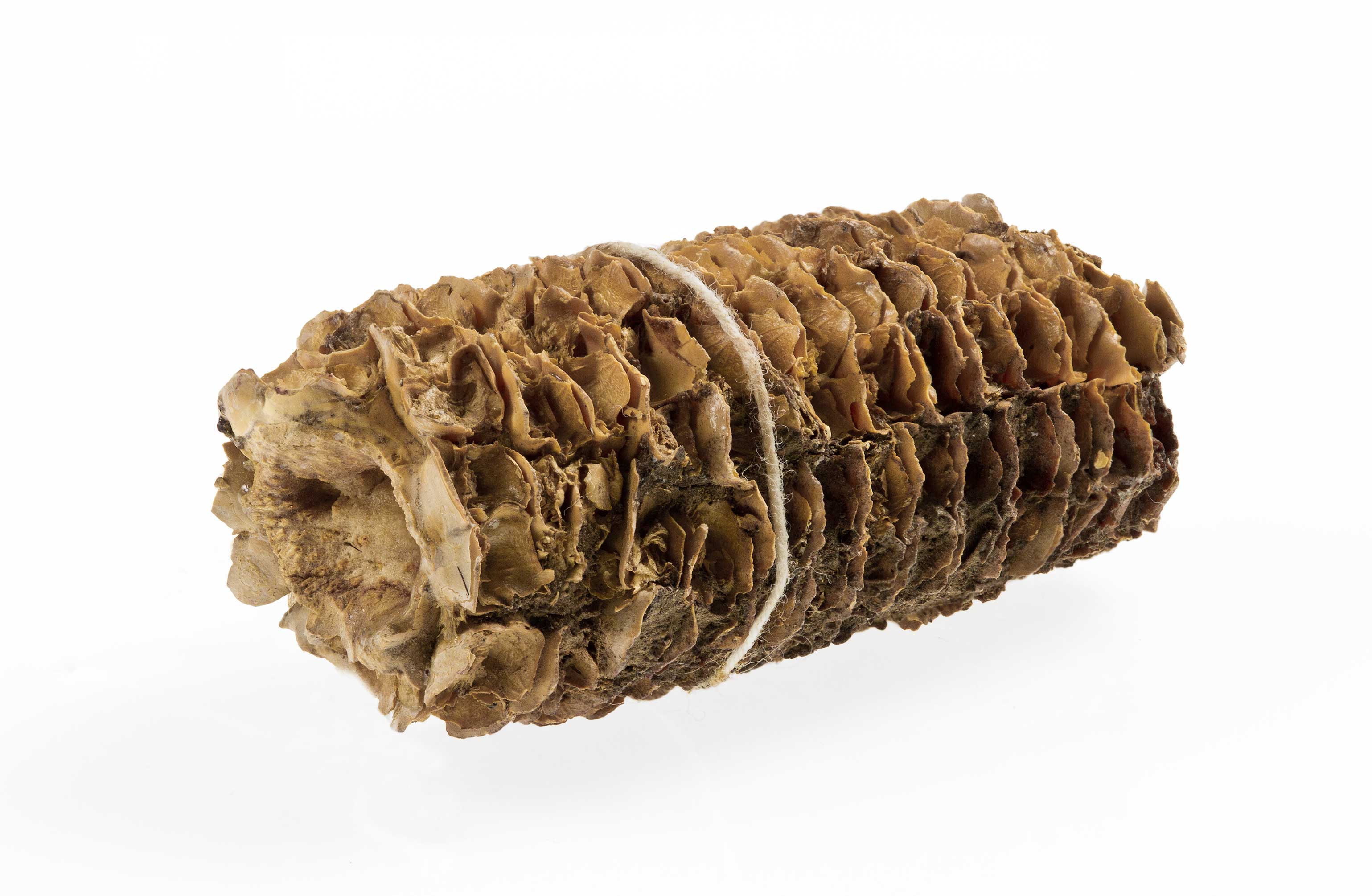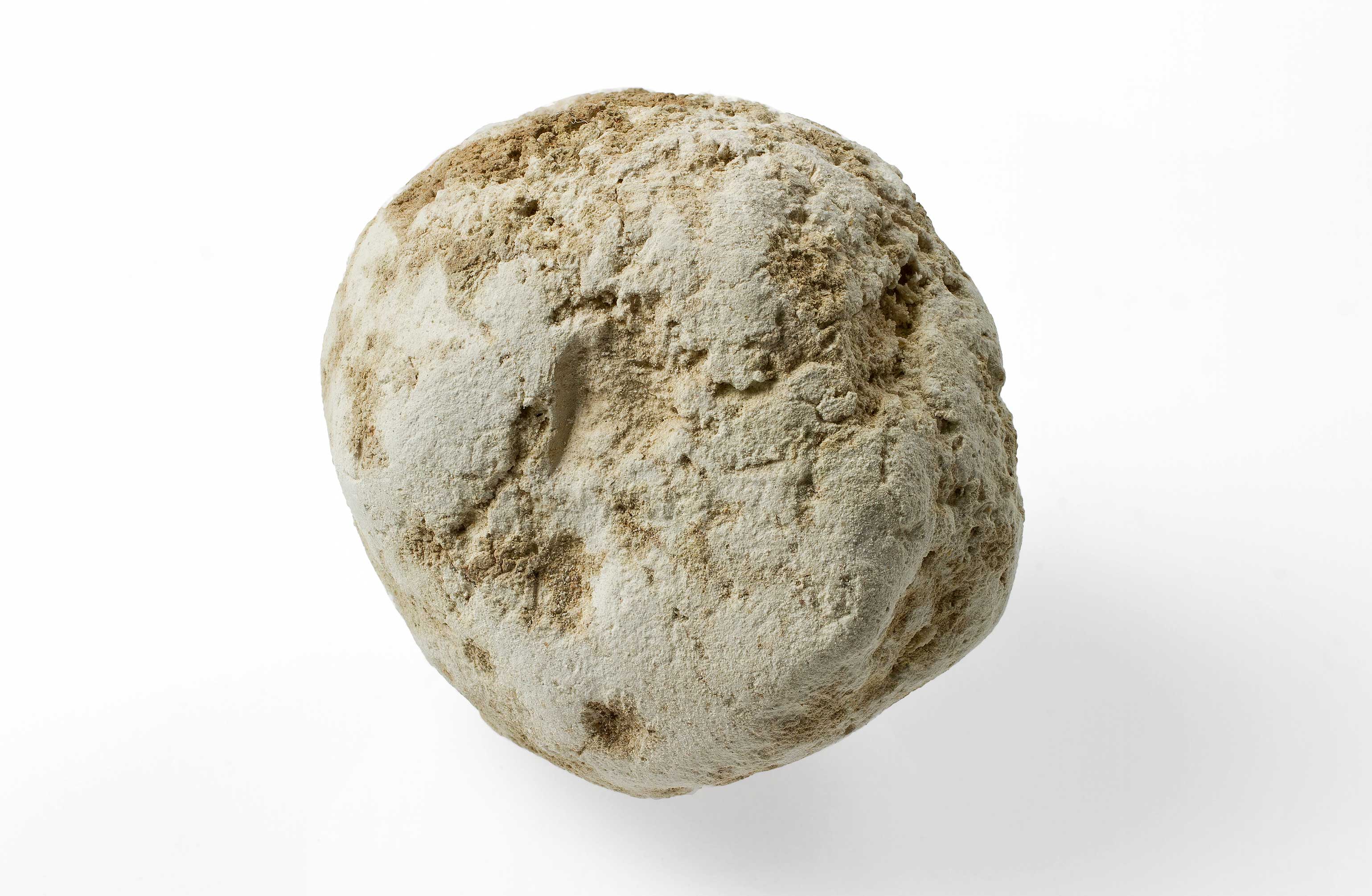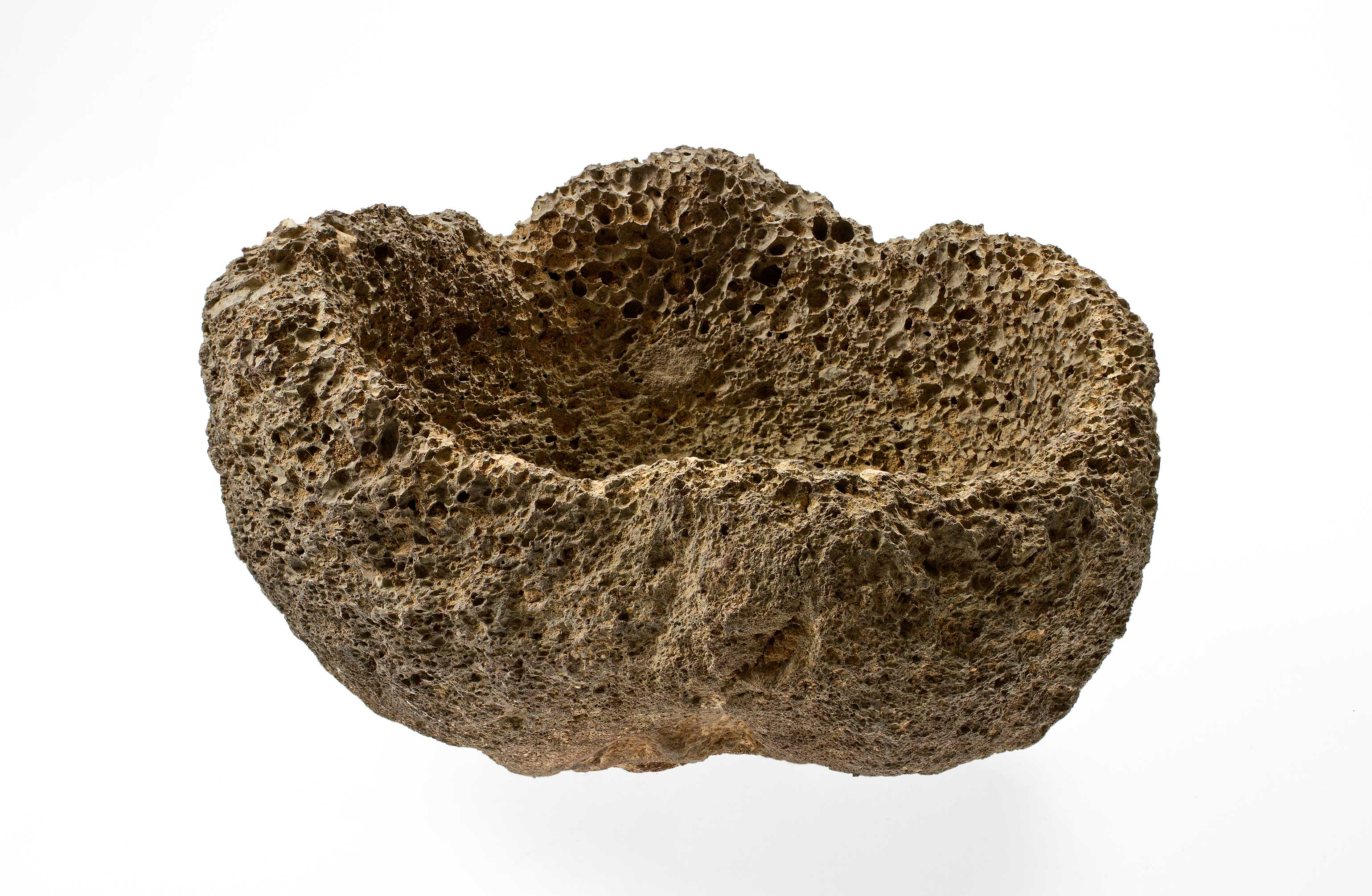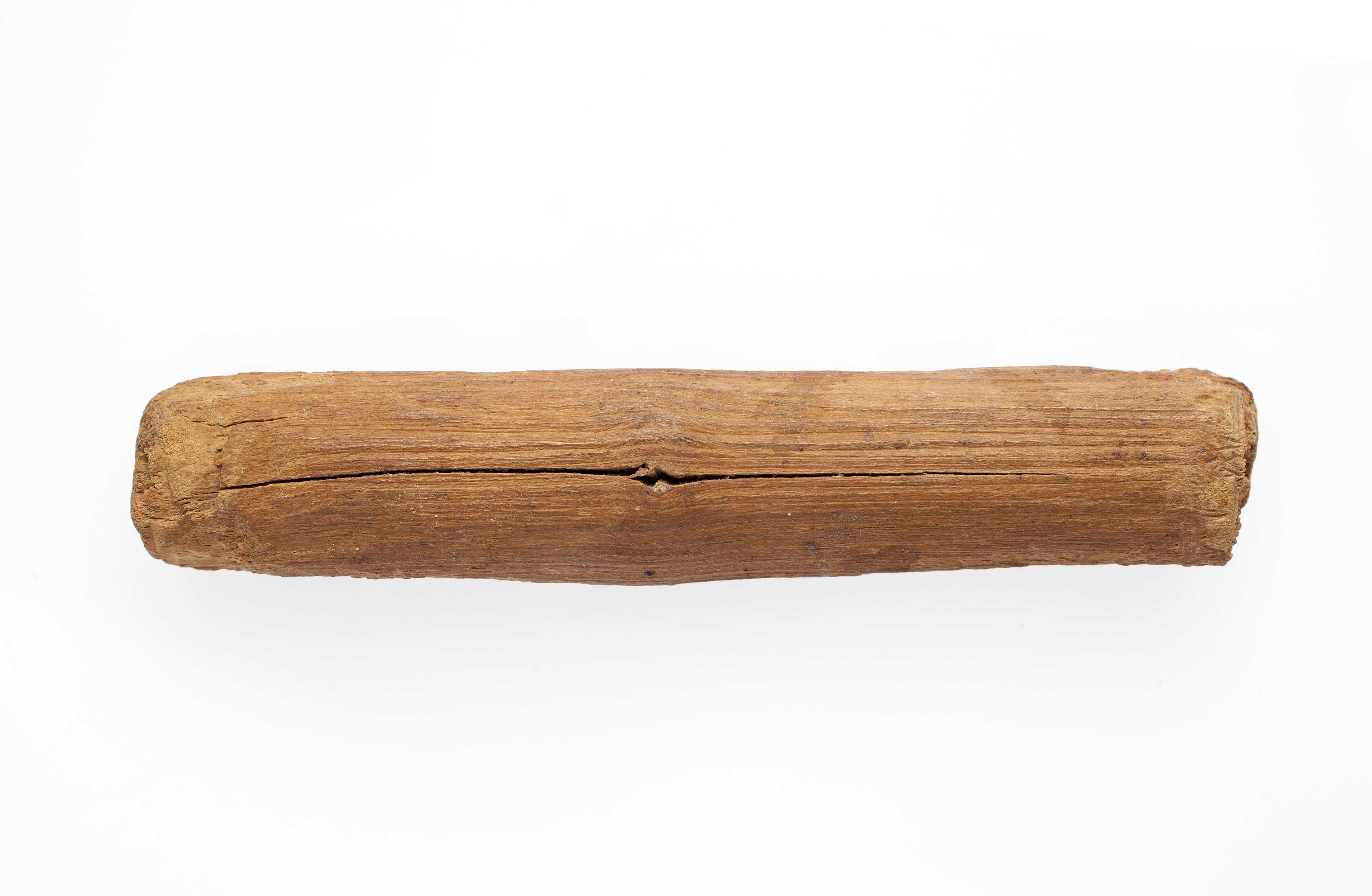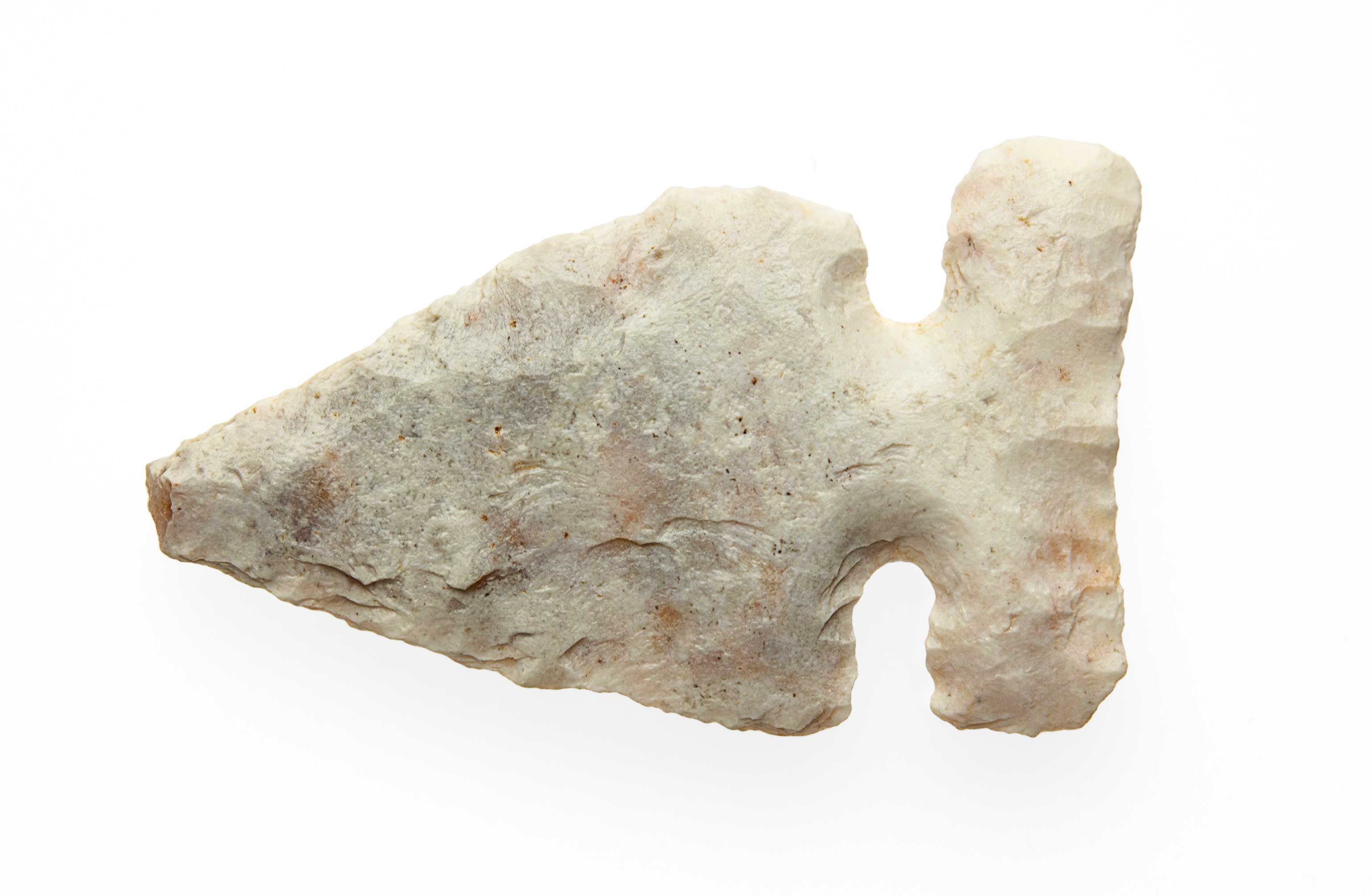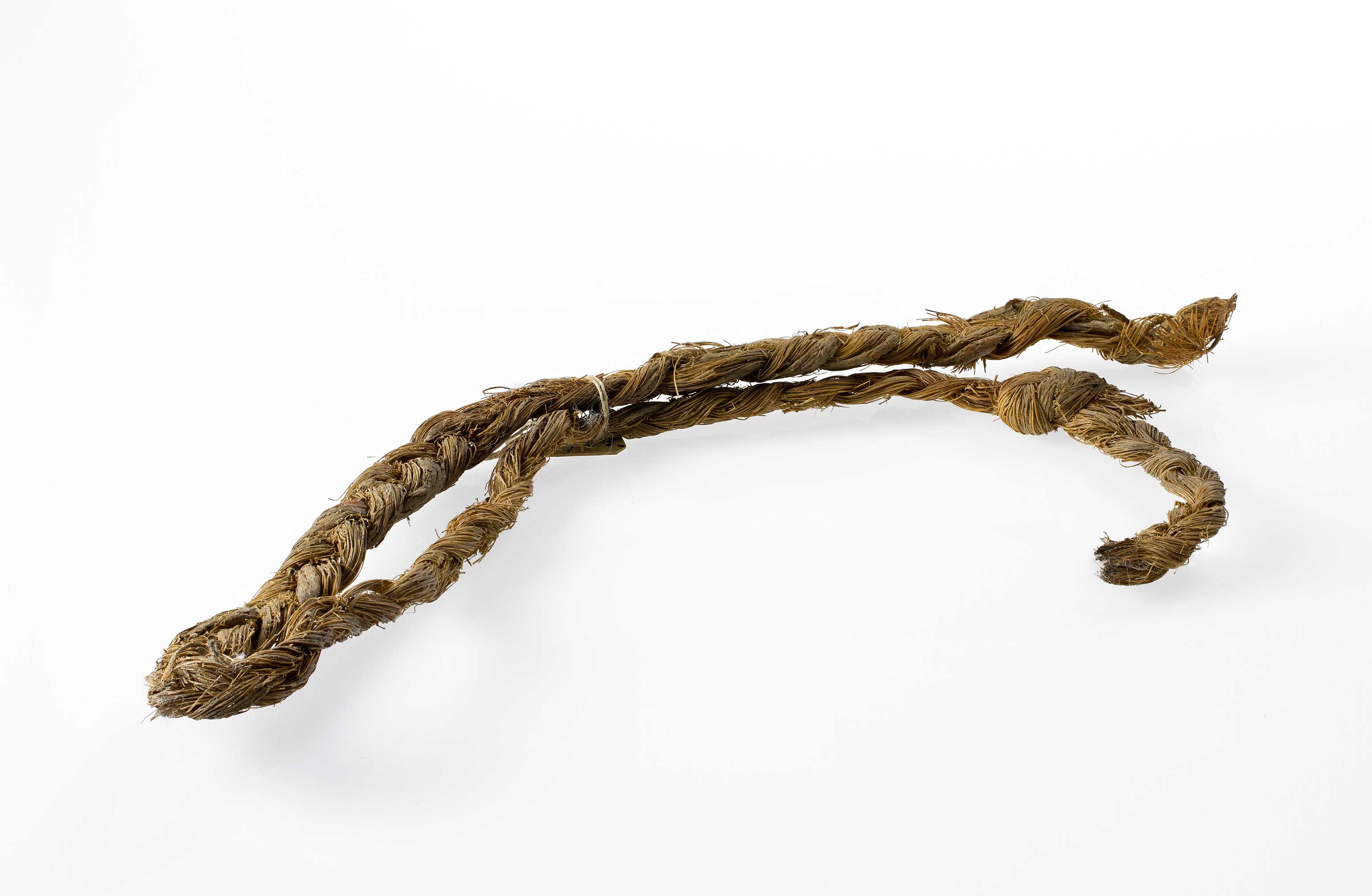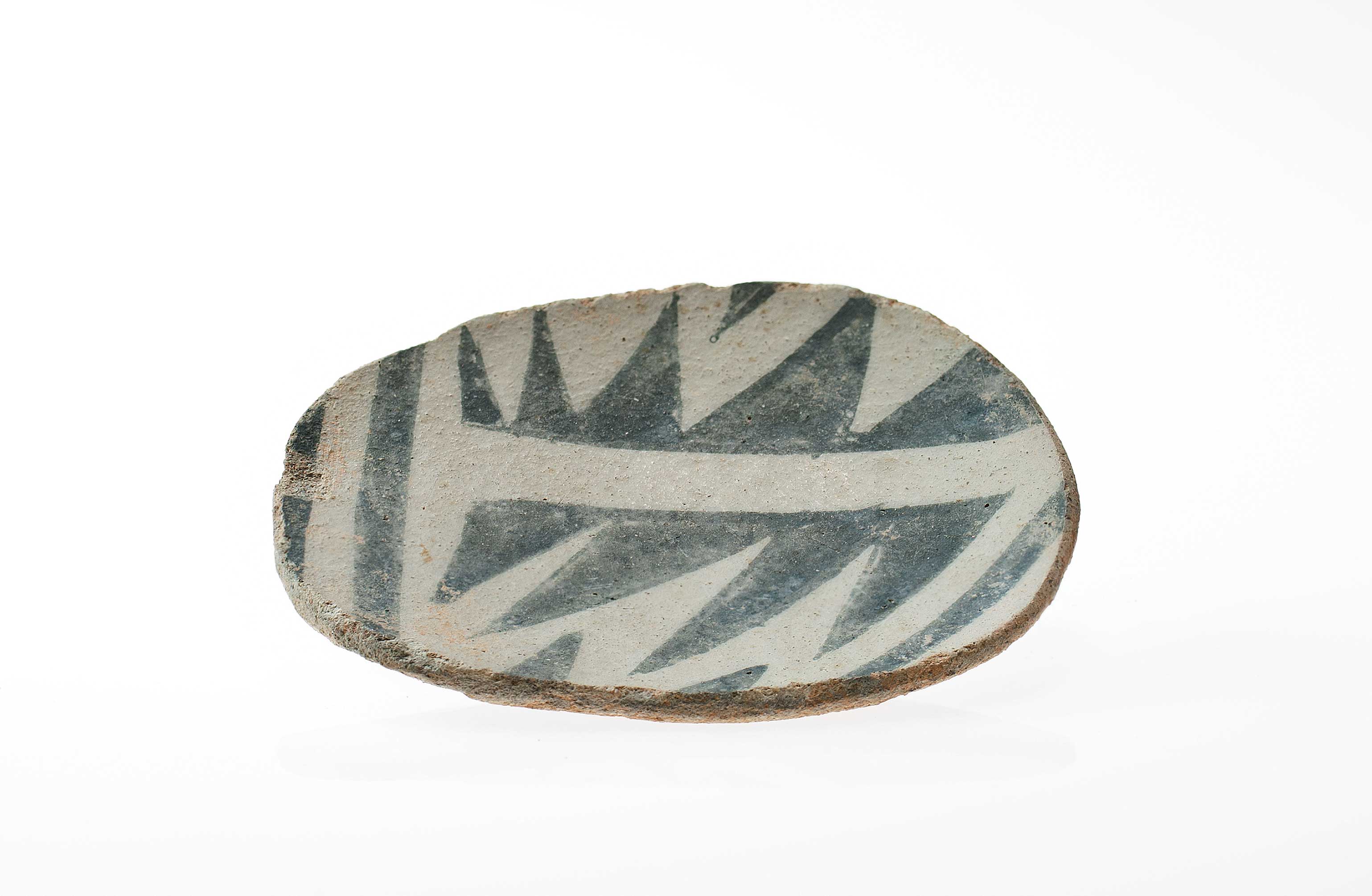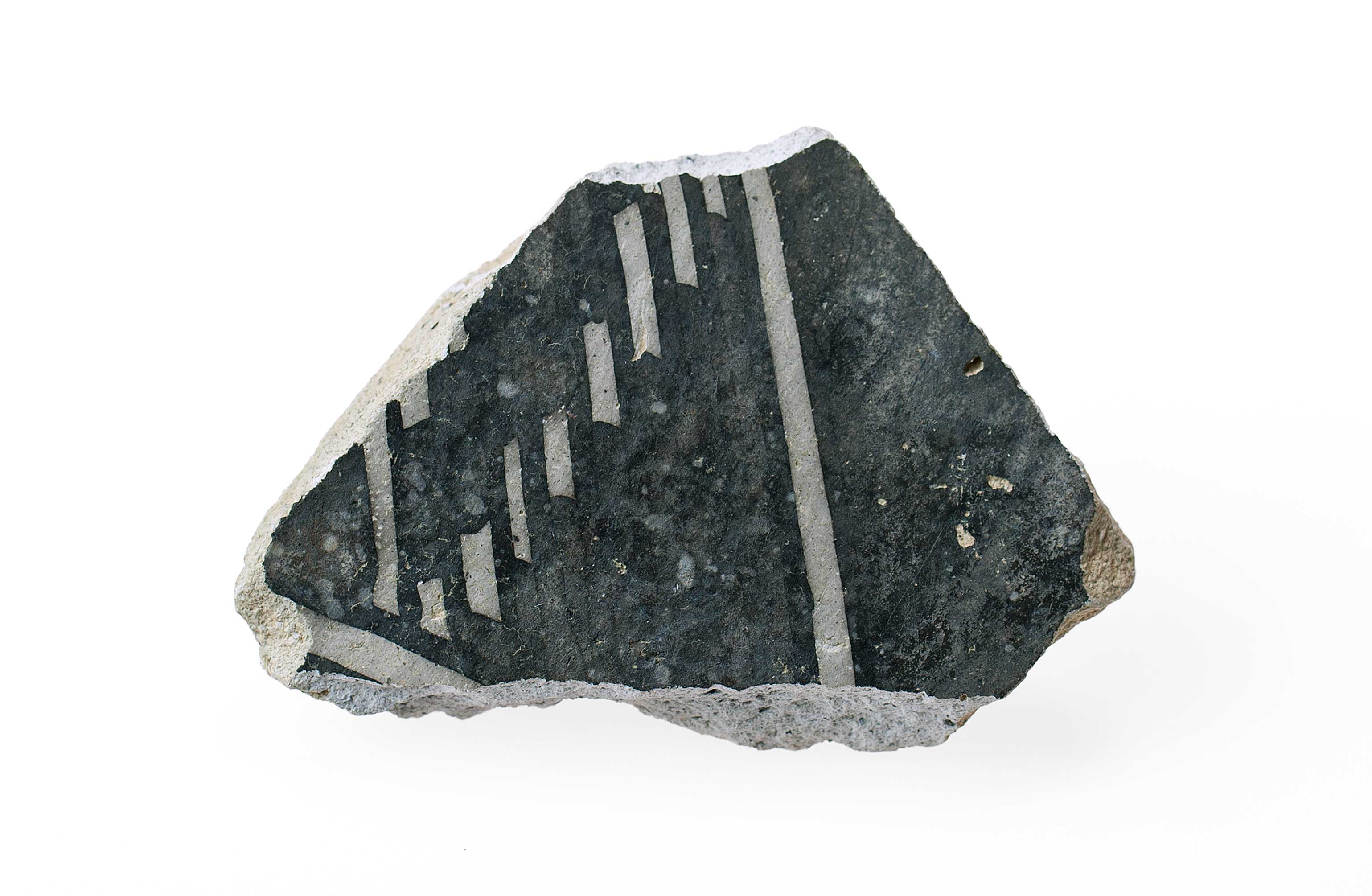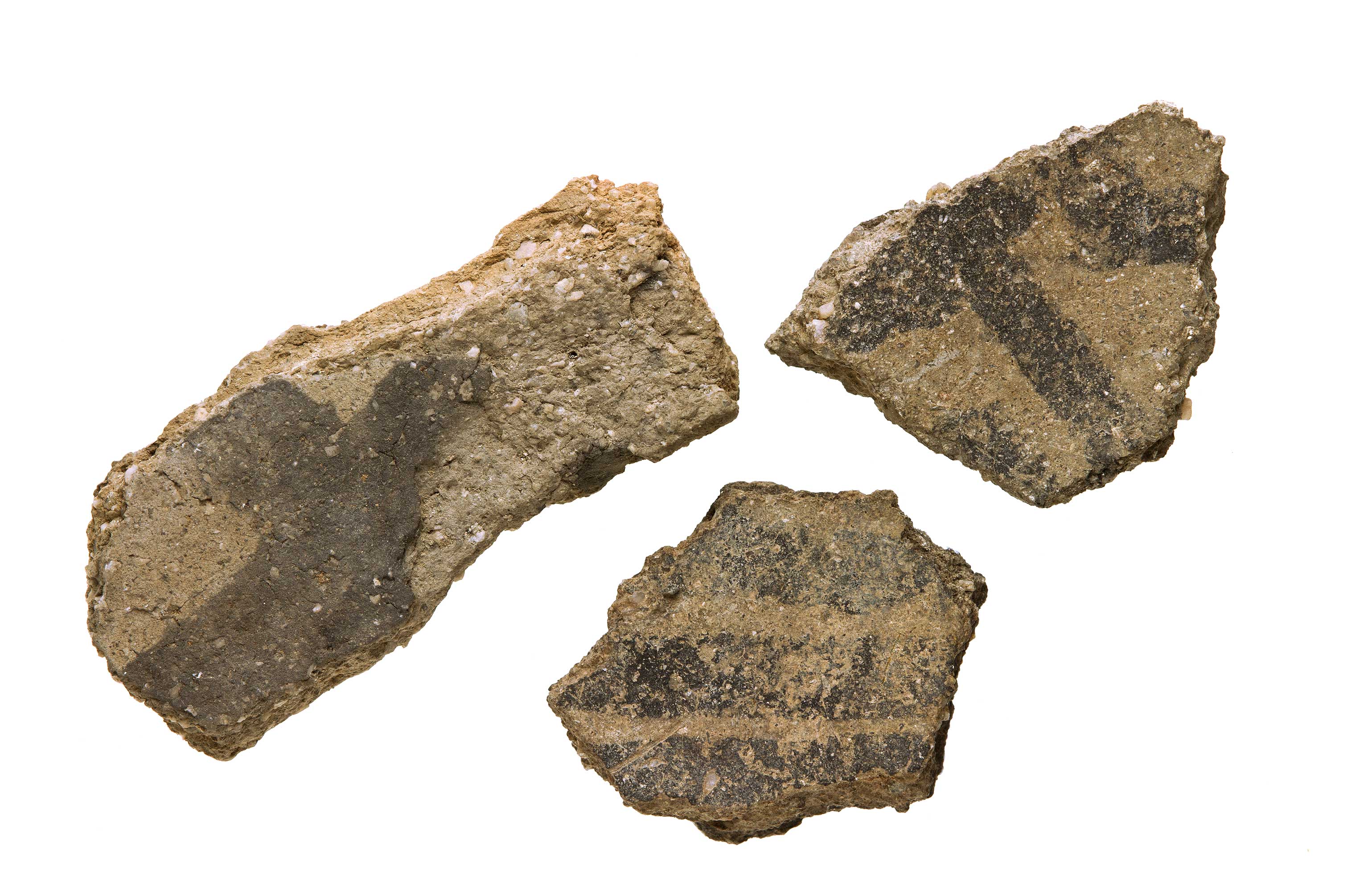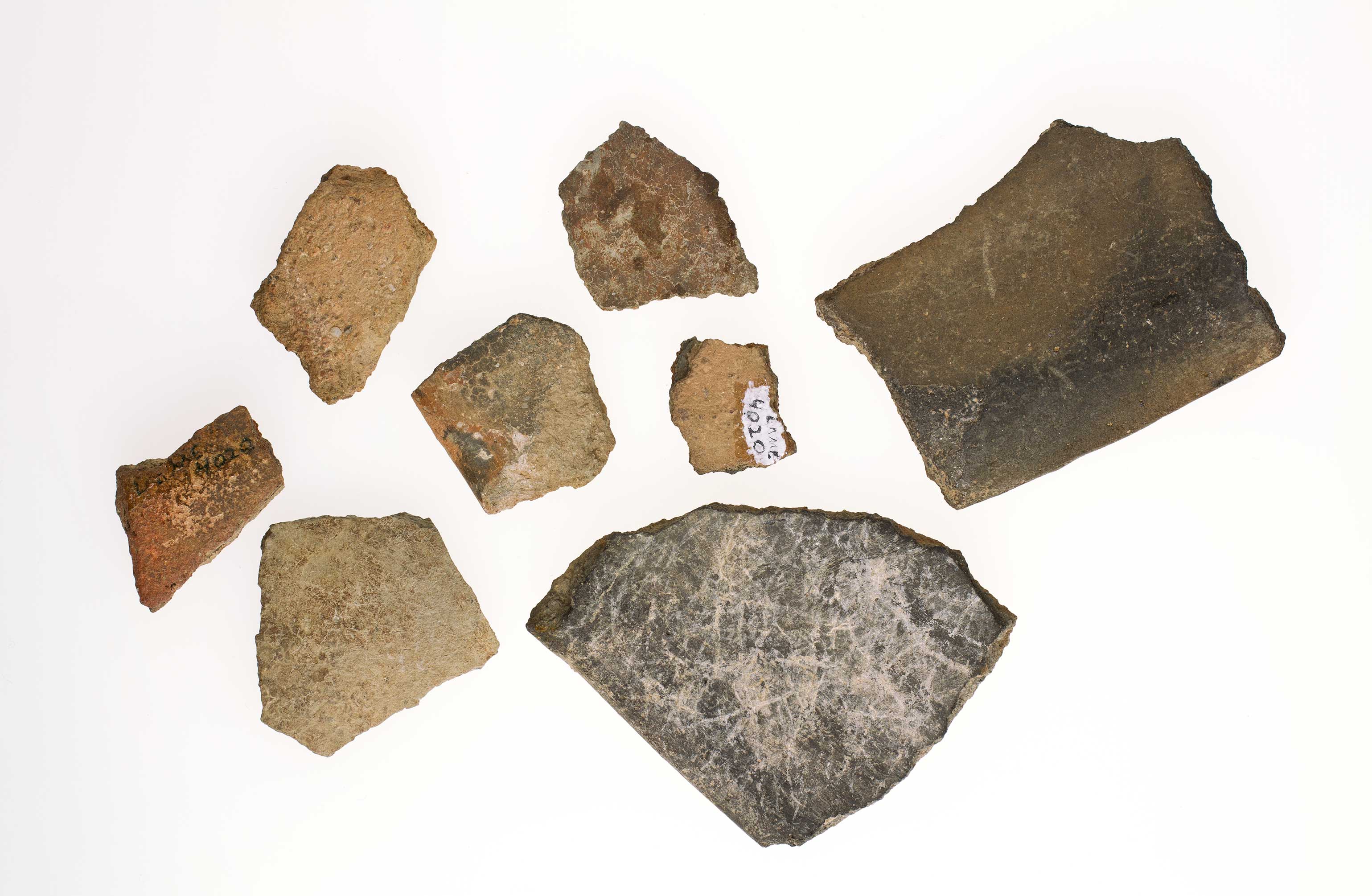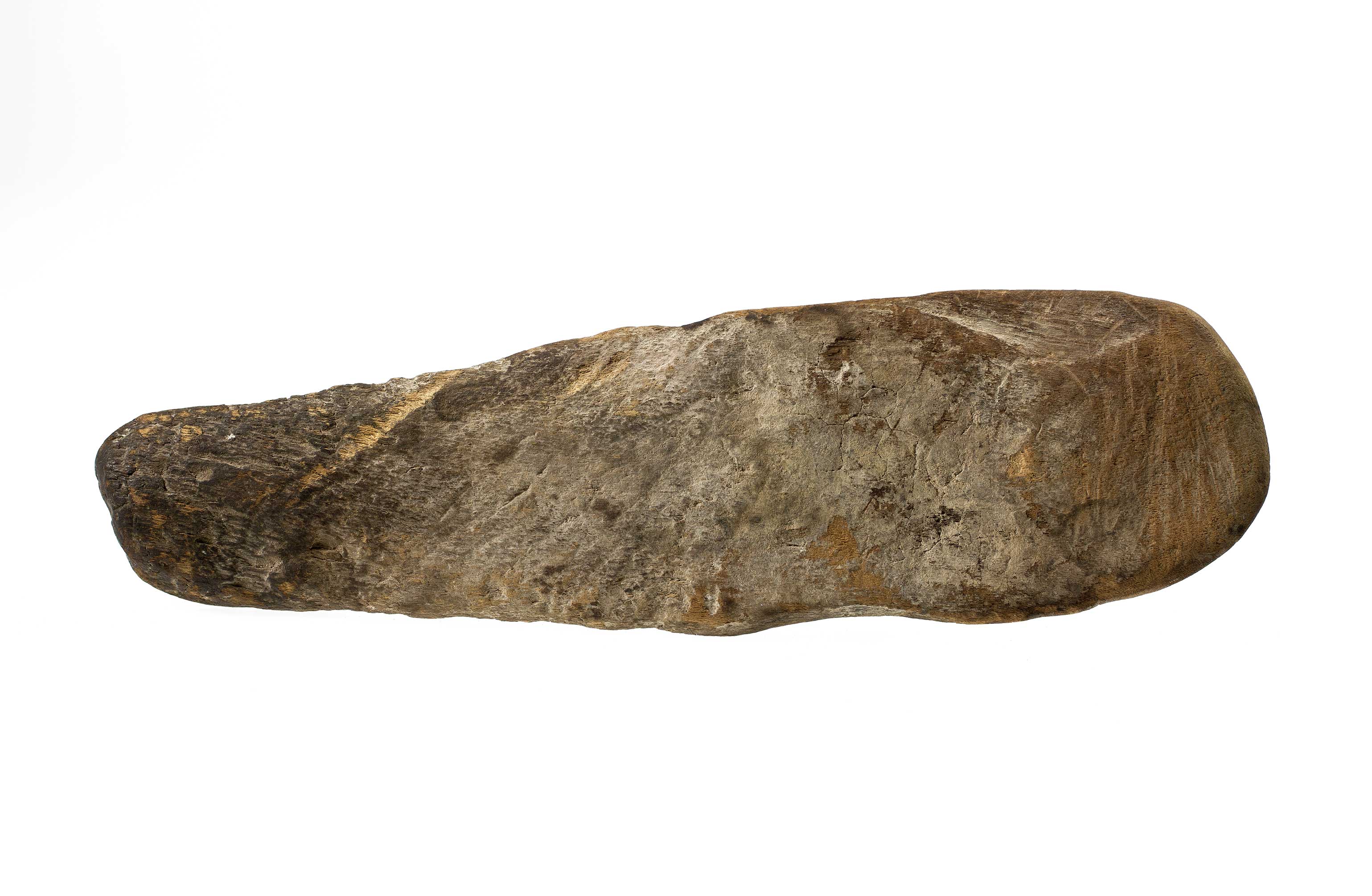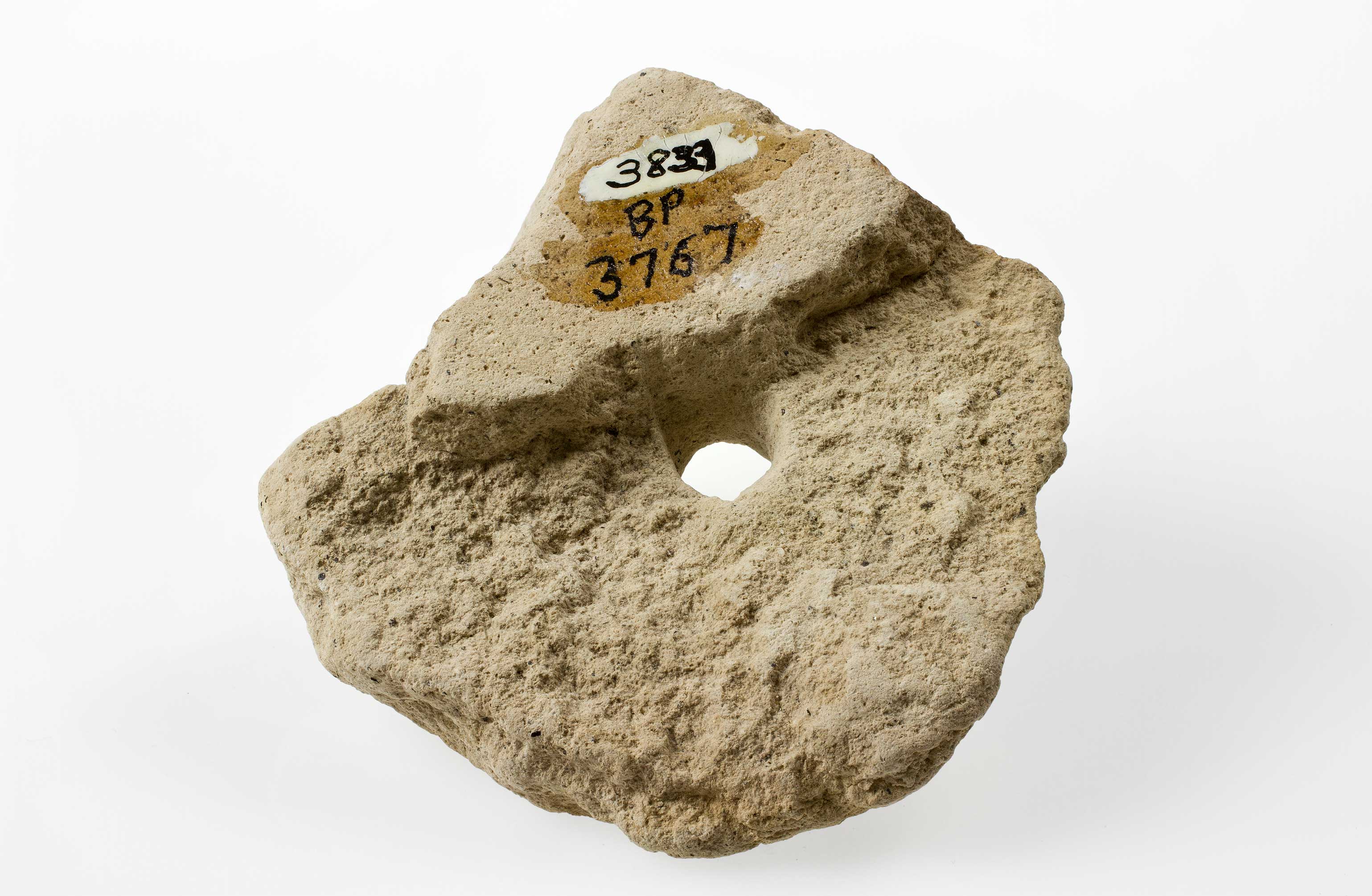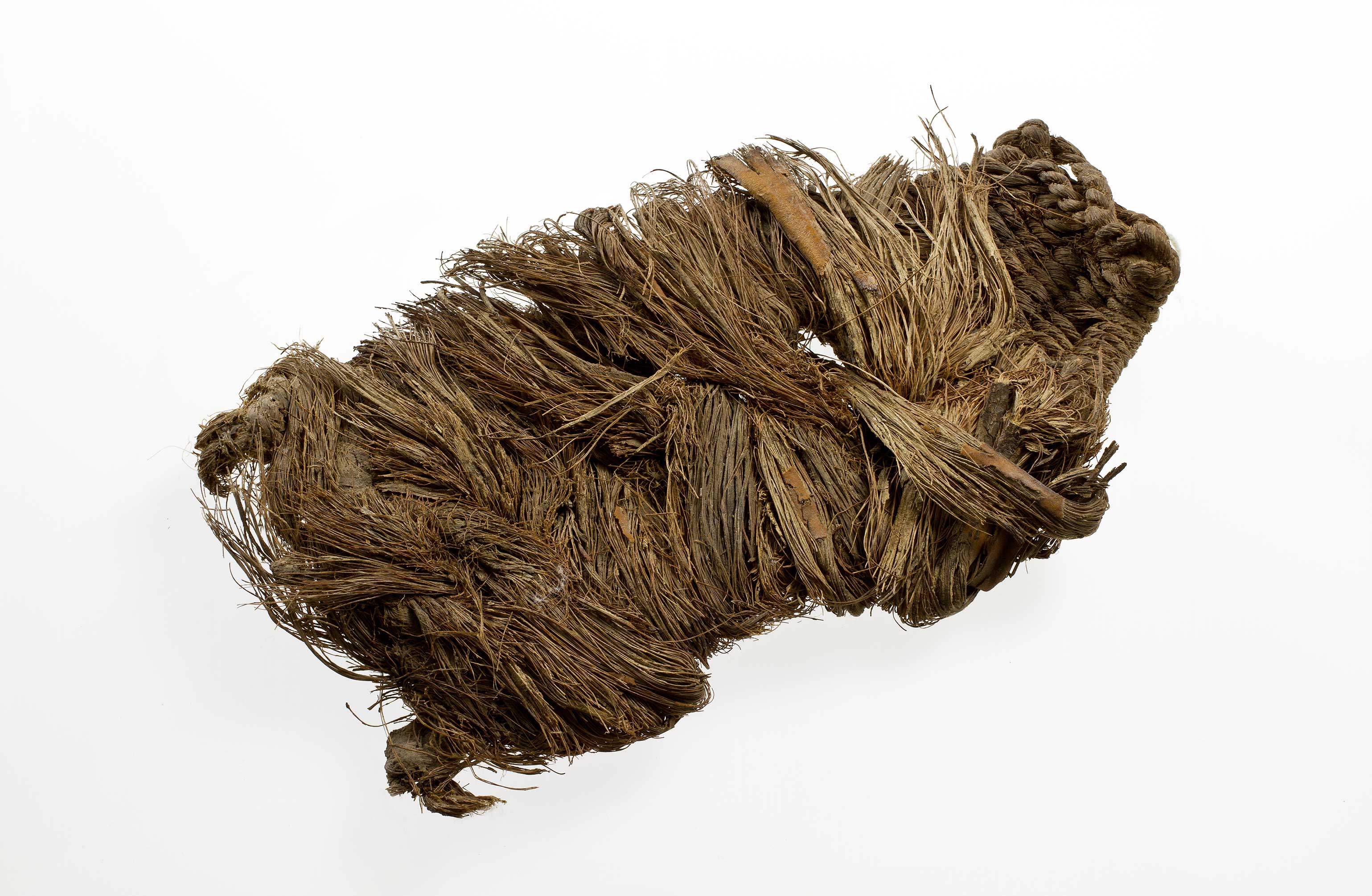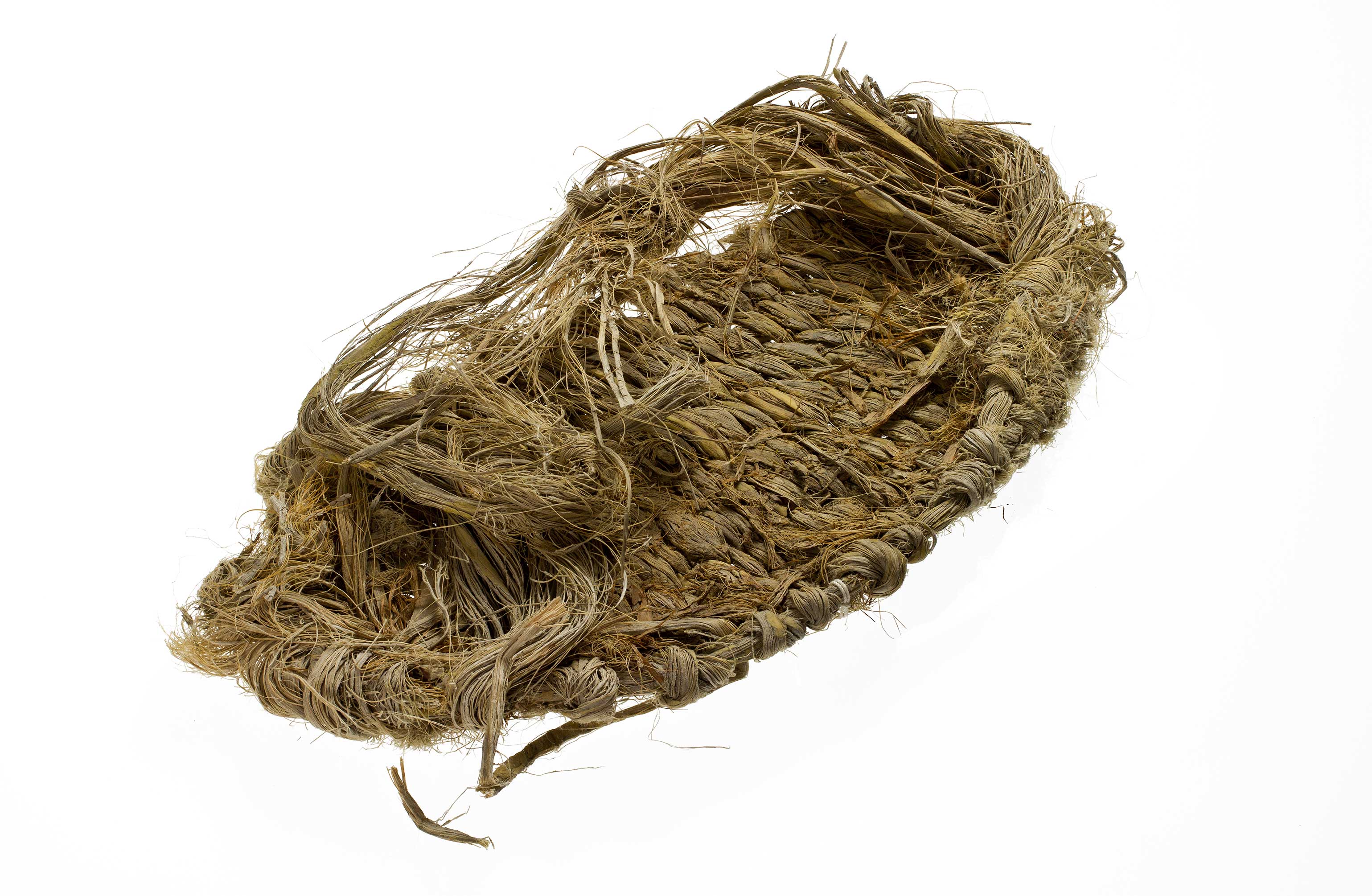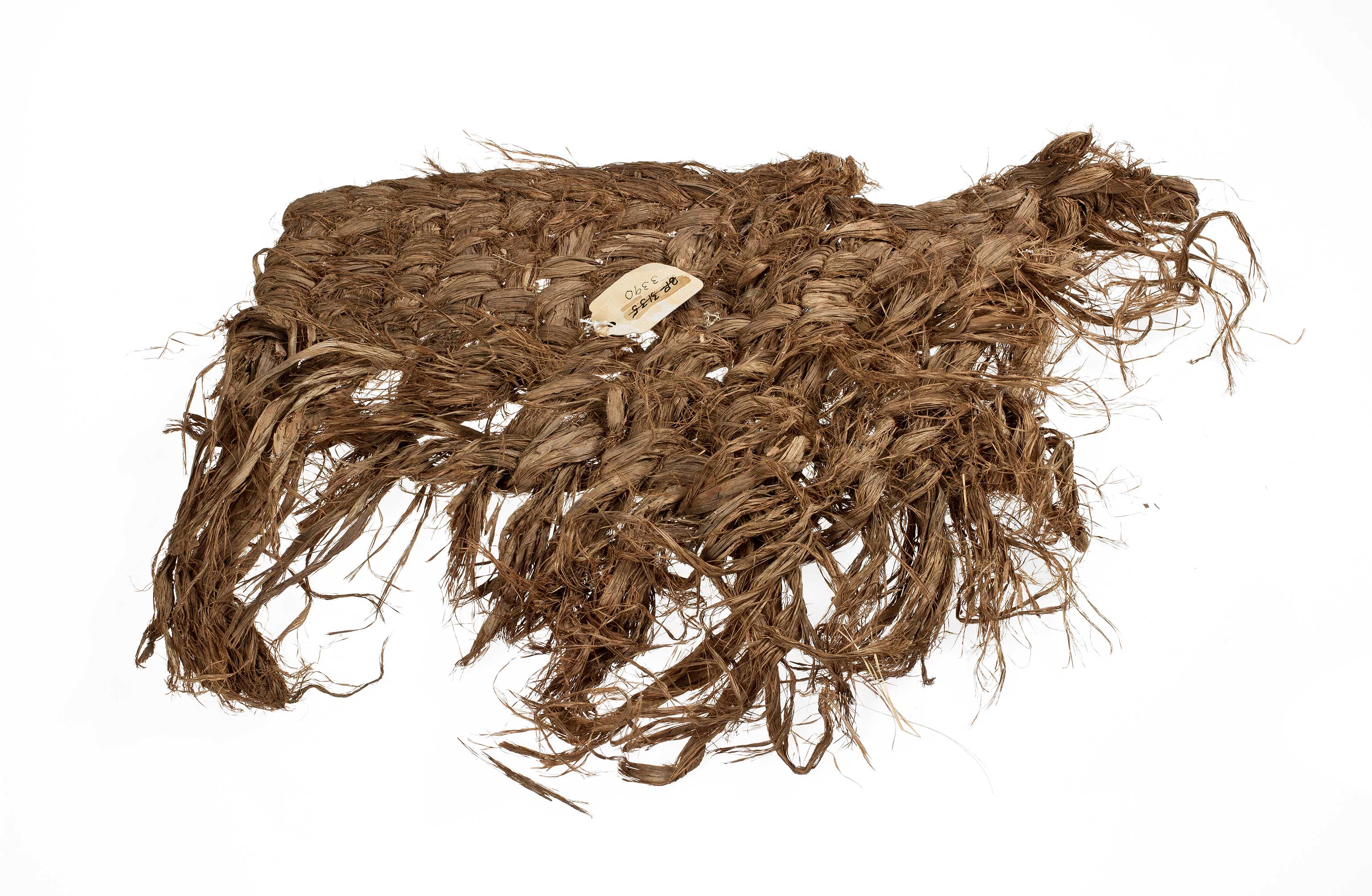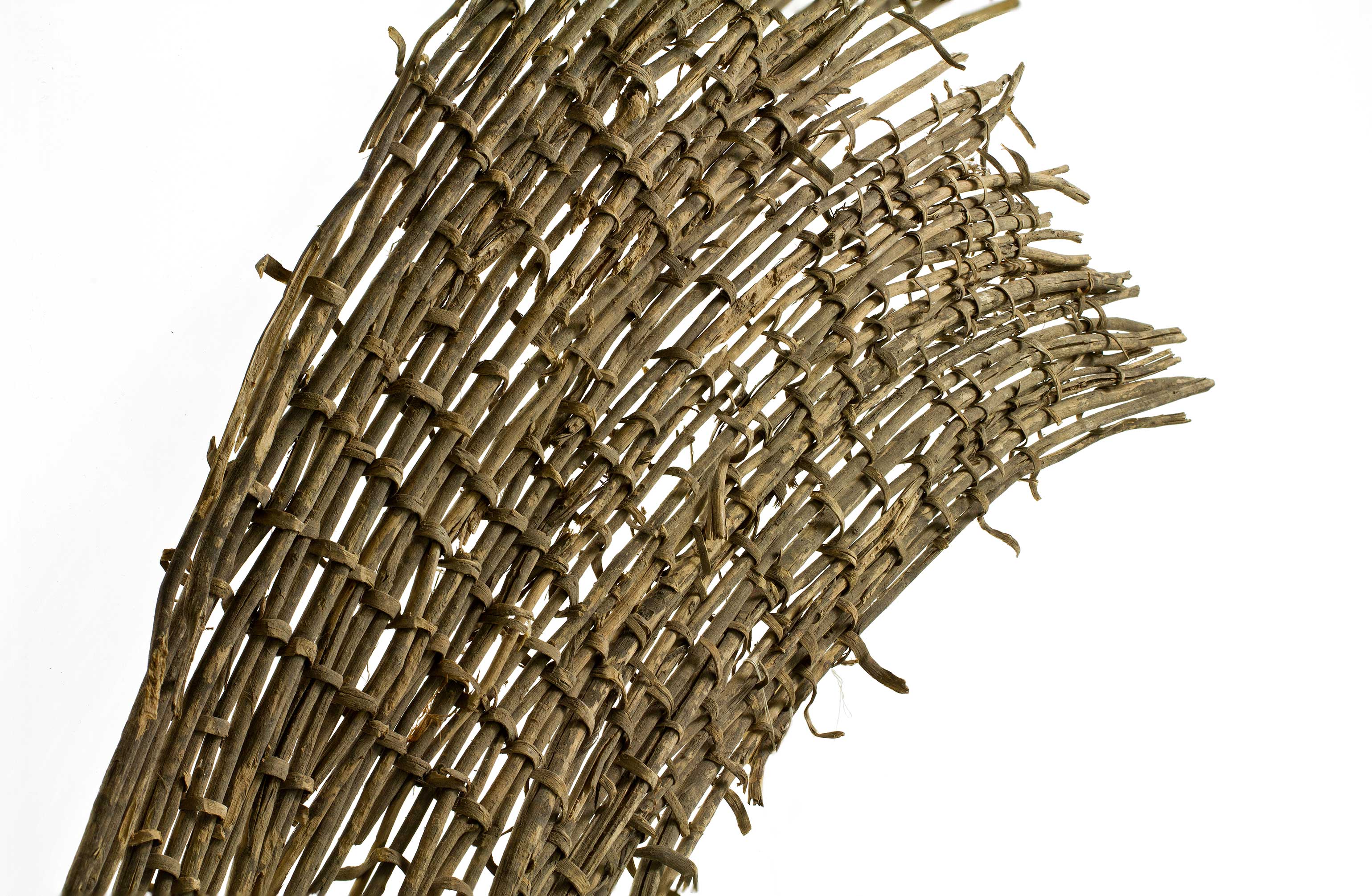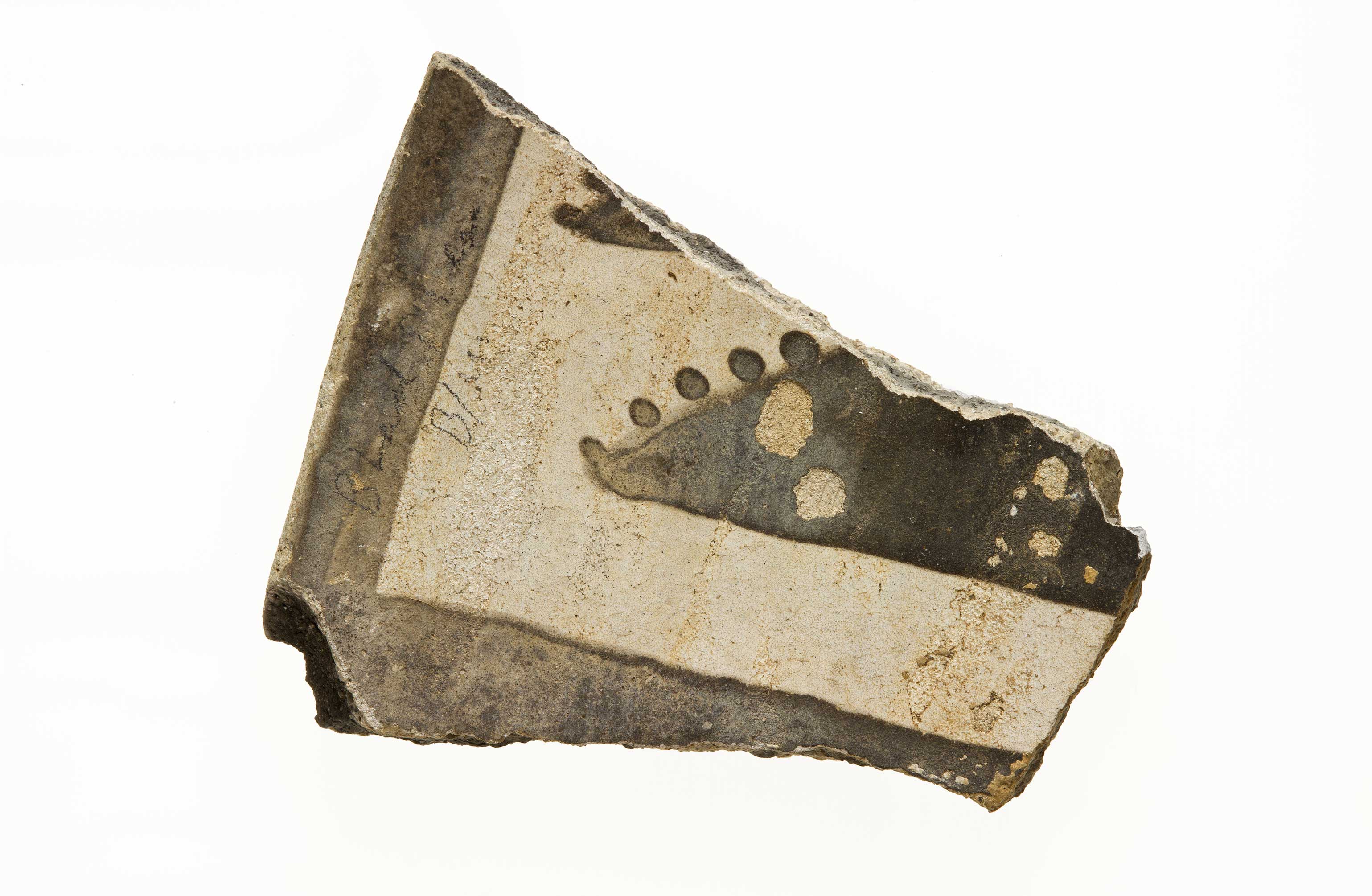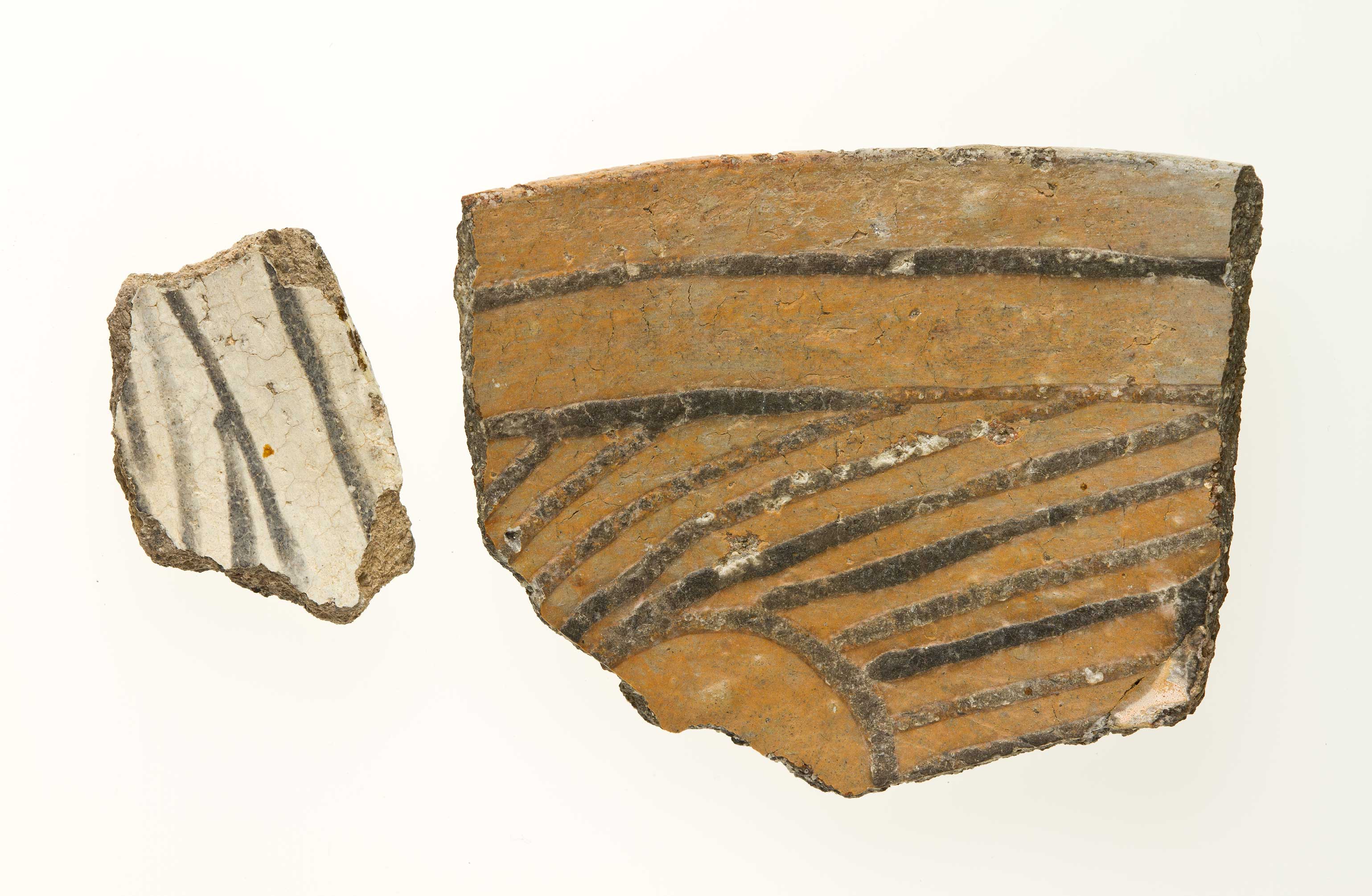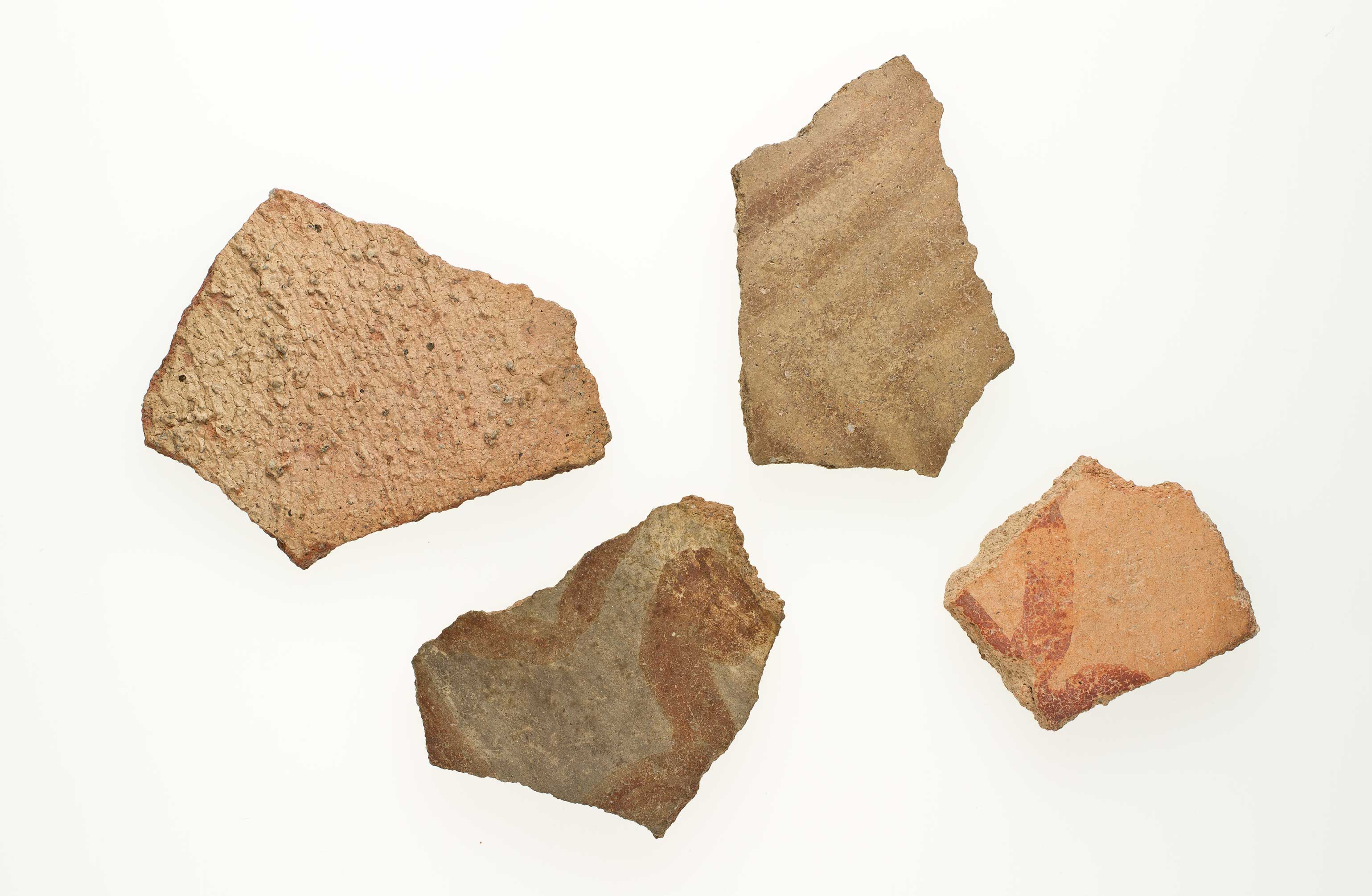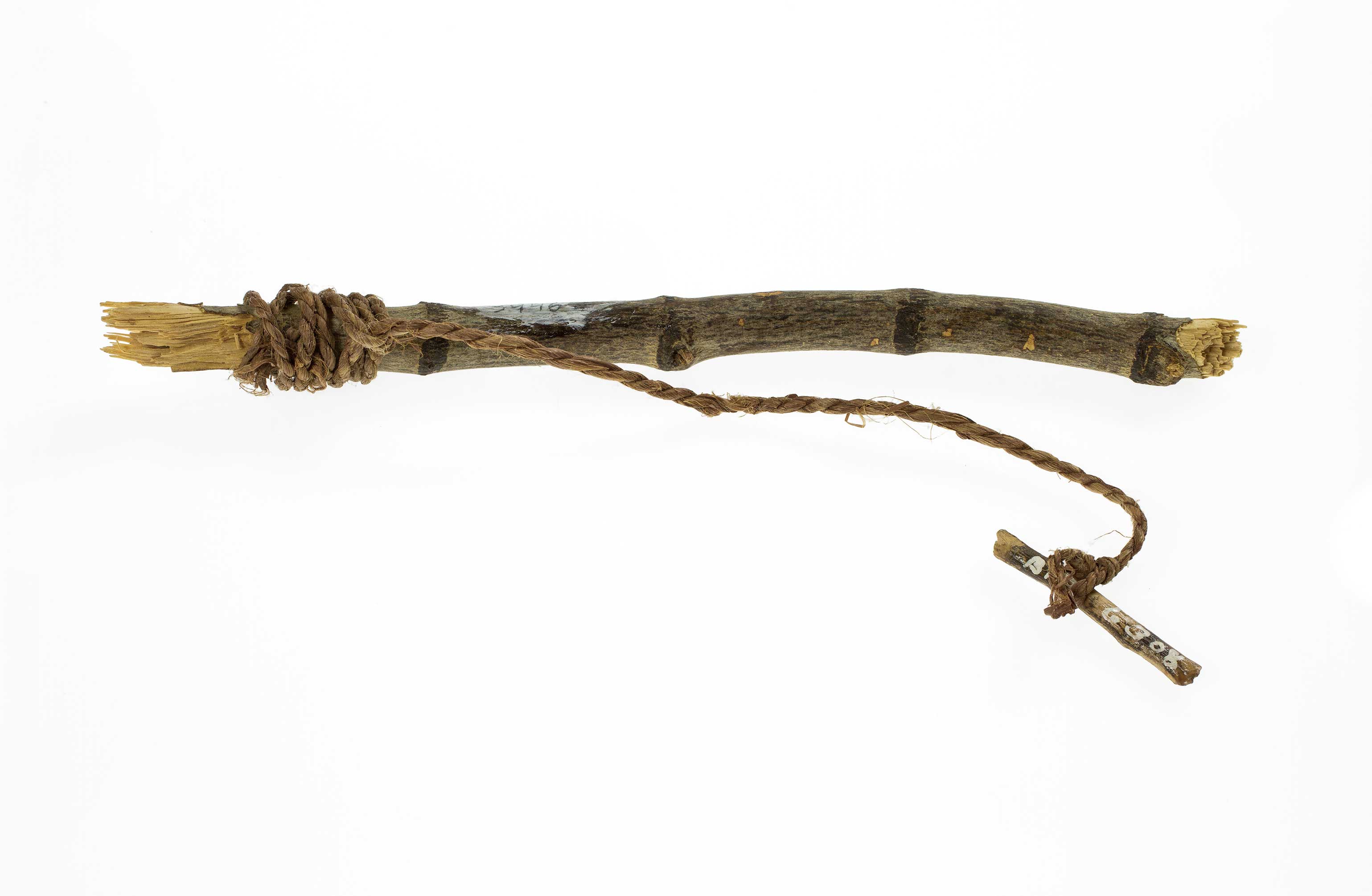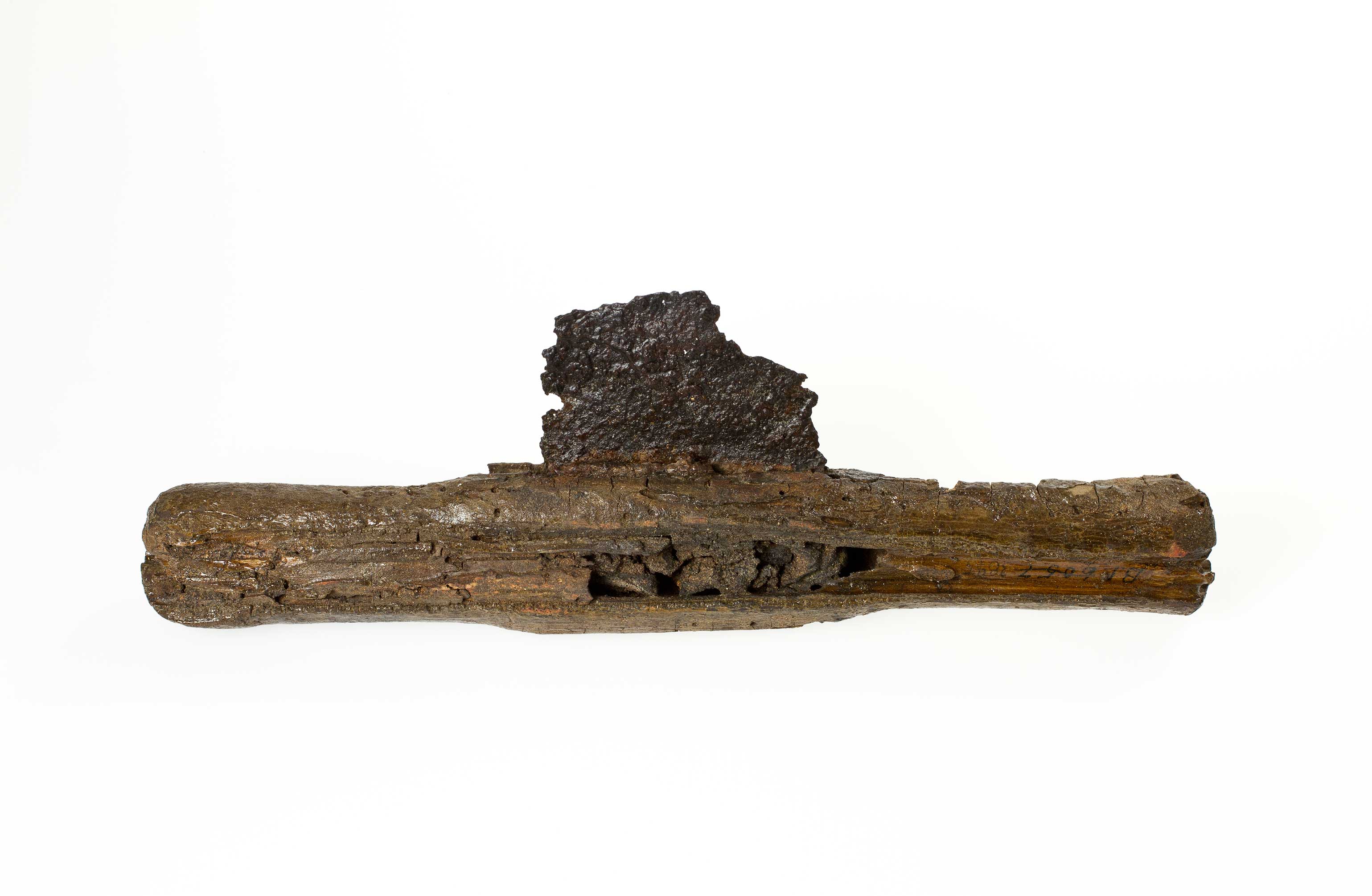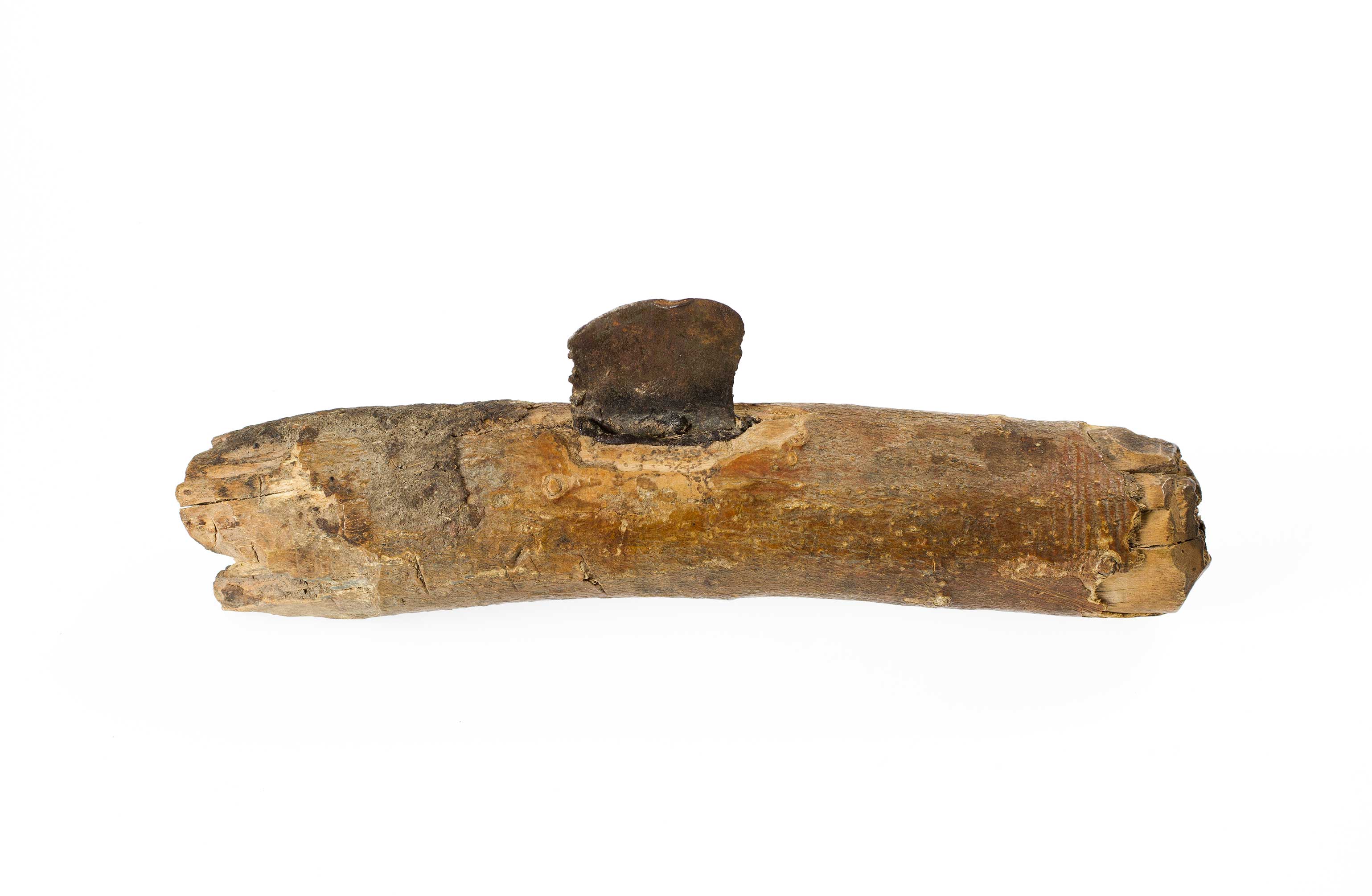Awl Fragments
Bone
Circa Pueblo II Period AD 900-1150
Top: L 5cm; Middle: L 7.5cm; Bottom: L 6.4cm
Awls were used to pierce leather or skins, as well as for sewing. To manufacture bone awls, one end of a pencil-shaped bone was tapered to form a point.
Photographer: Andy Cattoir
LAKE 3468 (top), LAKE 3467 (middle), and LAKE 3466 (bottom)
Projectile Points
A: Unidentified projectile point C: Unidentified projectile point B and D: Desert Side-Notched Projectile Point AD 1150 to 1850
A: L 3.0cm, W 0.9cm; B: 2.5cm, 1.5cm; C: L 2.7, W 0.9cm; D: L 2.0cm, W 1.0cm
The Paiutes settled in the area of the Colorado River, including Southern Nevada, California, Utah, and Northern Arizona, around A.D. 1100-1200. The Paiutes mainly subsisted on hunting and gathering, as well as some irrigation agriculture.
Photographer: Andy Cattoir
LAKE 3605 (A), LAKE 3366 (B), LAKE 3603 (C); LAKE 3354 (D)
Arrow Shaft
Wood
Circa: Prehistoric Period 10,000 B.C. - AD 1850
L 4.0cm, W 0.5cm
Photographer: Andy Cattoir
LAKE 3428
Projectile Point
Circa: Prehistoric Period 10,000 B.C. - AD 1850
L 2.5 cm, W 1 cm
Native Americans chose the type of stone to work with based on its suitability for a particular purpose, durability, and accessibility.
Photographer: Andy Cattoir
LAKE 3896
Projectile Point
Circa: 7000 to 1300 B.C.
L 4.2 cm, W 2.1cm
Elko Eared projectile point.
Photographer: Andy Cattoir
LAKE 3903
Projectile Point Tip
Stone
Circa: Prehistoric Period 10,000 B.C. - AD 1850
L 3.6 cm, W 1.3cm
Photographer: Andy Cattoir
LAKE 3911
Dart Point
Stone
Circa: Prehistoric Period 10,000 B.C. - AD 1850
L 6.8 cm, W 1.3cm
Photographer: Andy Cattoir
LAKE 3916
Red-on-Buff Bowl
Ceramic
Circa: Prehistoric Period 10,000 B.C. - AD 1850
H 7.8cm, D 19cm, Base D 10cm
Photographer: Andy Cattoir
LAKE 23072
Red-on-Buff Bowl
Ceramic
Circa: Prehistoric Period 10,000 B.C. - AD 1850
H 7.8cm, D 19cm, Base D 10cm
Photographer: Andy Cattoir
LAKE 23072
Mano
Fine-grained Basalt
Circa: Pueblo II AD 900-1150
L 11cm, W 56cm
Mano is Spanish for hand. They were used as a grinding stone to grind foodstuffs, such as corn kernels into a paste or flour before cooking. Manos were used in conjunction with a metate.
Photographer: Andy Cattoir
LAKE 3845
Bird-Shaped Pendant
Bone
Circa: Prehistoric Period 10,000 B.C. - AD 1850
4.3 x 1.2 x 2.1cm
Photographer: Andy Cattoir
LAKE 3552
Pendant
Shell
Circa: Prehistoric Period 10,000 B.C. - AD 1850
L 3.0cm, W 3.15cm
Photographer: Andy Cattoir
LAKE 3472
Pendant
Bone
Circa: Prehistoric Period 10,000 B.C. - AD 1850
L 3.0cm, W 0.4cm
Photographer: Andy Cattoir
LAKE 3455
Pendant
Shells
Circa: Prehistoric Period 10,000 B.C. - AD 1850
Shell 2.0cm, D 14cm
Photographer: Andy Cattoir
LAKE 3333
Pendant
Abalone shell
Circa: Pueblo II Period AD 900-1150
4.8 x 4 x 4cm
Photographer: Andy Cattoir
LAKE 3458
Pendant
Shell
Circa: Prehistoric Period 10,000 B.C. - AD 1850
3.0 x 2.8cm
Photographer: Andy Cattoir
LAKE 3461
Pitcher
Ceramic
Circa: Prehistoric Period 10,000 B.C. - AD 1850
H 22cm, Base D 18cm, Mouth D 9.5cm
Photographer: Andy Cattoir
LAKE 2238
Paiute Snare
Wood and yucca fibers
Circa: 1830s
L 9cm, D 0.95cm
Photographer: Andy Cattoir
LAKE 3510
Pot
Ceramic
Circa: Prehistoric Period 10,000 B.C. - AD 1850
H 15cm, Mouth D 8cm, Base D 10cm
Photographer: Andy Cattoir
LAKE 23075
Pot
Ceramic
Circa: Prehistoric Period 10,000 B.C. - AD 1850
H 14cm, Mouth D 9.5cm, Base D 9cm
Photographer: Andy Cattoir
LAKE 23076
Pendant
Shell
Circa: Prehistoric Period 10,000 B.C. - AD 1850
L 3.4cm, W 2.8cm
Photographer: Andy Cattoir
LAKE 3470
Grooved Arrow Shaft Straightener
Circa: Pueblo II AD 900-1150
L 7.5cm
This grooved sandstone was used to straighten and shape arrow shafts.
Photographer: Andy Cattoir
LAKE 3827
Notched Stone
Granite or sandstone
Circa: Pueblo II Period AD 900-1150
L 7-9cm
Photographer: Andy Cattoir
LAKE 3828
Olivella Shells
Circa: Prehistoric Period 10,000 B.C. - AD 1850
L 2cm, W 1cm
Olivella shells were popular among the Ancestral Pueblo people to make beads for jewelry.
Photographer: Andy Cattoir
LAKE 3302
Painted Wood Fragment
Wood
Circa: Prehistoric Period 10,000 B.C. - AD 1850
3.5cm x 1.8cm
Photographer: Andy Cattoir
LAKE 3356
Pendant
Shell
Circa: Prehistoric Period 10,000 B.C. - AD 1850
L 2.6cm
Photographer: Andy Cattoir
LAKE 3323
Grooved Axe
Circa: Prehistoric Period 10,000 B.C. - AD 1850
L 14cm, Circumference 19cm
The groove in the middle of the fine-grained basalt is where a wooden handle would have been tied to the axe.
Photographer: Andy Cattoir
LAKE 3671
Grooved Axe
Circa: Prehistoric Period 10,000 B.C. - AD 1850
L 14cm, Circumference 19cm
The groove in the middle of the fine-grained basalt is where a wooden handle would have been tied to the axe.
Photographer: Andy Cattoir
LAKE 3671
Vessel Handle
Clay
Circa: Prehistoric Period 10,000 B.C. - AD 1850
L 2.3cm, W 1.5cm
Photographer: Andy Cattoir
LAKE 3930
Hatch Cover Fragment
Sandstone
Circa: Prehistoric Period 10,000 B.C. - AD 1850
L 15.5cm, W 8.5cm, H 3.5cm
Photographer: Andy Cattoir
LAKE 15025
Hearth Stick Fragment
Circa: Prehistoric Period 10,000 B.C. - AD 1850
11 x 1.7 x 0.8 cm
Hardwood sticks were used as drills, as they were spun on the hearth stick by hand or bow. This created friction and heat that were used to ignite tinder in campfires.
Photographer: Andy Cattoir
Lake 3430
Jug Fragments
Earthenware
Circa: Prehistoric Period 10,000 B.C. - AD 1850
A: D 15cm, H 8cm; B: L 8cm, H 5.3; C: L 7.5, H 4.5; D: L 7cm, H 13cm
Photographer: Andy Cattoir
LAKE 23074
Mano
Vesicular Basalt
Circa: Pueblo II AD 900-1150
H 20cm, L 10cm, W 4.5cm
Mano is Spanish for hand. They were used as a grinding stone to grind foodstuffs, such as corn kernels into a paste or flour before cooking. Manos were used in conjunction with a metate.
Photographer: Andy Cattoir
LAKE 3480
Turquoise Beads
Stone
Circa: Pueblo II Period AD 900-1150
D 0.3-0.4cm
Photographer: Andy Cattoir
LAKE 3331
Painted Bowl
Ceramic
Circa: Prehistoric Period 10,000 B.C. - AD 1850
H 9cm, D 22.5cm, Base 14.5cm
Photographer: Andy Cattoir
LAKE 23703
Painted Bowl
Ceramic
Circa: Prehistoric Period 10,000 B.C. - AD 1850
H 9cm, D 22.5cm, Base 14.5cm
Photographer: Andy Cattoir
LAKE 23703
Ball-shaped Rock
Limestone
Circa: Prehistoric Period 10,000 B.C. - AD 1850
D 6.4cm
Photographer: Andy Cattoir
LAKE 3806
Incised Stone
Red sandstone
Circa: Prehistoric Period 10,000 B.C. - AD 1850
L 12.5-13cm, W 10.5-13cm, T 4.5cm
Photographer: Andy Cattoir
LAKE 3901
Incised Stone
Red sandstone
Circa: Prehistoric Period 10,000 B.C. - AD 1850
L 12.5-13cm, W 10.5-13cm, T 4.5cm
Photographer: Andy Cattoir
LAKE 3901
Cottonwood Triangular Projectile Point
Stone
Circa: Pueblo II Period AD 900-1150
3.0cm x 1.7cm
Photographer: Andy Cattoir
LAKE 3339
Bracelet Fragment
Shell
Circa: Pueblo II Period AD 900-1150
L 4.1cm, W 0.5 - 1.0cm
Photographer: Andy Cattoir
LAKE 3974
Bone Die
Bone
Circa: Pueblo II Period AD 900-1150
L 3.5cm, H 1.1cm
Photographer: Andy Cattoir
LAKE 3359
Magnesium Silicate Beads
Stone
Circa: Prehistoric Period 10,000 B.C. - AD 1850
D 0.6cm overall, D 0.2cm hole
Photographer: Andy Cattoir
LAKE 3332
Shell Beads
Shell
Circa Prehistoric Period 10,000 B.C. - AD 1850
L 0.13cm
Photographer: Andy Cattoir
LAKE 3446
Biface
Tan Chert
Circa: Prehistoric Period 10,000 B.C. - AD 1850
L 9.5cm, W 6.5cm
A biface is a stone tool which has been flaked on both sides and could be utilized as a knife, scraper, or preform to a projectile point.
Photographer: Andy Cattoir
LAKE 20058
Corn Cob
Zea mays
Circa Pueblo II Period AD 900-1150
L 6.5cm, D 2cm
The Ancestral Pueblo people grew corn, beans and squash along the Virgin and Muddy rivers. The combination of these three foods provided much of their nutritional needs. They practiced their agriculture on mesa tops and also along river banks that would seasonally flood and water the crops.
https://www.nps.gov/band/historyculture/ancestral-pueblo-farming.htm
Photographer: Andy Cattoir
LAKE 3315
Pottery Material
Clay and silica
Circa: Pueblo II Period AD 900-1150
D 4cm
This ball of unfired clay and silica was most likely being stored for later use to make pottery. Various tempers were used in the Lake Mead area to hold the clay together while it was being fired. The type of temper used was often dependent on the availability of the resources. Examples of temper used in the Lake Mead area includes sand, crushed rock (olivine, andesite, and limestone), and crushed pottery sherds.
Photographer: Andy Cattoir
LAKE 3832
Milling Stone or Metate
Coarse volcanic rock
Circa: Prehistoric Period 10,000 B.C. - AD 1850
H 12cm, D 18cm
A metate is a milling stone used in conjunction with a stone mano to grind foodstuffs such as corn kernels into a paste or flour before cooking.
Photographer: Andy Cattoir
LAKE 3481
Desert Side-Notched or Elko Side-Notched Projectile Point
White Chert
Circa: Prehistoric Period 10,000 B.C. - A.D. 1850
2.1 x 1.1 x 0.1cm
Photographer: Andy Cattoir
LAKE 16796
Yucca Fiber Braided Rope
Yucca brevifolia
Circa: Prehistoric Period 10,000 B.C. - AD 1850
47cm long
Photographer: Andy Cattoir
LAKE 3327
Potter's Tool
Black-on-White
Circa: Prehistoric Period 10,000 B.C. - AD 1850
D 7.6cm
Photographer: Andy Cattoir
LAKE 3435
Jeddito Black on Yellow
Ceramic
Circa: Prehistoric Period 10,000 B.C. - AD 1850
Top Left 5.0 x 4.0cm, Top Right 5.0 x 4.5cm, Bottom Left 4.0 x 3.5cm, Bottom Middle 2.0 x 3.0cm, Bottom Right 4.5 x 3.3cm
Photographer: Andy Cattoir
LAKE 4057
Kayenta black on white
Ceramic
Circa: Prehistoric Period 10,000 B.C. - AD 1850
5.5 x 4.0 x 0.6cm
Photographer: Andy Cattoir
LAKE 4059
Aquarius Black on Grey
Ceramic sherds
Circa: Prehistoric Period 10,000 B.C. - AD 1850
Top 2.2 x 3.2cm, Right 2.8 x 2.5cm, Bottom 2.1 x 5.0cm
Photographer: Andy Cattoir
LAKE 4017
Black Mesa beige
Ceramic sherds
Circa: Prehistoric Period 10,000 B.C. - AD 1850
Large Piece Top 5.4 x 5.0 x 0.5cm, Large Piece Bottom 5.2 x 4.2 x 0.5cm
Photographer: Andy Cattoir
LAKE 4020
Wooden Spoon
Wood
Circa: Prehistoric Period 10,000 B.C. - AD 1850
L 61cm, W 10cm
Photographer: Andy Cattoir
LAKE 3492
Worked Stone
Limestone
Circa: Prehistoric Period 10,000 B.C. - AD 1850
L 8.0cm, H 8.0cm, W 2.2cm, Hole D 1.5cm
Photographer: Andy Cattoir
LAKE 3833
Yucca Sandal
Yucca brevifolia fibers
Circa: Prehistoric Period 10,000 B.C. - AD 1850
L 20cm, W 11cm
The yucca leaves were collected and stripped of fibers. The fibers were then woven into sandals, baskets, or rope.
Photographer: Andy Cattoir
LAKE 3325
Yucca Sandal
Yucca brevifolia fibers
Circa: Prehistoric Period 10,000 B.C. - AD 1850
L 29cm, W 15cm
The yucca leaves were collected and stripped of fibers. The fibers were then woven into sandals, baskets, or rope.
Photographer: Andy Cattoir
LAKE 3328
Yucca Blanket Fragment
Circa: Prehistoric Period 10,000 B.C. - AD 1850
27 x 28cm
The yucca leaves were collected and stripped of fibers. The fibers were then woven into sandals, baskets, or rope.
Photographer: Andy Cattoir
LAKE 3390
Yucca Mat Fragment
Circa: Prehistoric Period 10,000 B.C. - AD 1850
30cm x 30 cm
The yucca leaves were collected and stripped of fibers. The fibers were then woven into sandals, baskets, or rope.
Photographer: Andy Cattoir
LAKE 3393
Yucca Basket Fragment
Circa: Prehistoric Period 10,000 B.C. - AD 1850
61 x 20cm
The yucca leaves were collected and stripped of fibers. The fibers were then woven into sandals, baskets, or rope.
Photographer: Andy Cattoir
LAKE 3511
Black Mesa Black-on-White
Ceramic
Circa: Prehistoric Period 10,000 B.C. - AD 1850
4.0 x 5.3 x 0.5cm
Photographer: Andy Cattoir
LAKE 4022
Bloomington Black on White
Ceramic sherds
Circa: Prehistoric Period 10,000 B.C. - AD 1850
Left 4.0 x 2.7 x 0.5cm; Right 7.8 x 6.5 x 0.5cm
Photographer: Andy Cattoir
LAKE 4024
Colorado Red on Beige
Ceramic sherds
Circa: Prehistoric Period 10,000 B.C. - AD 1850
Left 6.2 x 5.0cm, Bottom Left 4.9 x 4.0, Top Right 3.6 x 5.5, Bottom Right 3.8 x 3.0cm
Photographer: Andy Cattoir
LAKE 4041
Snare Trap
Wood with hemp string
Circa 1300-1000 BP
L 16.7cm, D 1.2cm
Photographer: Andy Cattoir
LAKE 3946
Agave Knife
1000-1150 CE
L 11", W 2"; Blade 3 x 2"
This tool was commonly used by many Native American peoples to chop the thorny exteriors from plants such as agave or mescal. Blades were 'glued' into the shaft with resin harvested from plants such as agave.
Photographer: Andy Cattoir
LAKE 3395
Agave Knife
Iron blade with wood handle
Pre-Historic Period. Circa 1000-1150 CE
L 8 3/4", W 1.5", Blade 1.5 x 1.5
This tool was commonly used by many Native American peoples to chop the thorny exteriors from plants such as agave or mescal. Blades were 'glued' into the shaft with resin harvested from plants such as agave.
Photographer: Andy Cattoir
LAKE 3405
